Forums
- Forums
- Axis And Allies Forum
- General Discussion
- Aviation News
Aviation News
Post a reply
- Go to Next topic
- Go to Welcome
- Go to Introduce Yourself
- Go to General Discussion
- Go to Screenshots, Images and Videos
- Go to Off topic
- Go to Works in Progress
- Go to Skinning Tips / Tutorials
- Go to Skin Requests
- Go to IJAAF Library
- Go to Luftwaffe Library
- Go to RAF Library
- Go to USAAF / USN Library
- Go to Misc Library
- Go to The Ops Room
- Go to Made in Germany
- Go to Campaigns and Missions
- Go to Works in Progress
- Go to Juri's Air-Raid Shelter
- Go to Campaigns and Missions
- Go to Works in Progress
- Go to Skinpacks
- Go to External Projects Discussion
- Go to Books & Resources
-
 Main AdminARABIAN GULF (Feb. 4, 2018) An EA-18G Growler, assigned to the Cougars of Electronic Attack Squadron (VAQ) 139, launches from the flight deck of the aircraft carrier USS Theodore Roosevelt (CVN 71). Theodore Roosevelt and its carrier strike group are deployed to the U.S. 5th Fleet area of operations in support of maritime security operations to reassure allies and partners and preserve the freedom of navigation and the free flow of commerce in the region. (U.S. Navy photo by Mass Communication Specialist 3rd Class Spencer Roberts/Released)
Main AdminARABIAN GULF (Feb. 4, 2018) An EA-18G Growler, assigned to the Cougars of Electronic Attack Squadron (VAQ) 139, launches from the flight deck of the aircraft carrier USS Theodore Roosevelt (CVN 71). Theodore Roosevelt and its carrier strike group are deployed to the U.S. 5th Fleet area of operations in support of maritime security operations to reassure allies and partners and preserve the freedom of navigation and the free flow of commerce in the region. (U.S. Navy photo by Mass Communication Specialist 3rd Class Spencer Roberts/Released)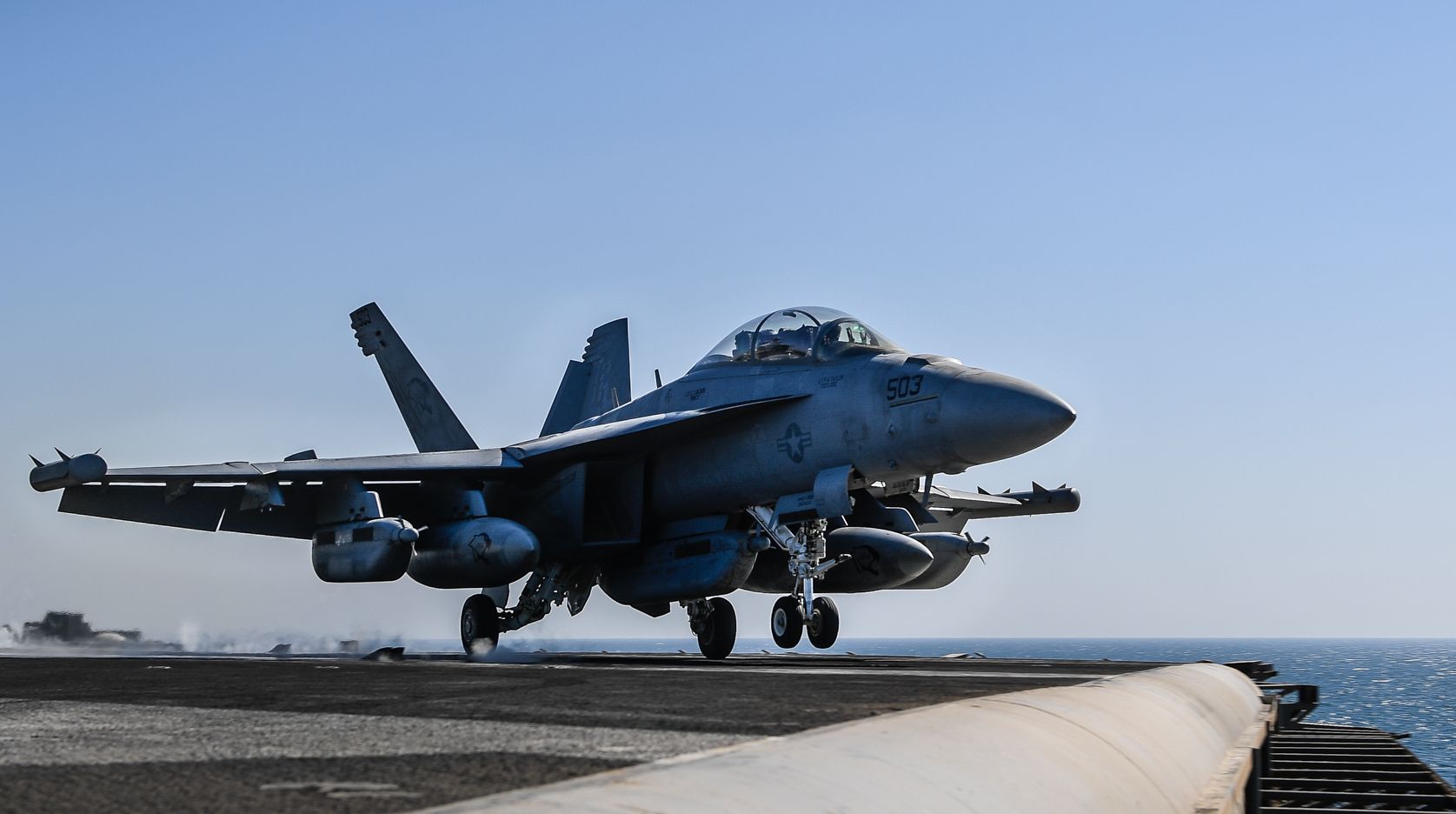
ARABIAN GULF (Feb. 4, 2018) A C-2A Greyhound, assigned to the Providers of Fleet Logistics Support Squadron (VRC) 30, takes off from the flight deck of the aircraft carrier USS Theodore Roosevelt (CVN 71). Theodore Roosevelt and its carrier strike group are deployed to the U.S. 5th Fleet area of operations in support of maritime security operations to reassure allies and partners and preserve the freedom of navigation and the free flow of commerce in the region. (U.S. Navy photo by Mass Communication Specialist 3rd Class Spencer Roberts/Released)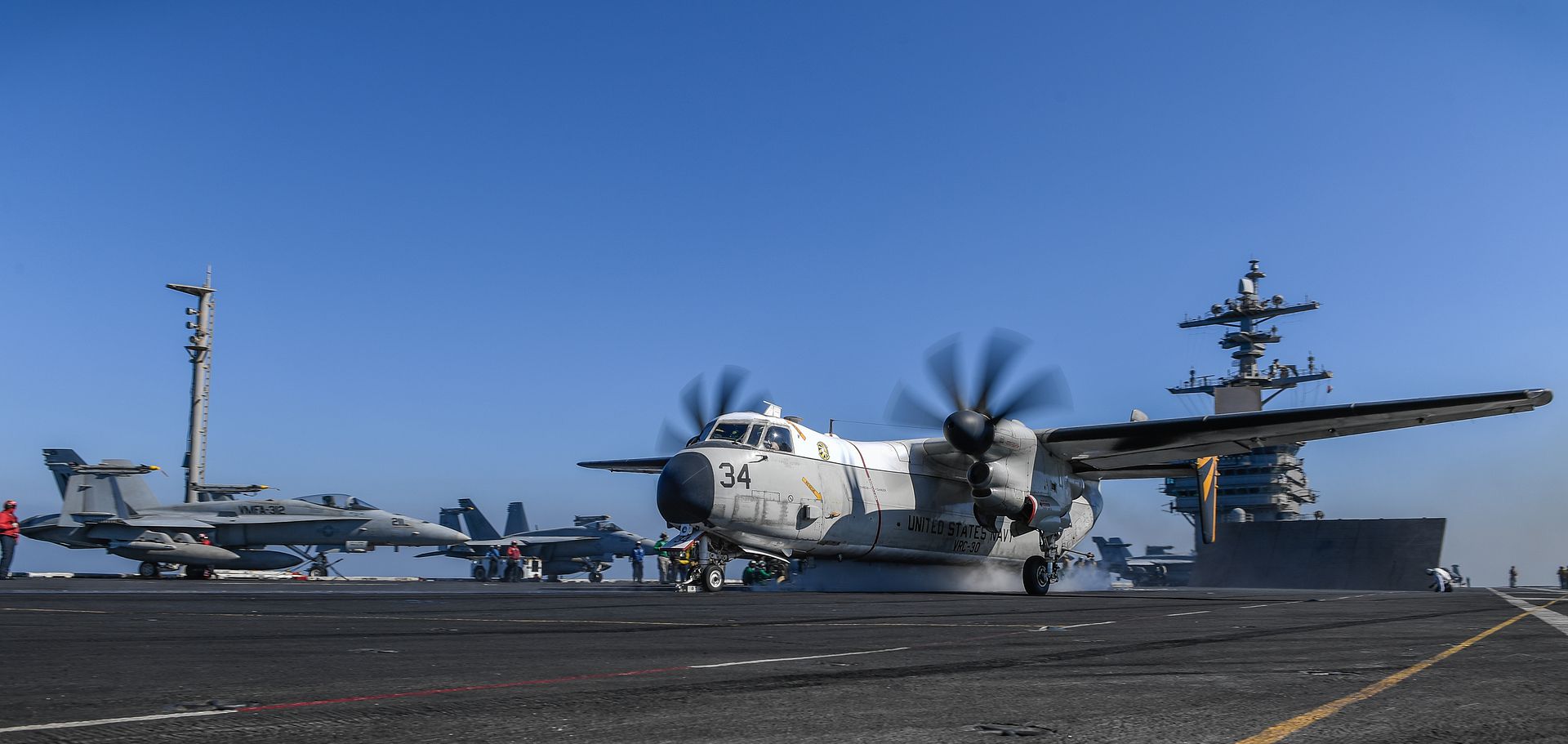
ARABIAN GULF (Feb. 5, 2018) An F/A-18C Hornet, assigned to the Checkerboards of Marine Strike Fighter Attack Squadron (VMFA) 312, prepares to launch from the flight deck of the aircraft carrier USS Theodore Roosevelt (CVN 71). Theodore Roosevelt and its carrier strike group are deployed to the U.S. 5th Fleet area of operations in support of maritime security operations to reassure allies and partners and preserve the freedom of navigation and the free flow of commerce in the region. (U.S. Navy photo by Mass Communication Specialist 3rd Class Alex Corona/Released)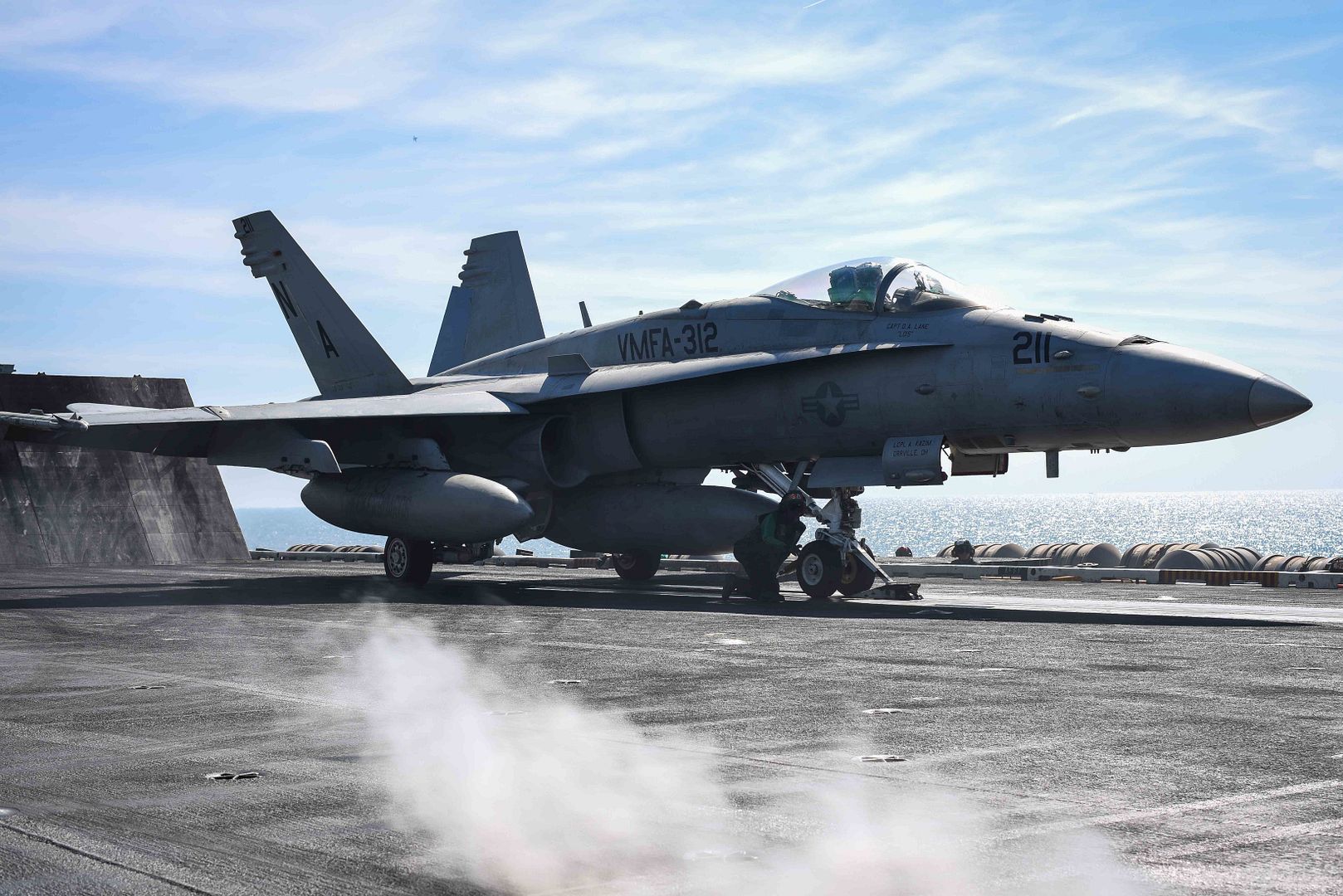
ARABIAN GULF (Feb. 5, 2018) An F/A-18F Super Hornet, assigned to the Mighty Shrikes of Strike Fighter Attack Squadron (VFA) 94, lands on the flight deck of the aircraft carrier USS Theodore Roosevelt (CVN 71). Theodore Roosevelt and its carrier strike group are deployed to the U.S. 5th Fleet area of operations in support of maritime security operations to reassure allies and partners and preserve the freedom of navigation and the free flow of commerce in the region. (U.S. Navy photo by Mass Communication Specialist 3rd Class Spencer Roberts/Released)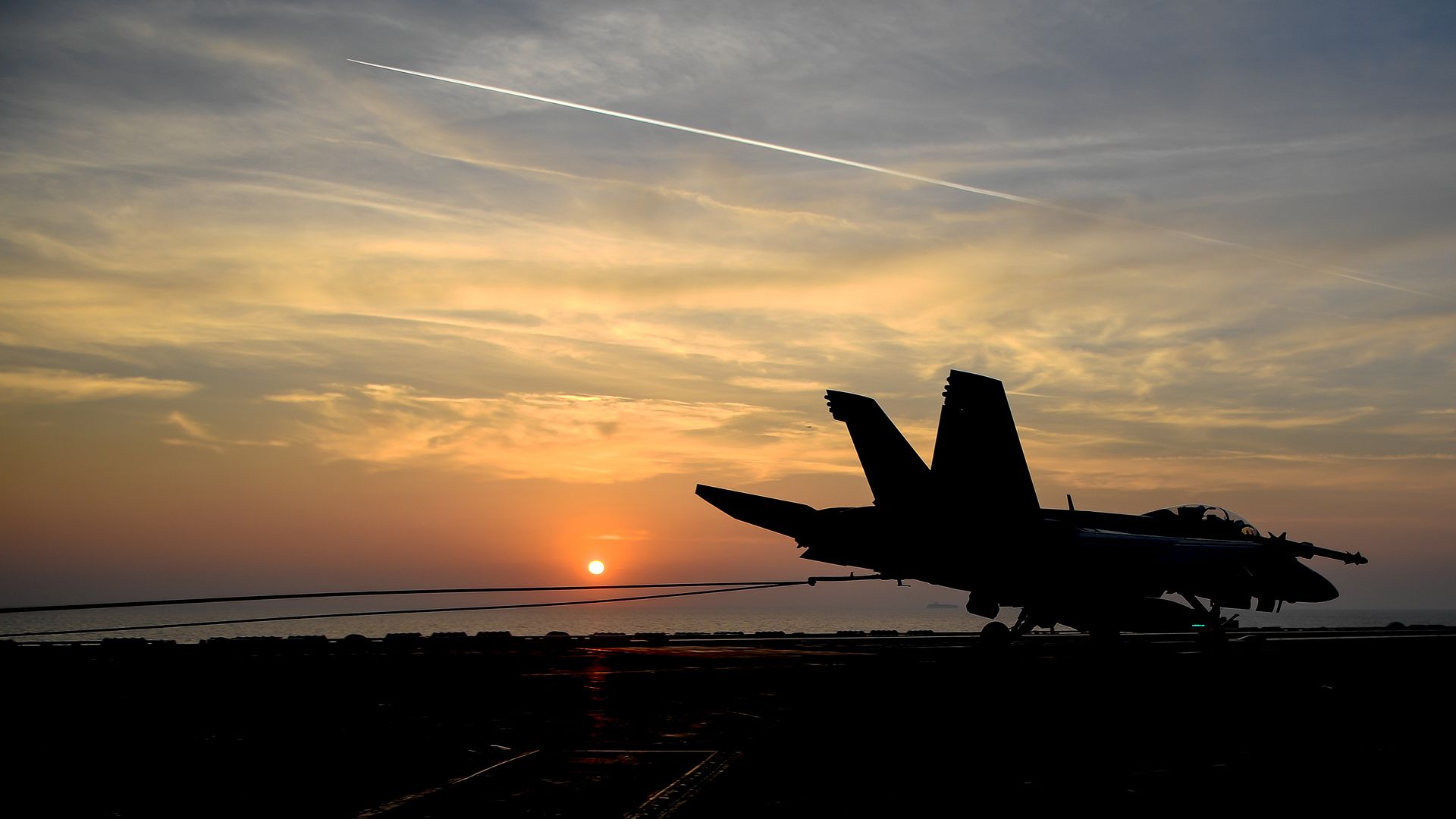
ARABIAN GULF (Feb. 5, 2018) An F/A-18E Super Hornet, assigned to the Stingers of Strike Fighter Attack Squadron (VFA) 113, launches from the flight deck of the aircraft carrier USS Theodore Roosevelt (CVN 71). Theodore Roosevelt and its carrier strike group are deployed to the U.S. 5th Fleet area of operations in support of maritime security operations to reassure allies and partners and preserve the freedom of navigation and the free flow of commerce in the region. (U.S. Navy photo by Mass Communication Specialist 3rd Class Spencer Roberts/Released)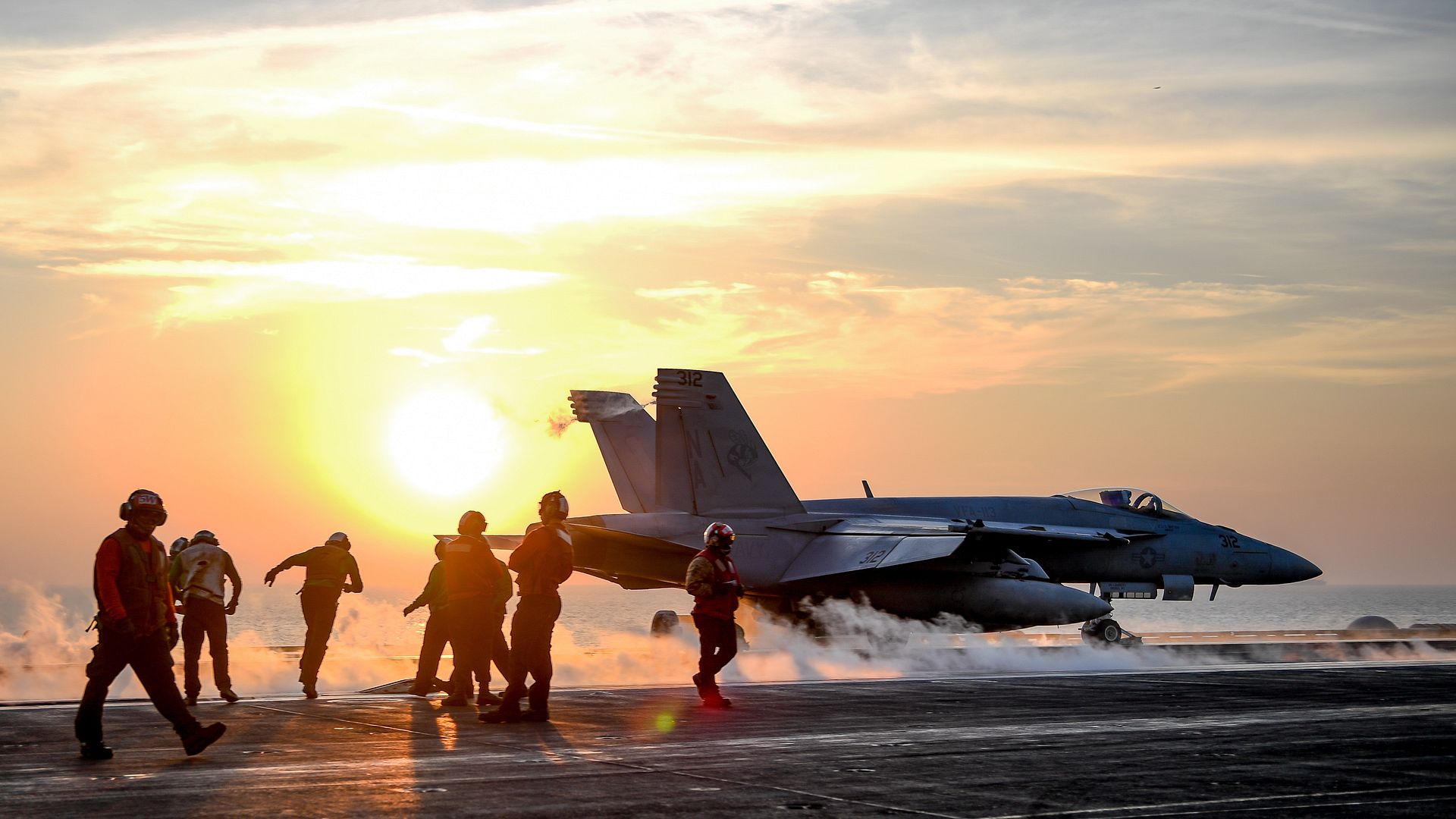
SINGAPORE, Feb. 5, 2018 /PRNewswire/ -- Sikorsky, a Lockheed Martin (NYSE: LMT) company, has completed qualification to military standards of a comprehensive weapons system for S-70M / S-70i? Black Hawk helicopters. Fully integrated with the aircraft's existing avionics, the system allows either pilot to place munitions quickly from forward firing guns, rocket pods and laser-designated air-to-ground missile launchers onto static or moving targets with high accuracy.
"Sikorsky has vastly simplified the complex task of placing rounds onto a target from standoff distances by calculating the complex ballistics required for effective airborne gunnery," said Bill Gostic, Sikorsky vice president of Global Military Systems & Services. "Once the weapons interfaces and electro-optical infrared sensor are integrated with the Black Hawk helicopter's existing controls and displays, international militaries can add external wings and weapons of choice in less than three hours to perform a range of medium attack missions."
In 2017, Sikorsky concluded a six-year development program of the weapons system, including two years of live fire tests at the U.S. Army's Yuma Proving Ground in Arizona. Sikorsky's independent Qualification Assurance Board recently verified and validated the weapons system's effectiveness and conformance to operational safety, airworthiness and firing accuracy.
Weapons are carried by two external wings supporting four weapons stations, which can support any combination of fixed forward 50-cal (12.7mm) gun, 7- or 19-shot Hydra 70 rocket pods, or Hellfire? air-to-ground missiles. Additionally, the qualified configuration features pilot-controlled fixed forward or crew served flex fire 7.62-mm mini-guns mounted to both cabin windows.
Once integrated for weapons delivery, the armed Black Hawk aircraft can be configured to perform a variety of medium attack missions:
Attack, armed escort, fire suppression: Carry full external weapons load, with ammunition pallets and auxiliary fuel tank inside the cabin
Troop transport and assault: Seat up to 10 troops and two window gunners with external wings (no ammunition pallets inside the cabin)
Anti-armor: Carry up to 16 laser guided missiles.
To engage with guns and rockets, the weapons system presents continuously updated targeting symbology to each pilot's helmet mounted display. By following the cues on the display, the pilot can maneuver the aircraft and engage the target. The system also provides target designation for laser-guided HELLFIRE missiles.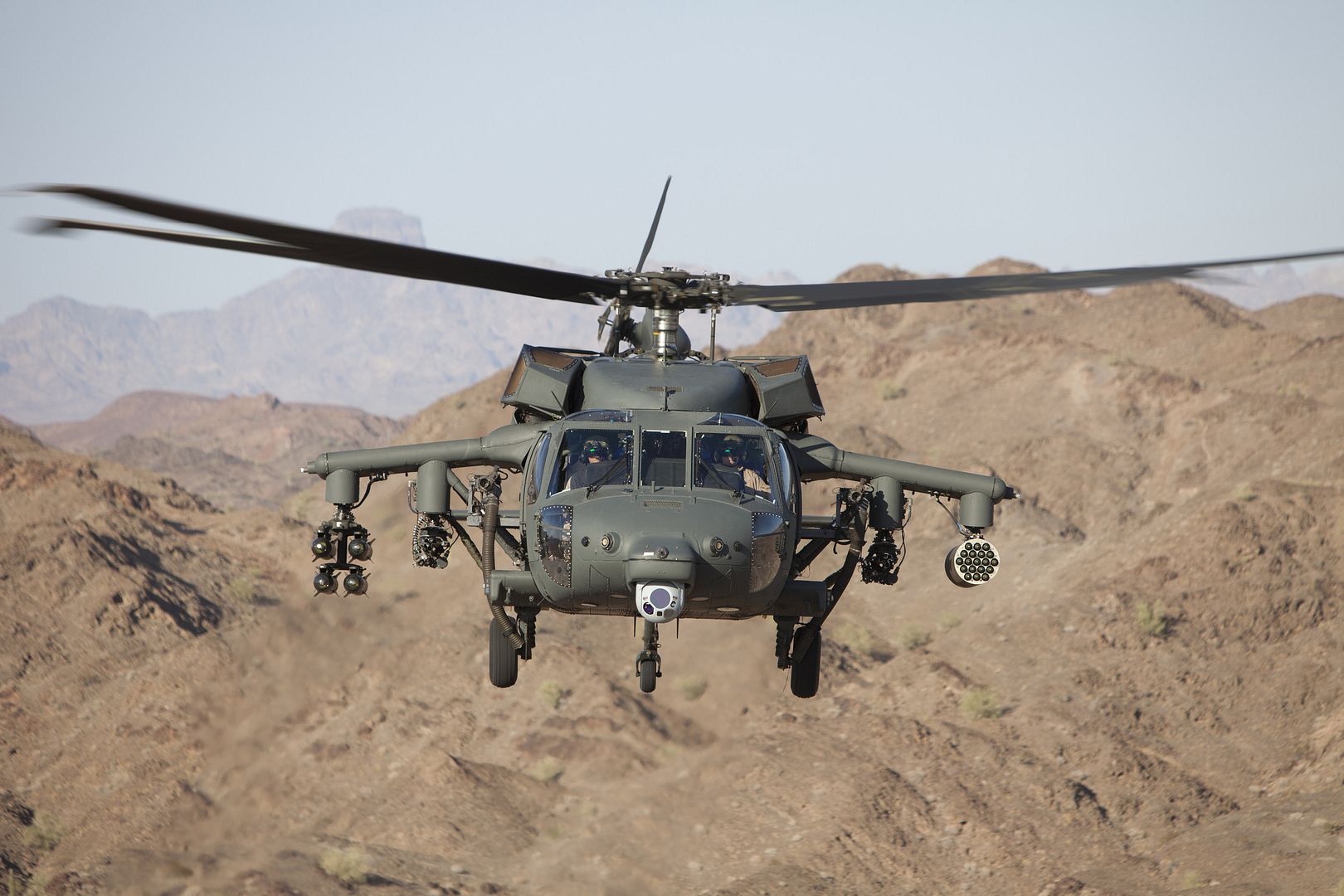
RENTON, Wash., Feb. 5, 2018 /PRNewswire/ -- Boeing [NYSE: BA] marked another airplane development milestone today as thousands of employees celebrated the debut of the first 737 MAX 7 at the company's Renton, Wash. factory.
The first Boeing 737 MAX 7 made its debut today at the company's Renton, Wash. factory. Photo by Craig Larsen. (PRNewsfoto/Boeing)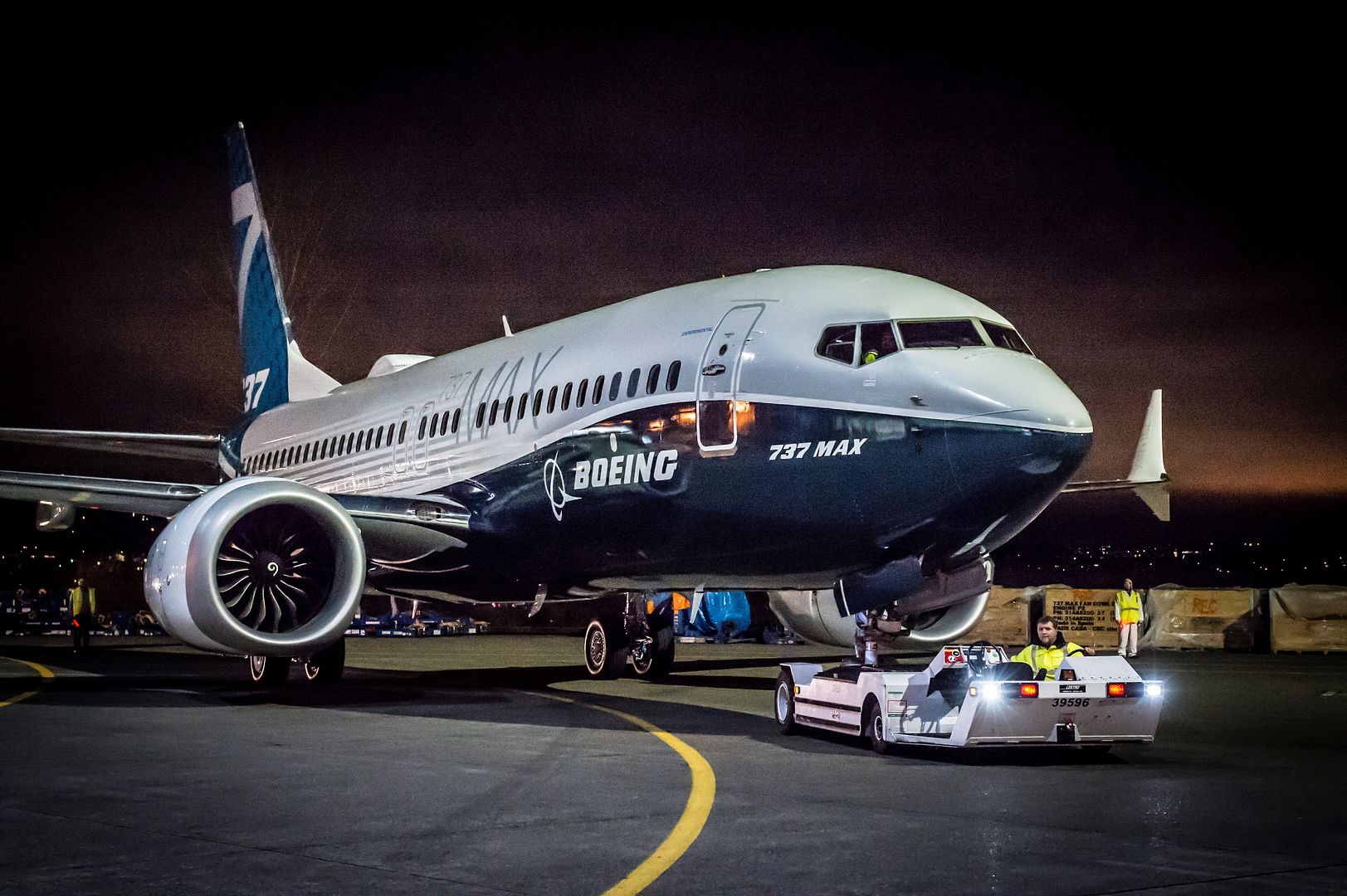
The MAX 7 is the third and newest member of Boeing's 737 MAX family to come down the assembly line. The jet is designed for up to 172 passengers and a maximum range of 3,850 nautical miles, which is the longest range of the MAX airplane family.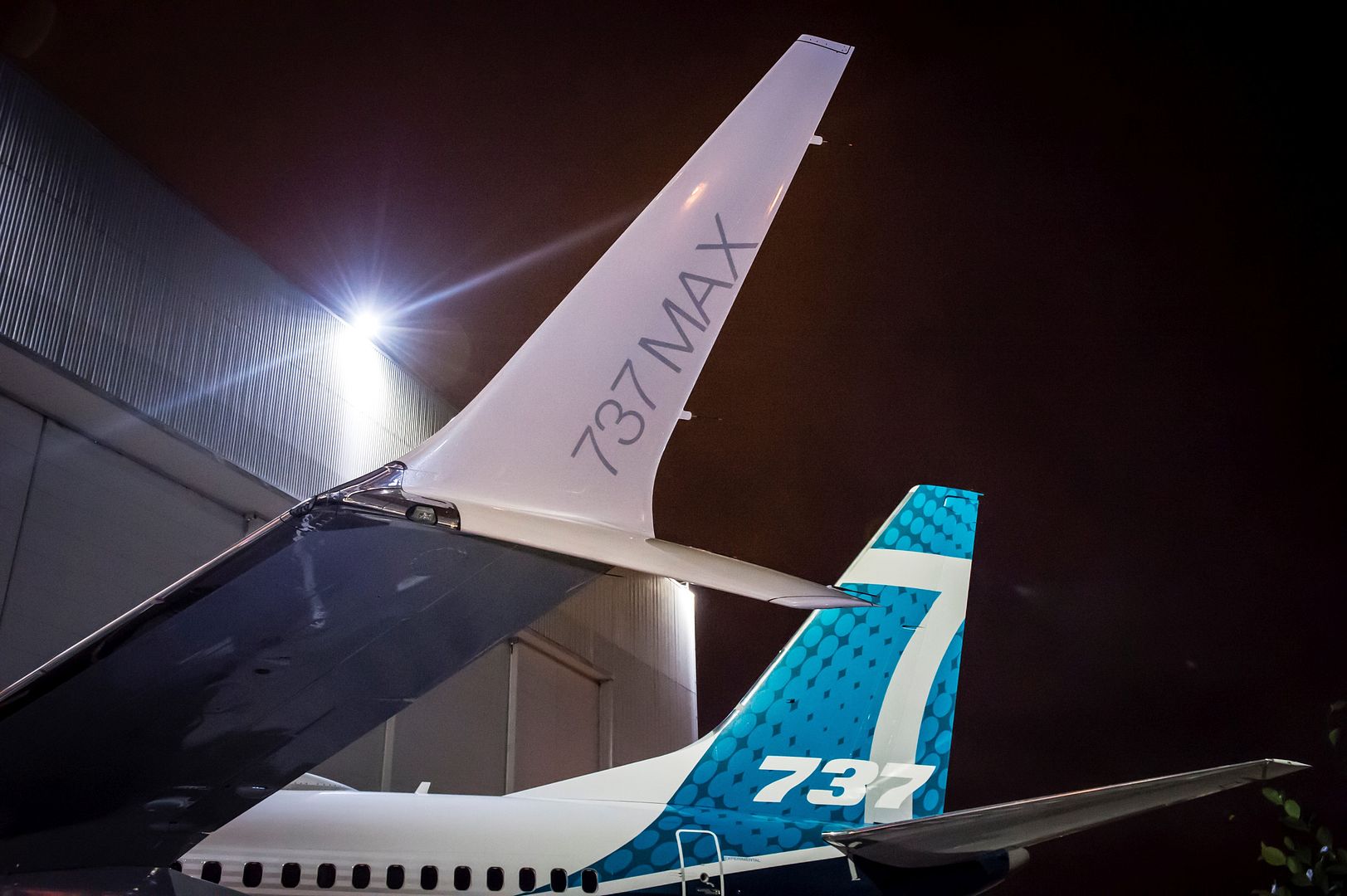
Technology improvements allow the MAX 7 to fly 1,000 nautical miles farther and carry more passengers than its predecessor, the 737-700, while having 18 percent lower fuel costs per seat.
The MAX 7 is also superior to the competition, carrying 12 more passengers 400 nautical miles farther than the A319neo, on 7 percent lower operating costs per seat.
"For our airline customers serving airports at high altitudes or remote locations, the MAX 7 is the ideal complement to their fleet. We look forward to demonstrating the incredible flexibility and range of this airplane," said Keith Leverkuhn, vice president and general manager of the 737 MAX program, Boeing Commercial Airplanes. "This is the third 737 MAX family member our team has successfully introduced in just three years. That's a phenomenal accomplishment and a testament to the dedication of the entire 737 team."
The first MAX 7 will now undergo system checks, fueling and engine runs on the flight line in Renton. The airplane, the first of two MAX 7 flight test airplanes, will begin its flight testing program in the coming weeks.
The 737 MAX 7 is scheduled to enter service in 2019, following delivery to launch customer Southwest Airlines.
The entire 737 MAX family is designed to offer customers exceptional performance, with lower per-seat costs and an extended range that will open up new destinations in the single-aisle market. The MAX 8 entered service with customers across the globe last year, and the MAX 9 will start deliveries in the coming months. The MAX 10 was launched at last year's Paris Air Show and is scheduled to enter service in the 2020 timeframe.
The 737 MAX is the fastest-selling airplane in Boeing history, accumulating more than 4,300 orders from 92 customers worldwide. For more information and feature content, visit www.boeing.com/commercial/737max.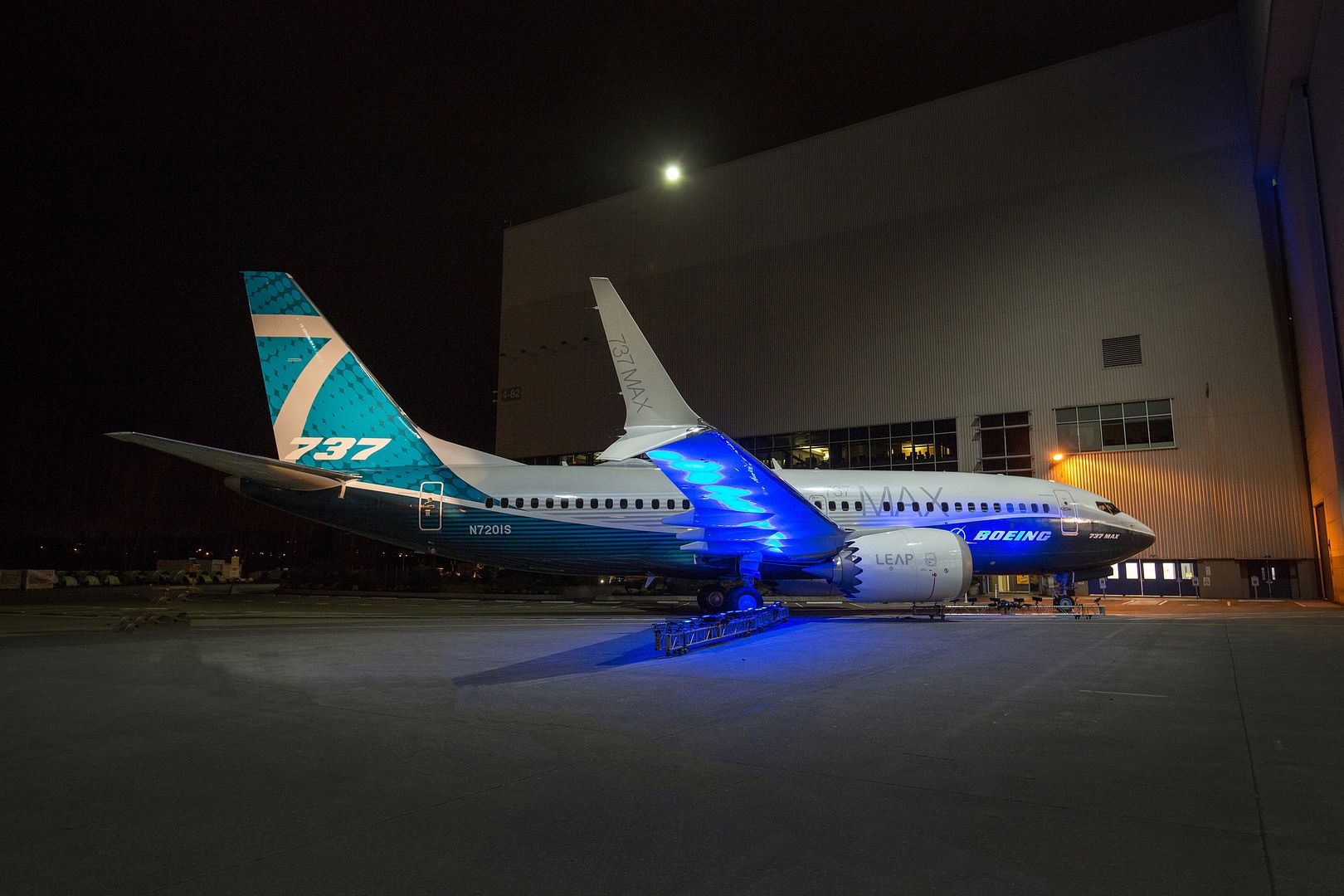
The newest member of the A330neo Family, the A330-800, has rolled out of the paintshop, on track for its first flight in mid-2018.
The A330-800 is the new generation 250-seater from Airbus? leading twin-aisle family. With its 242-tonne Maximum Take-Off Weight (MTOW) as the base variant, the A330-800 can operate routes of up to 7,500nm and with the recently launched 251-tonne MTOW variant, the aircraft can operate ultra-long-range routes of up to 8,150nm. The A330-800 will leverage the A330-200?s proven versatility, popularity and reasons for success, offering new-generation economics.
Building on the success of the A330-200 with over 600 aircraft in operation, the A330-800 brings new-generation economics and comfort in addition to unprecedented range to the 250-seat aircraft market. Together with the larger 300-seat A330-900, they share 99 percent commonality, having the same airframe, engines and cross-crew training. This gives operators great flexibility to use either aircraft in their fleet according to network needs in size and range. Both of these widebody aircraft incorporate new Rolls-Royce Trent 7000 engines, zero-splice nacelles, titanium pylons, new wings and new Airspace by Airbus cabins. The most visible new features of the A330neo wings are the specially developed curved wingtip Sharklets ? which draw on A350 XWB technology, extending the wingspan to 64 metres, providing state-of-the art aerodynamic characteristics.
Airlines will benefit from 25 percent less fuel burn per seat compared to previous-generation competitors, reduced maintenance costs and the A330?s market-leading 99.5 percent operational reliability. Passengers will enjoy the award-winning all new Airspace cabin inspired by the A350 XWB. On top of latest generation in-flight entertainment and connectivity, passengers can look forward to a new welcoming entrance area, spacious overhead bins, mood lighting and exceptionally quiet flights.
With over 1,700 orders, the A330 is the most popular widebody aircraft ever, having flown nearly one million annual flights. Today, close to 1,400 aircraft have been delivered to 118 customers worldwide on a wide range of routes, from domestic and regional flights to long-range intercontinental services. Offering the lowest operating costs in its category, and thanks to continuous investments in latest innovations, the new-generation A330neo will be the most profitable and best performing aircraft in its size category.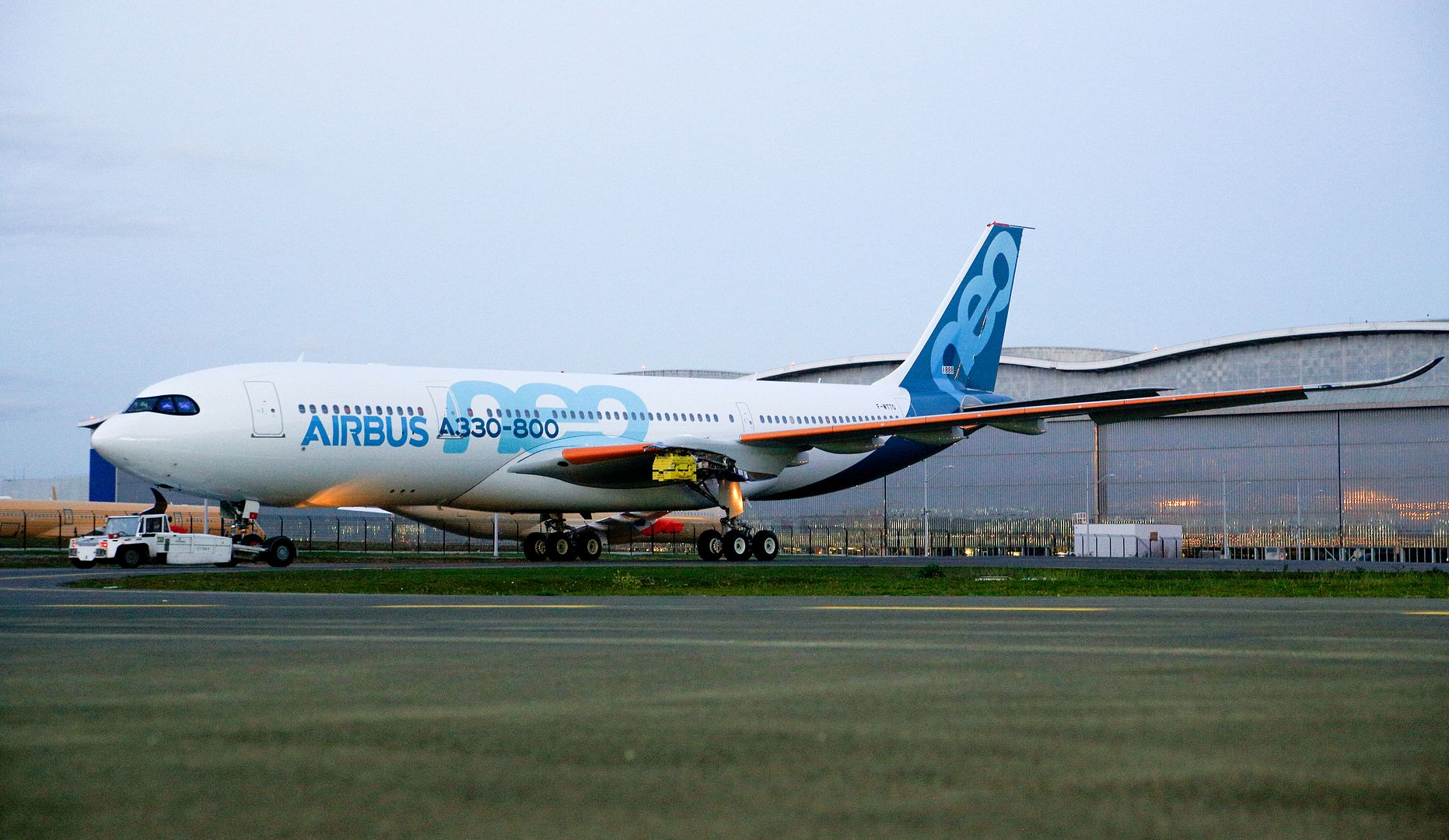
-
 Main AdminTwo U.S. Air Force F-22 Raptors fly above Syria in support of Operation Inherent Resolve, Feb. 2, 2018. The F-22 is an air superiority fighter that incorporates the latest technological advances in reduced observables, avionics, engine performance and aerodynamic design. (U.S. Air National Guard photo by Staff Sgt. Colton Elliott)
Main AdminTwo U.S. Air Force F-22 Raptors fly above Syria in support of Operation Inherent Resolve, Feb. 2, 2018. The F-22 is an air superiority fighter that incorporates the latest technological advances in reduced observables, avionics, engine performance and aerodynamic design. (U.S. Air National Guard photo by Staff Sgt. Colton Elliott)
A U.S. Air Force F-22 Raptor departs after receiving fuel from a KC-10 Extender during a mission in support of Operation Inherent Resolve over Syria, Feb. 2, 2018. The F-22, a critical component of the Global Strike Task Force, is designed to project air dominance, rapidly and at great distances and defeat threats attempting to deny access to our nation's Air Force, Army, Navy and Marine Corps. (U.S. Air National Guard photo by Staff Sgt. Colton Elliott)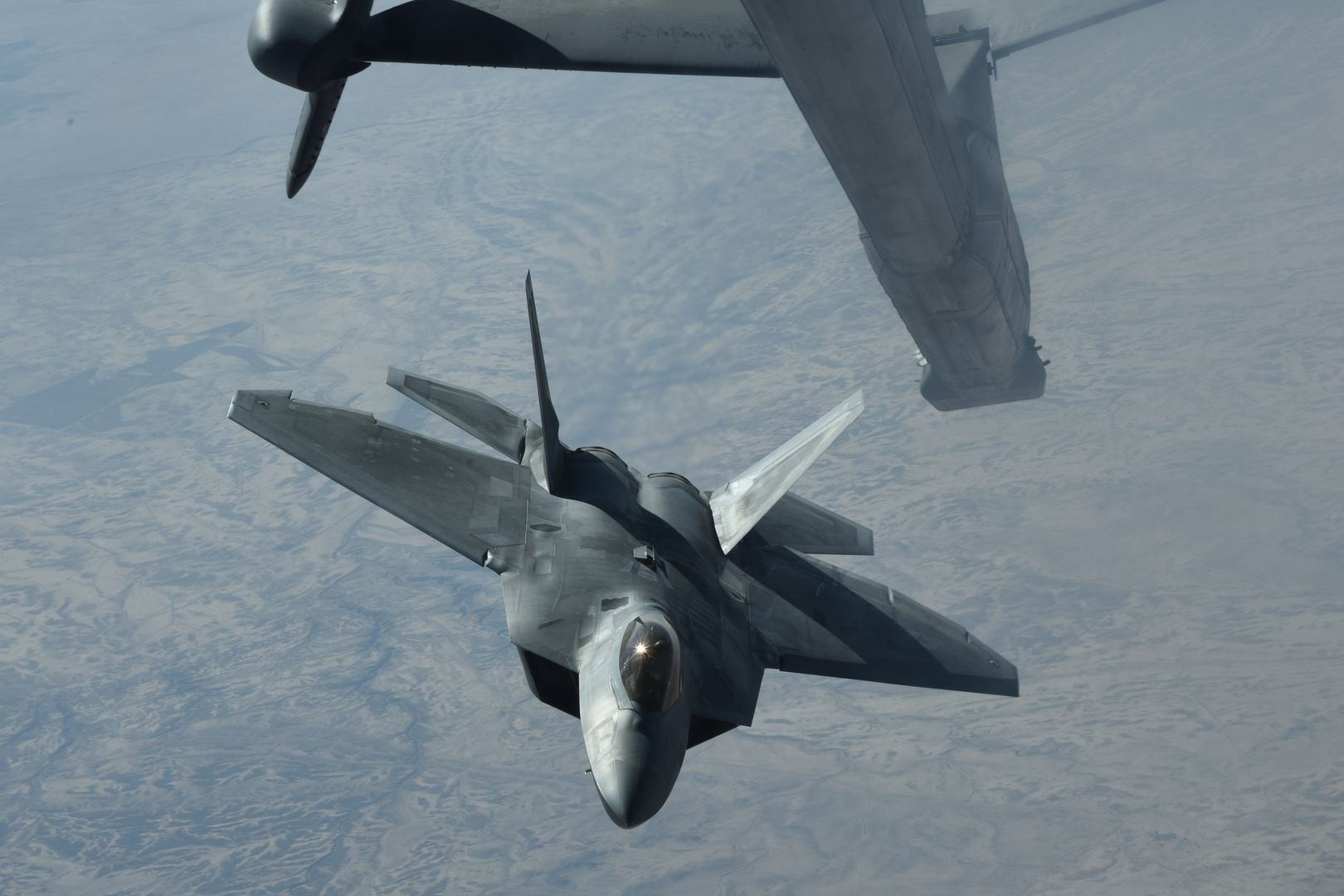
Air Force Two arrives at the 171st Air Refueling Wing near Pittsburgh Feb. 2, 2018. Vice President of the United States Michael R. Pence took time to shake hands and greet members of the 171st before his speech at the Bethel Park Community Center and Heinz History Center in Pittsburgh. (U.S. Air National Guard Photo by Senior Master Sgt. Shawn Monk)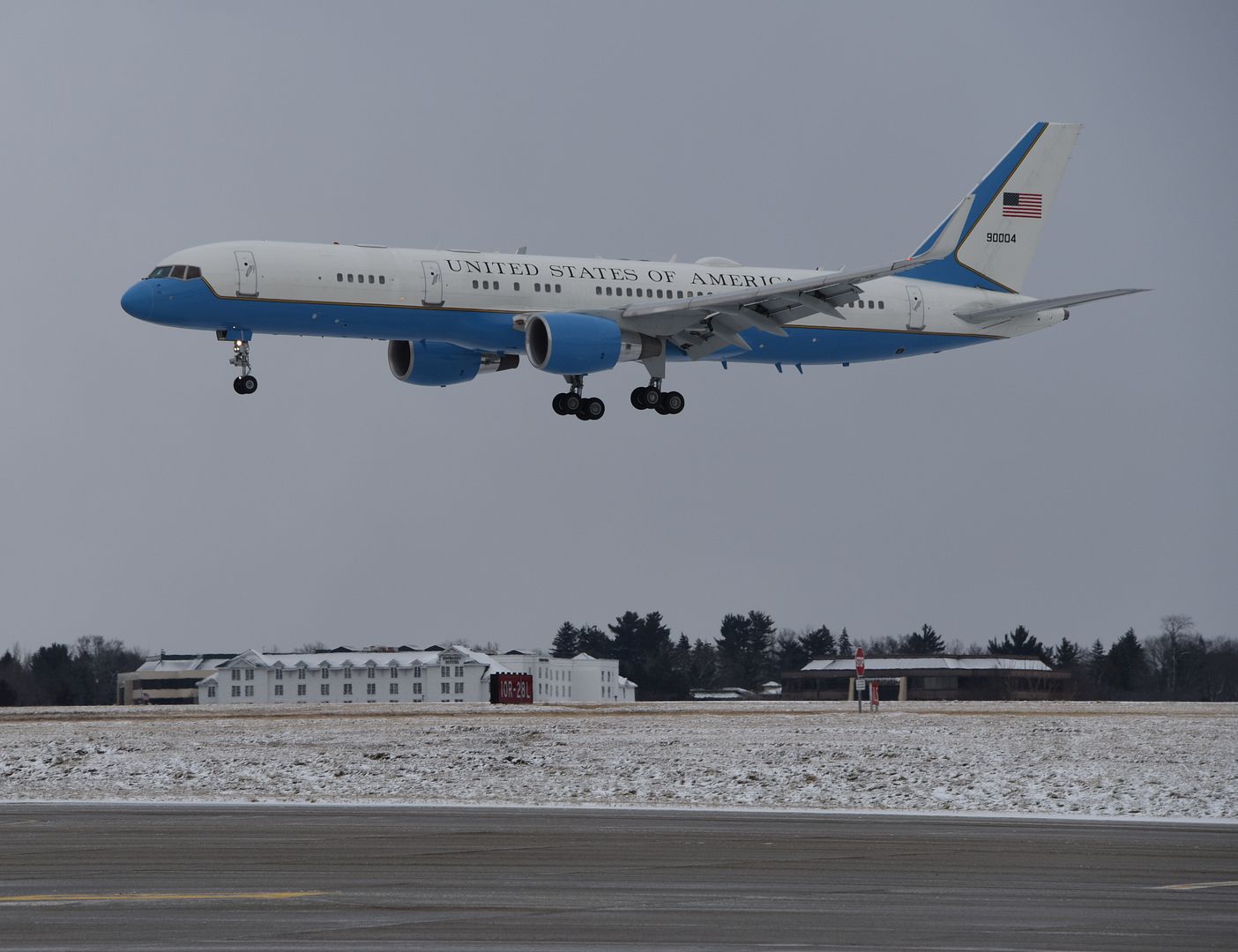
An A-10 Thunderbolt II fires it?s GAU-8 Avenger 30 mm cannon over the Barry M. Goldwater Range in Gila Bend, Ariz., Feb. 1, 2018. The A-10 is capable of firing 3,900 rounds per minute to defeat a wide variety of enemy targets. (U.S. Air Force photo/Airman 1st Class Caleb Worpel)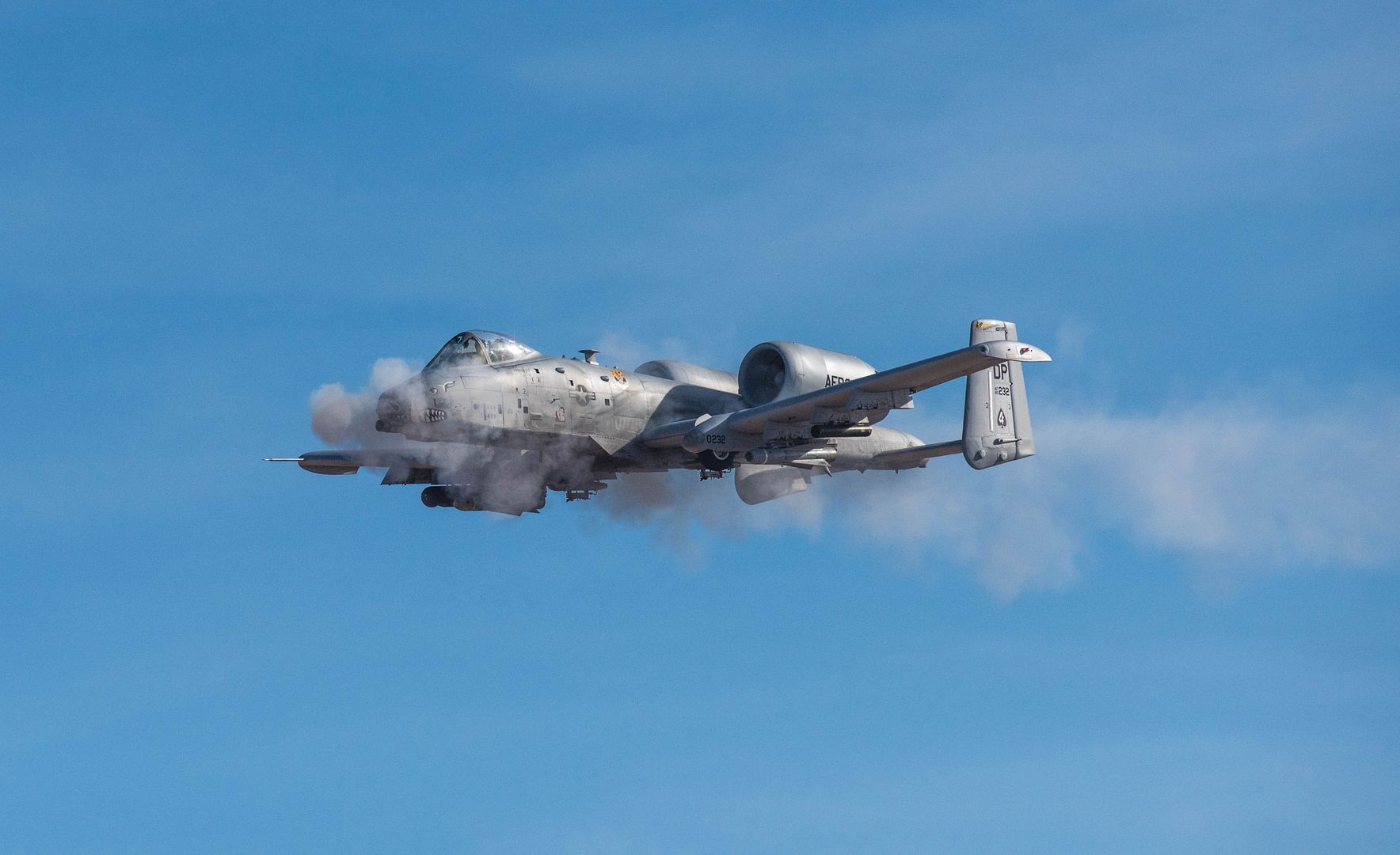
ATLANTIC OCEAN (Feb. 4, 2018) T-45C Goshawks assigned to Commander, Naval Air Training Detachment taxi on the flight deck of the Nimitz-class aircraft carrier USS Abraham Lincoln (CVN 72). (U.S. Navy photo by Mass Communication Specialist 3rd Class Jeffrey Sherman/Released)
ORLANDO, Fla., Feb. 6, 2018 /PRNewswire/ -- Lockheed Martin's (NYSE: LMT) Joint Air-to-Surface Standoff Missile (JASSM) ? Extended Range (ER) achieved full operational capability on the F-15E Strike Eagle, flown by the U.S. and allied nations' air forces.
With completion of integration and the fielding of JASSM-ER's Suite 8 Operational Flight Program, the F-15E Strike Eagle becomes the first Universal Armament Interface (UAI)-compliant platform to field JASSM-ER. UAI-compliant aircraft feature standardized interfaces to support future weapon integration.
"Fielding on the F-15E Strike Eagle expands JASSM-ER's mission flexibility," said Jeffrey Foley, program director of Long-Range Strike Systems at Lockheed Martin Missiles and Fire Control. "With its greater than 500 nautical-mile standoff range and planned block upgrades currently in work, JASSM-ER provides an impressive tactical advantage for U.S. and allied warfighters."
Baseline JASSM was the first missile ever to be integrated onto a UAI platform. The U.S. Air Force Seek Eagle Office led the F-15E Strike Eagle JASSM-ER and JASSM integration.
Armed with a penetrating blast-fragmentation warhead, JASSM-ER and JASSM can be used in all weather conditions. They share the same powerful capabilities and stealth characteristics, though JASSM-ER has more than two-and-a-half times the range of JASSM for greater standoff distance. These highly accurate cruise missiles also employ an infrared seeker and enhanced digital anti-jam GPS to dial into specific points on targets.
Effective against high-value, well-fortified, fixed and relocatable targets, JASSM-ER is also integrated on the B1-B and currently in the process of integration on the F-16C/D and the internal bay and wings of the B-52H. JASSM is integrated on the U.S. Air Force's B-1B, B-2,
B-52, F-16 and F-15E. Internationally, JASSM is carried on the F/A-18A/B, F-18C/D and F-16 Block 52 aircraft. Produced at the company's manufacturing facility in Troy, Alabama, more than 2,150 JASSMs have been delivered.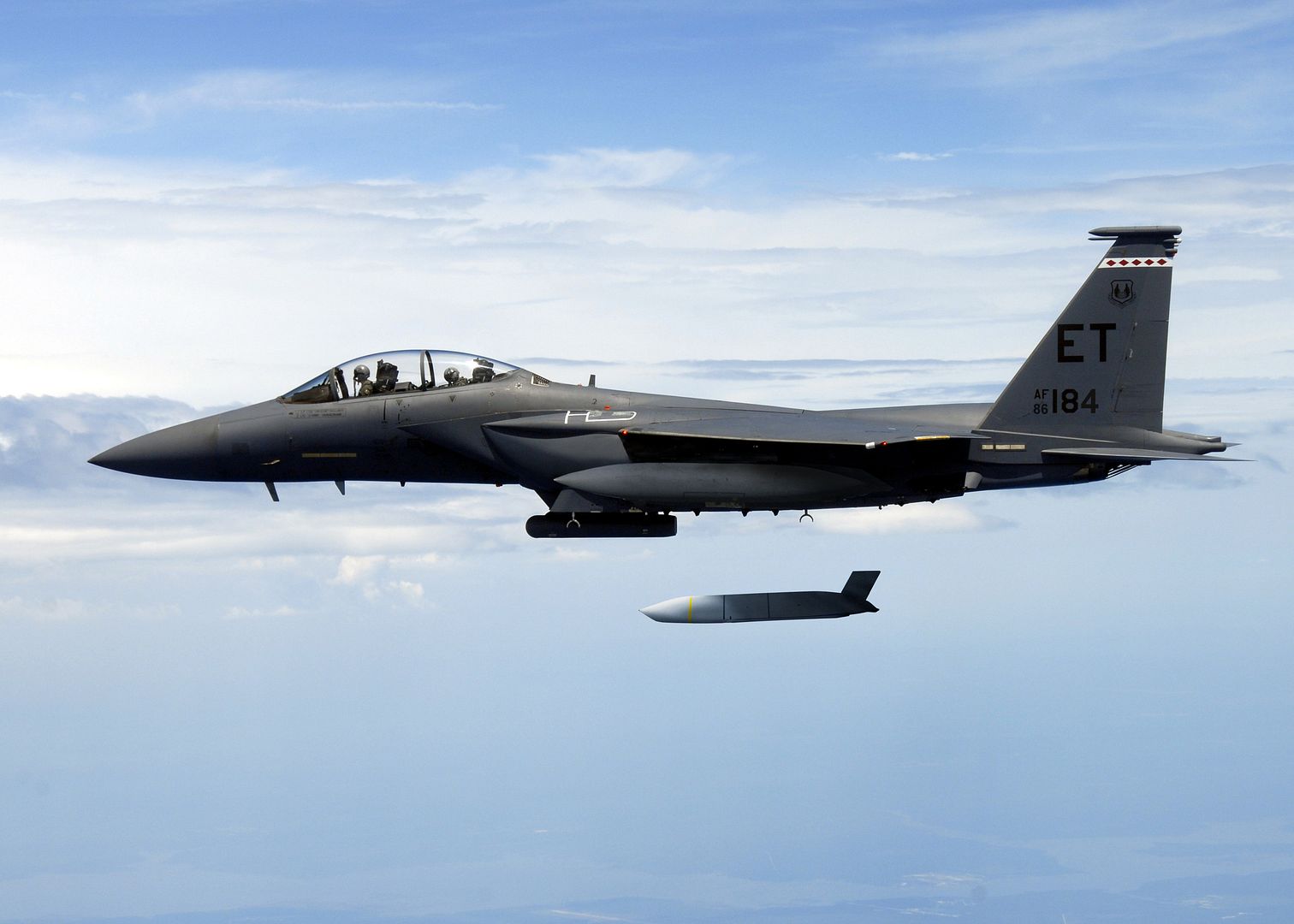
The Royal Air Force has declared the full operational capability for the RC-135 Airseeker/Rivet Joint ahead of schedule.
The Airseeker capability, which comprises the RC-135W Rivet Joint aircraft and a ground-based analysis unit, is already proven operationally. While supporting efforts against Daesh in the Middle East it has also contributed to the RAF?s wider Intelligence, Surveillance, Target Acquisition and Reconnaissance (ISTAR) Force which includes Sentry, Shadow, Sentinel and Reaper in addition to the reconnaissance capabilities of our fighter aircraft.
The Chief of the Air Staff, Air Chief Marshal Sir Stephen Hillier, said:
?The Royal Air Force's Airseeker/Rivet Joint system has achieved full operational capability. A vital part of our ISTAR Force, it provides critical information and understanding to decision-makers in an increasingly complex, congested and contested battlespace. It offers essential support not only to air power operations but also to every aspect of joint capability across Defence, and in concert with our allies.?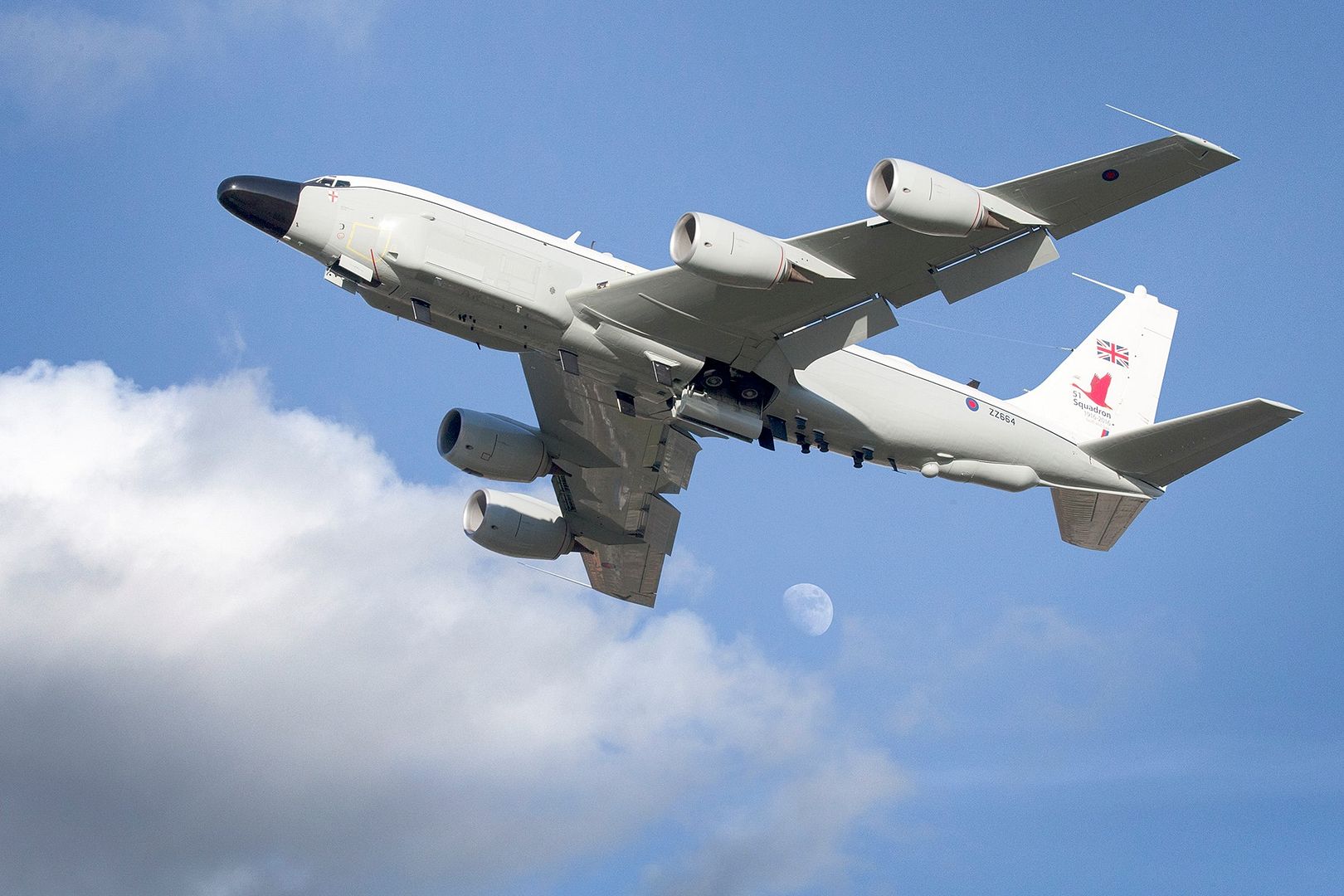
-
 Main AdminA Coast Guard C-27J aircrew, assigned to Coast Guard Air Station Sacramento, flies over San Francisco, Calif., during an area of familiarization training, Monday, Feb. 6, 2018. The C-27Js are outfitted with weather radar and communications equipment capable of supporting transport and other Coast Guard missions. Coast Guard photo's by Lt. Scott Handlin
Main AdminA Coast Guard C-27J aircrew, assigned to Coast Guard Air Station Sacramento, flies over San Francisco, Calif., during an area of familiarization training, Monday, Feb. 6, 2018. The C-27Js are outfitted with weather radar and communications equipment capable of supporting transport and other Coast Guard missions. Coast Guard photo's by Lt. Scott Handlin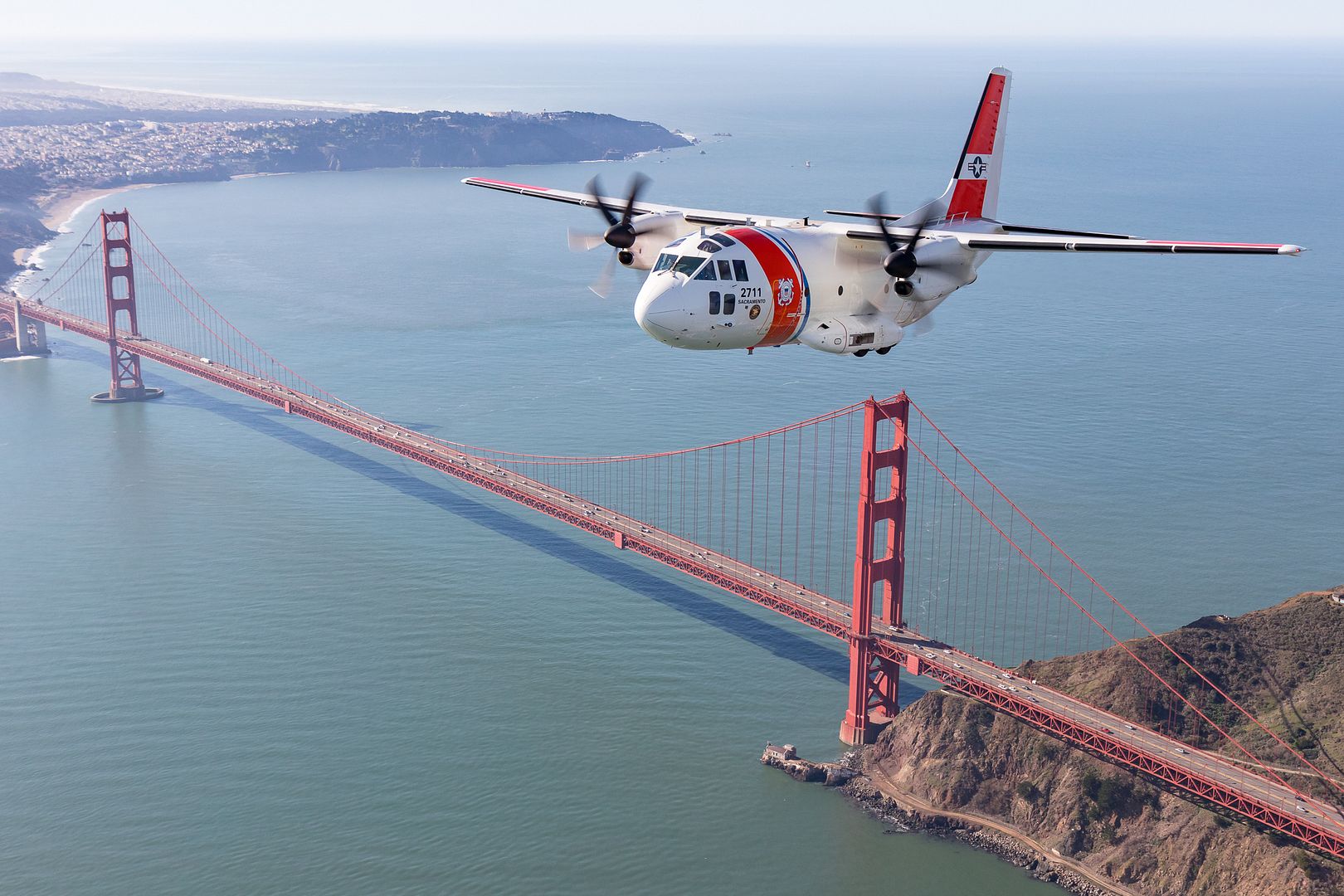
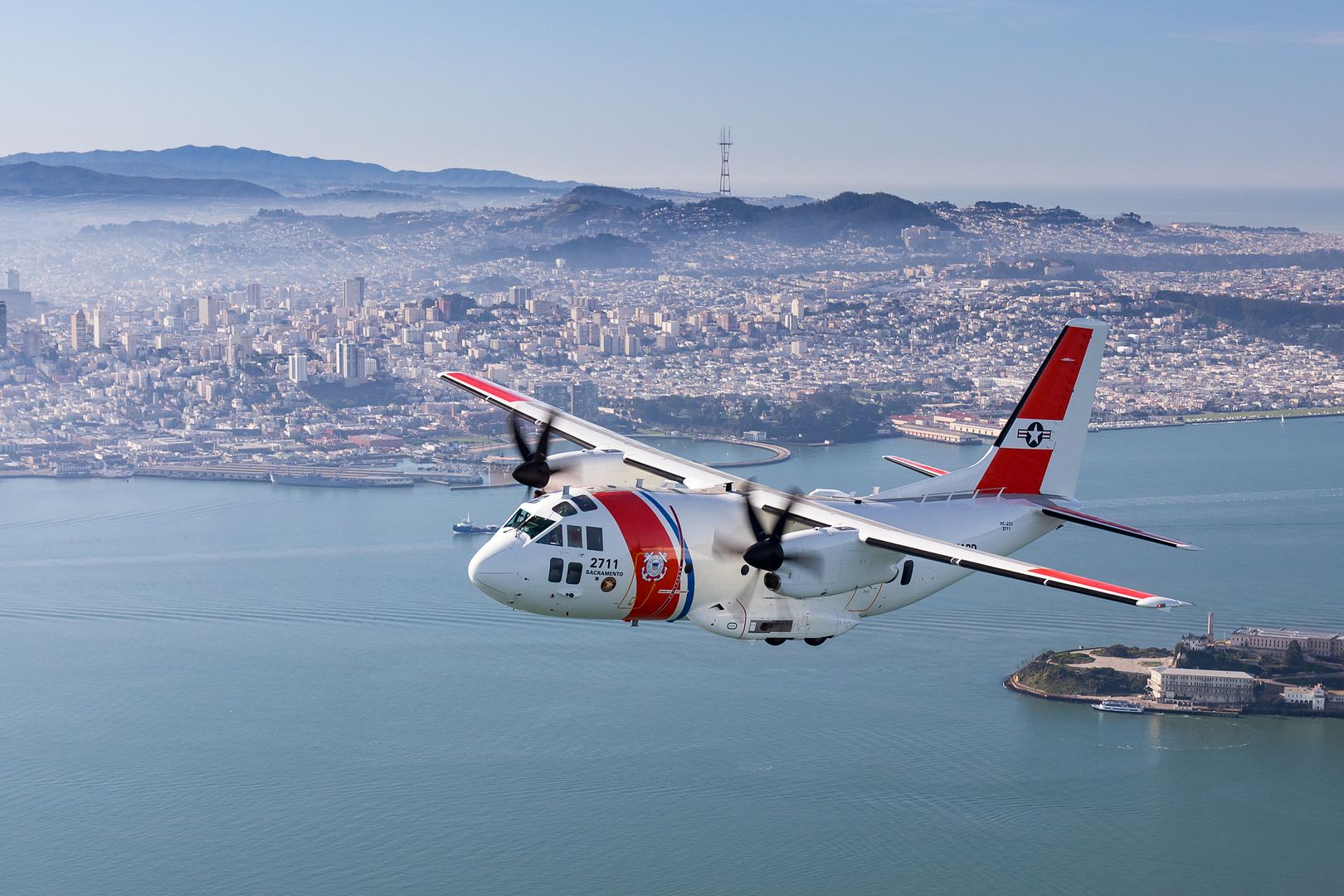
A Coast Guard C-27J aircrew, assigned to Coast Guard Air Station Sacramento, flies over Yosemite National Park, Calif., during an area of familiarization training, Monday, Feb. 6, 2018. The C-27Js are outfitted with weather radar and communications equipment capable of supporting transport and other Coast Guard missions. Coast Guard photo by Lt. Scott Handlin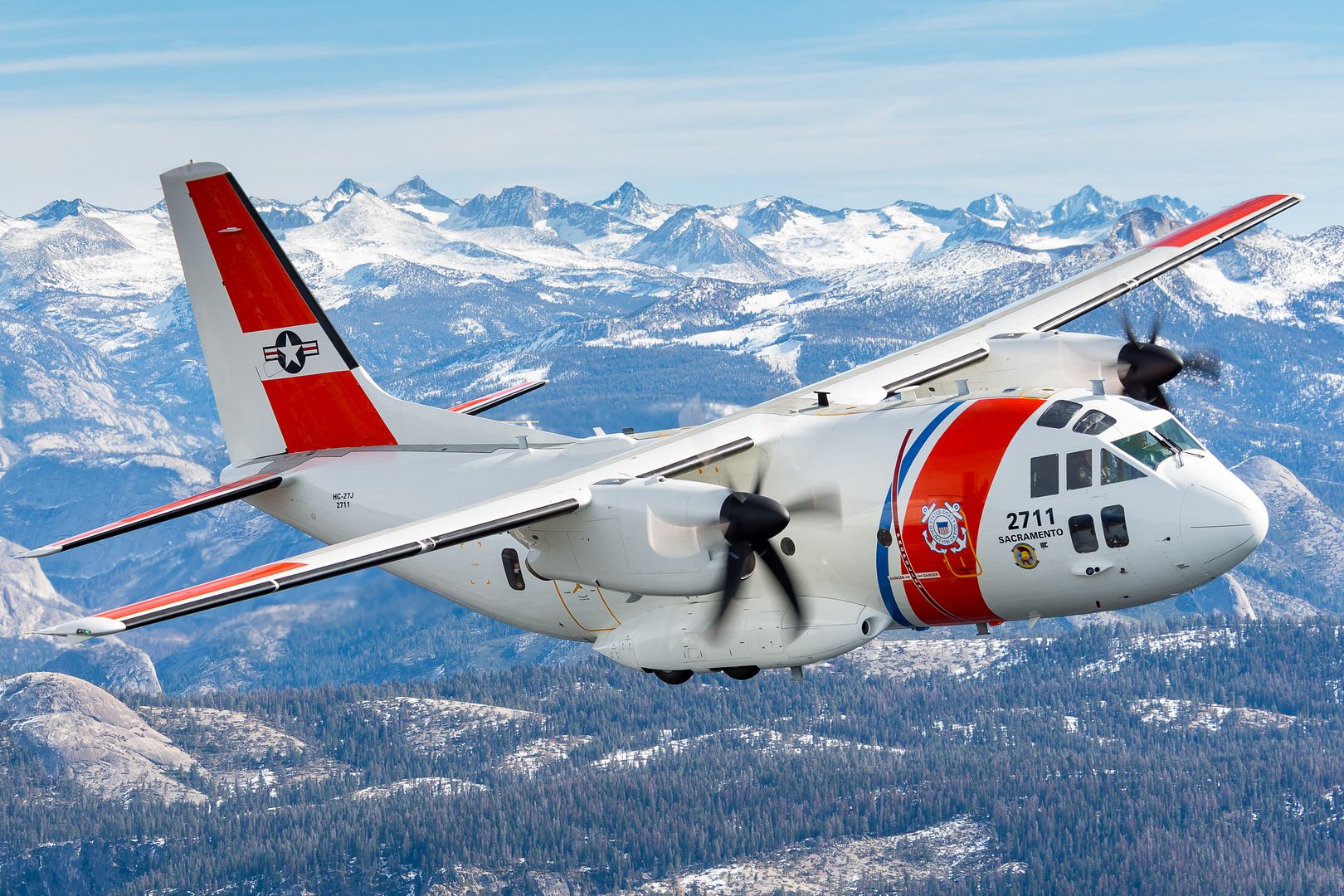
ARABIAN GULF (Feb. 6, 2018) A C-2A Greyhound, assigned to the Providers of Fleet Logistics Support Squadron (VRC) 30, lands on the flight deck of the aircraft carrier USS Theodore Roosevelt (CVN 71). Theodore Roosevelt and its carrier strike group are deployed to the U.S. 5th Fleet area of operations in support of maritime security operations to reassure allies and partners and preserve the freedom of navigation and the free flow of commerce in the region. (U.S. Navy photo by Mass Communication Specialist 3rd Class Spencer Roberts/Released)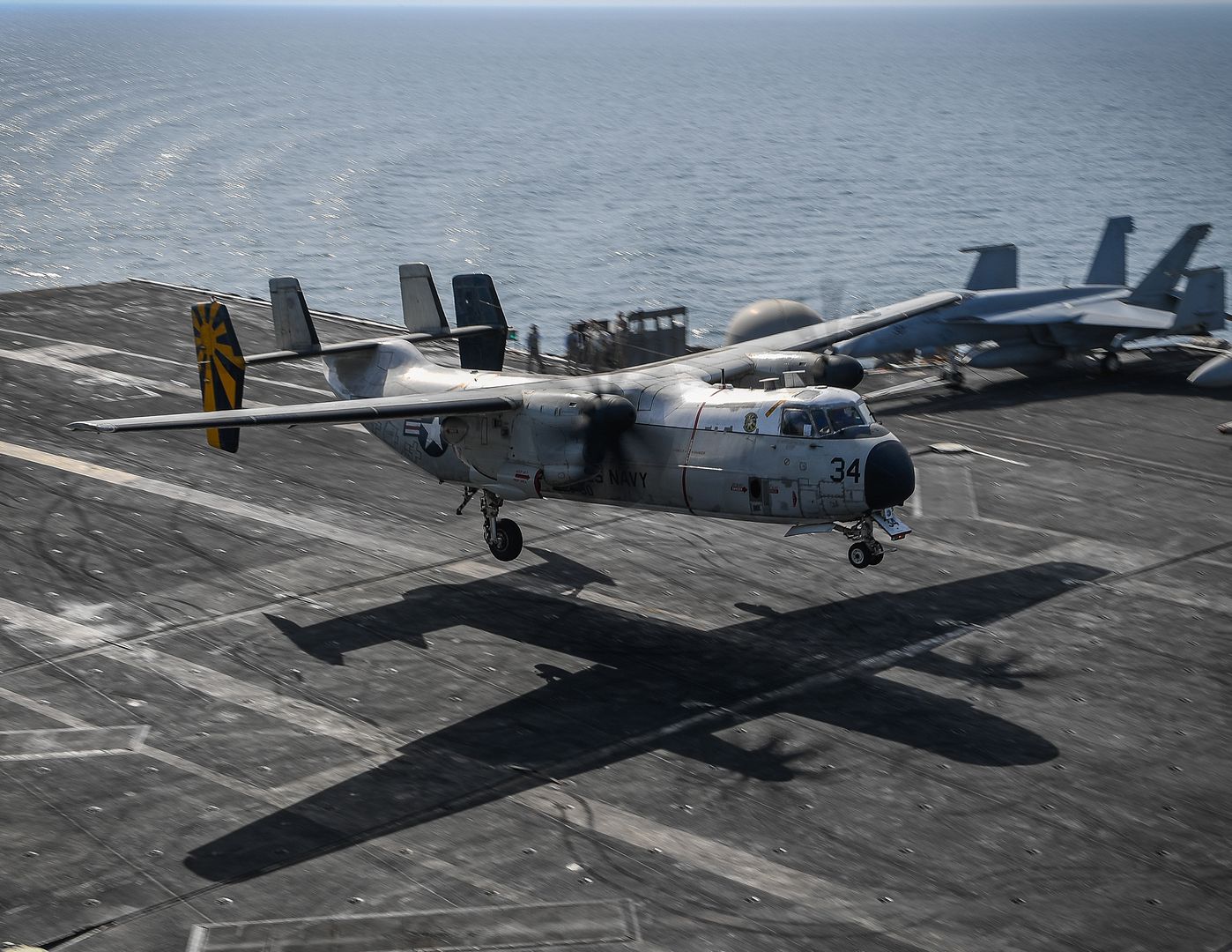
ATLANTIC OCEAN (Feb. 5, 2018) A T-45C Goshawk assigned to Commander, Naval Air Training Detachment prepares to land on the flight deck of the Nimitz-class aircraft carrier USS Abraham Lincoln (CVN 72). (U.S. Navy photo by Mass Communication Specialist 3rd Class Jacob Smith/Released)
SINGAPORE, Feb. 6, 2018 /PRNewswire/ -- Boeing's [NYSE: BA] 737 MAX 10 has reached a major milestone as the MAX program completed firm configuration on the airplane. This means engineers now have all the design requirements in place for what will be the largest member of Boeing's single-aisle family. Boeing announced the achievement today at the Singapore Airshow.
"The steps we've taken to reach this point ensure the MAX 10 will be the most efficient and profitable single-aisle airplane the market has ever seen," said Randy Tinseth, vice president of Marketing, Boeing Commercial Airplanes. "We're working closely with our airline customers to deliver on the performance and efficiency benefits we've promised."
The 737 MAX 10, which will use a stretched fuselage that is 66 inches longer than the 737 MAX 9, now moves into the detailed design phase prior to the start of production. The airplane will carry up to 230 passengers, delivering 5 percent lower trip costs and 5 percent lower seat-mile costs compared to its competition.
The MAX 10 is coming off a strong launch at the 2017 Paris Air Show. The airplane now has more than 416 orders and commitments from 18 customers across the globe. Deliveries are scheduled to begin in the 2020 timeframe.
The MAX 10 will soon join the rest of the 737 MAX family. The first MAX 7 rolled out of the paint hangar earlier this week and will soon start flight tests. The MAX 8 has been in service since 2017, already carrying more than 1.8 million passengers. And the first MAX 9 is scheduled to be delivered in the coming weeks.
The 737 MAX family is designed to offer customers exceptional performance, with lower per-seat costs and an extended range that will open up new destinations in the single-aisle market. The 737 MAX incorporates the latest CFM International LEAP-1B engines, Advanced Technology winglets, Boeing Sky Interior, large flight deck displays and other features to deliver the highest efficiency, reliability and passenger comfort in the single-aisle market.
The 737 MAX is the fastest-selling airplane in Boeing history, accumulating more than 4,300 orders from 92 customers worldwide. For more information and feature content, visit www.boeing.com/commercial/737max.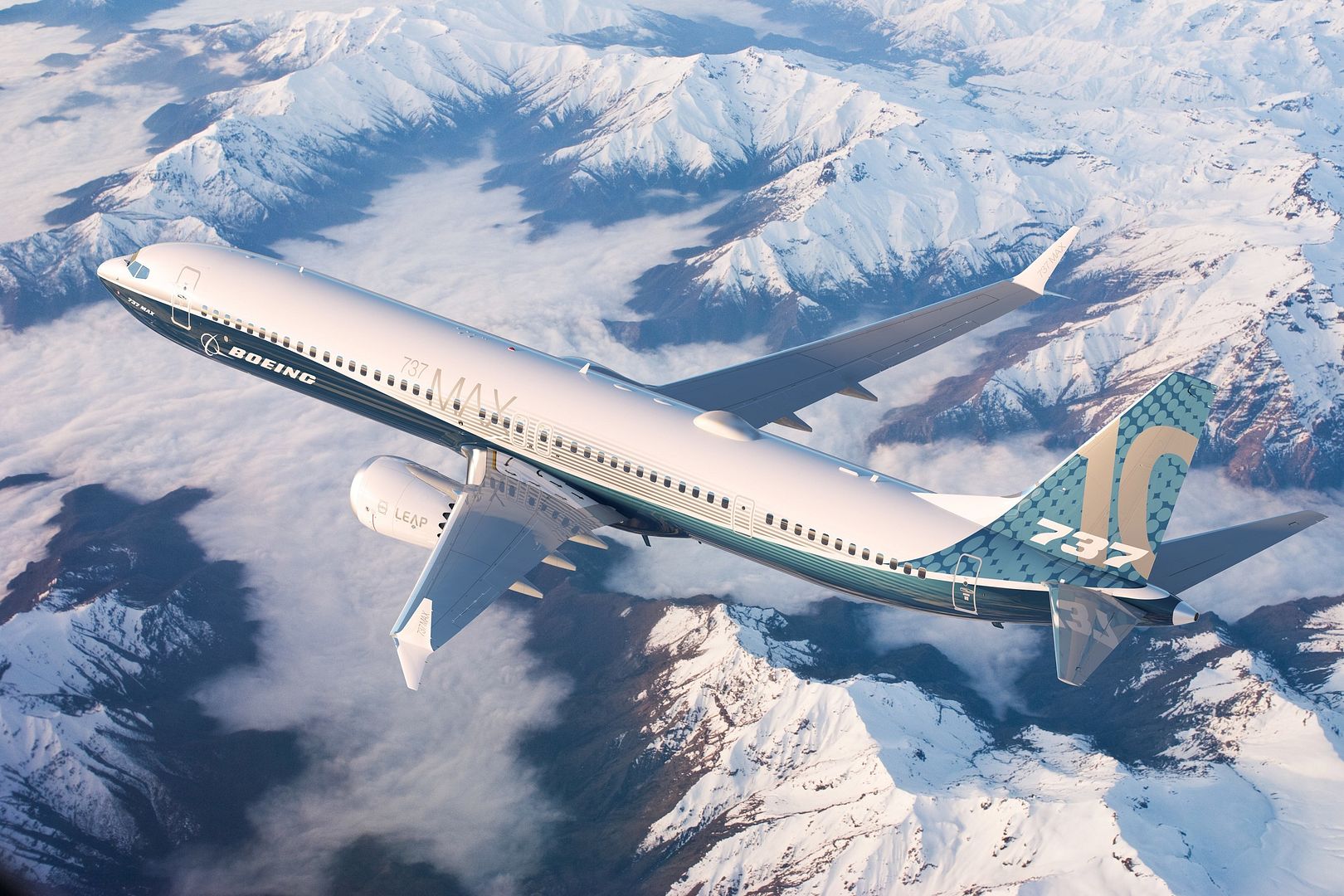
Singapore, Airbus Helicopters? business in Japan gains traction with two new orders and two new deliveries at the start of the year, reaffirming the company?s strong presence in the country. Currently leading the Japanese civil and parapublic helicopter market with more than 50% market share, Airbus Helicopters plans to increase its position in tandem with the Japan?s projected fleet growth of 2% annually over the next 20 years.
The first contract was signed with longstanding customer Excel Air Services, for a Helionix-equipped H135 helicopter. This new aircraft will join the operator?s growing Airbus fleet currently comprising an AS355N, AS350B2, AS350B3 and Herm?s-designed H135. This best-seller light-twin helicopter will be dedicated for electronic news gathering missions.
The second contract was signed with a new customer the Hokkaido Government, which placed an order for one AS365N3+ helicopter from the Dauphin family. The helicopter will be dedicated for rescue missions and supporting activities in the Prefecture and will play an important role in the North of Japan, known for its extensive fields and harsh winter conditions.
Additionally, Airbus has delivered one AS365N3+ helicopter each to the Fukuoka City Fire Department and the Kumamoto prefecture respectively, for firefighting work, search and rescue missions and emergency support.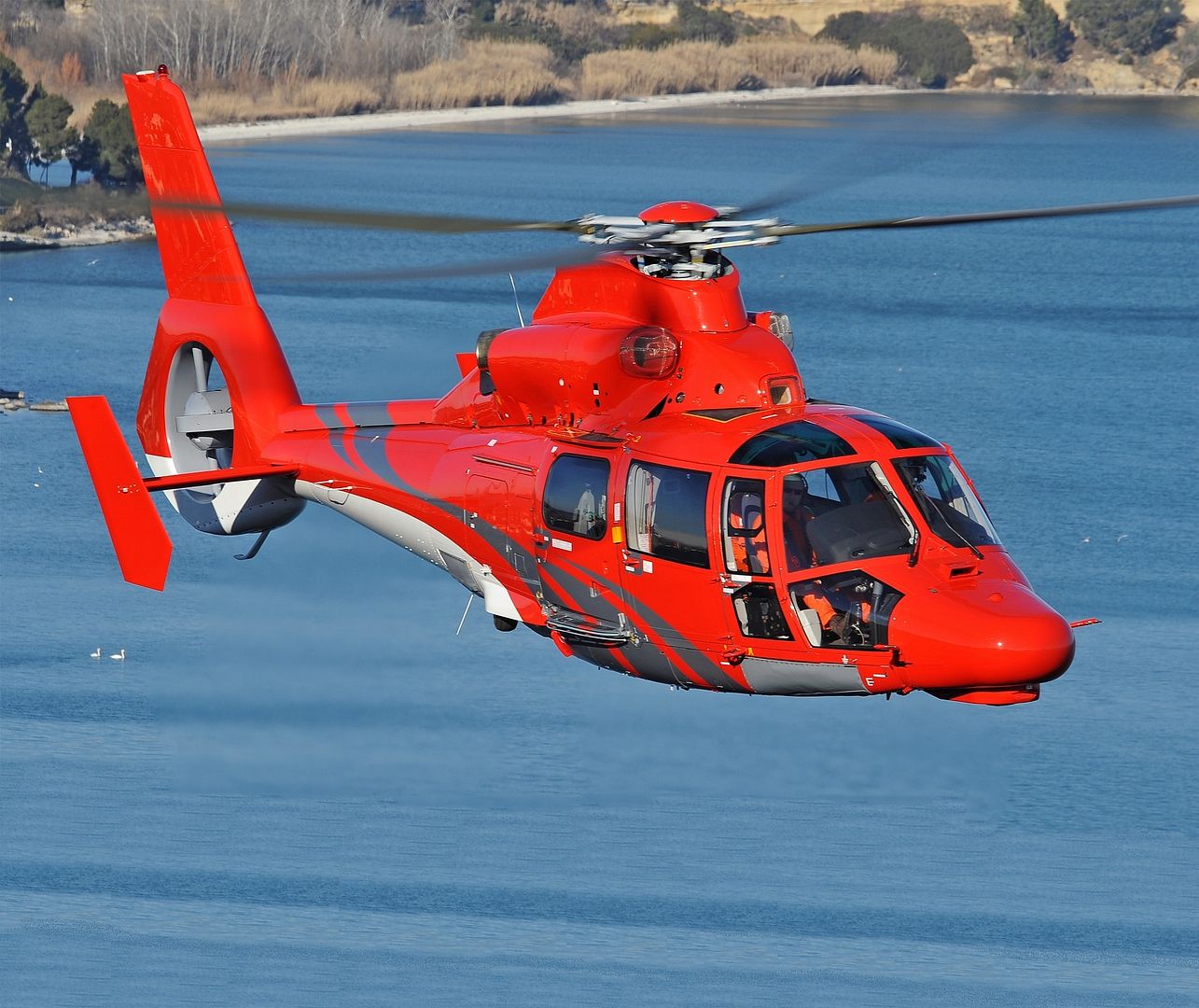
?The successive orders and deliveries signal a good start to the new year in Japan, as we renew long-lasting relationships and welcome new ones,? said Olivier Tillier, Managing Director of Airbus Helicopters in Japan. ?With more orders expected in the coming months, we are all geared to provide total support through our well established value chain to serve the growing needs of our customers.?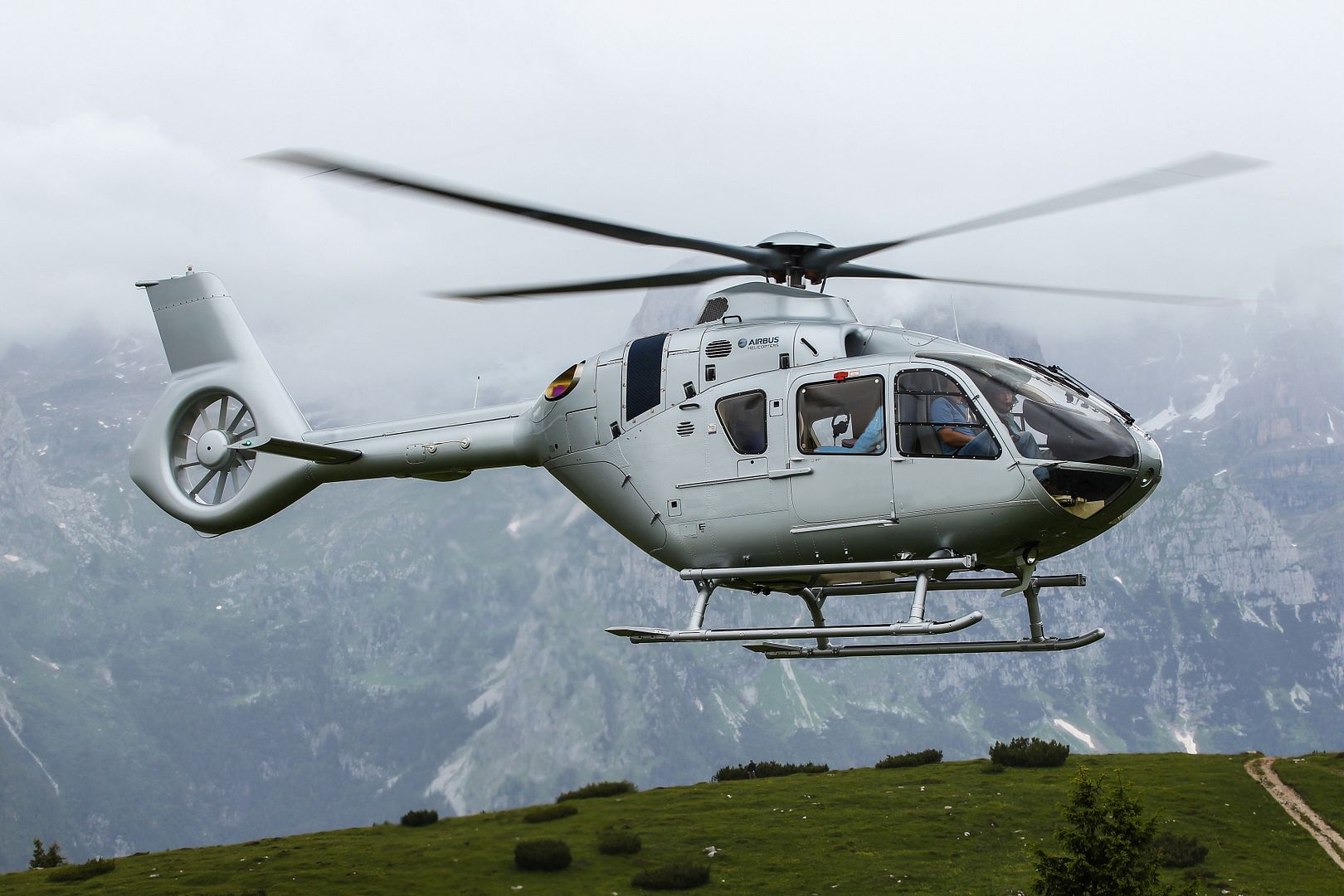
Lufthansa officially launched its new livery in Frankfurt today.
The German carrier showed off a Boeing 747-8I featuring the new paint job at an event for Lufthansa staff on Wednesday evening.
Lufthansa also displayed an Airbus A321 with the new livery at the gathering, which took place in a hangar at Frankfurt Main airport.
The redesign marks 100 years since the airline introduced its crane logo.
?Lufthansa has changed and is more modern and successful than ever,? says group chief executive Carsten Spohr. ?From now on, this will also be visible to the public through a new design.?
The livery is intended to better reflect Lufthansa mainline?s focus on premium markets, Spohr adds.
Some 40 Lufthansa aircraft will receive the new paintwork this year, as part of a seven-year programme to introduce the scheme across its entire fleet.
The new design features darker blue paint, which extends over the rear of the fuselage from the tail. The font used for the word ?Lufthansa? on the forward fuselage has been updated, albeit subtly
The livery has prompted some criticism because it drops the colour yellow ? a long-standing feature of the Lufthansa liveries.
Spohr says ?Lufthansa yellow? will still be a key part of the business?s branding, however, featuring on staff uniforms and airport signage, for example.
?We will use yellow perhaps even more in the future,? Spohr adds.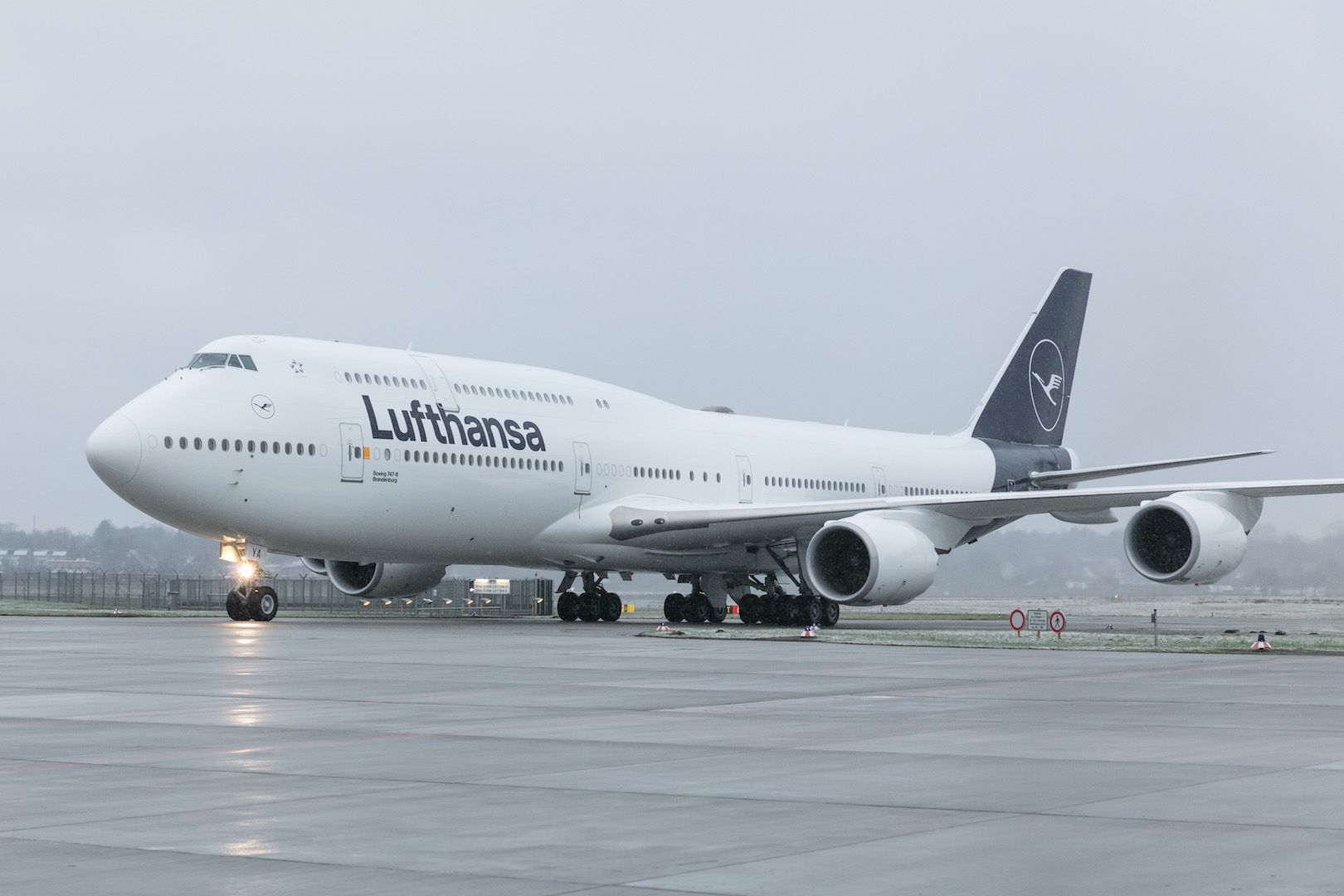
-
 Main AdminAn F/A-18C Hornet conducts Field Carrier Landing Practice aboard Marine Corps Air Station Beaufort, Feb. 7. FCLP?s simulate landing on an aircraft carrier and are executed to instill pilot proficiency.
Main AdminAn F/A-18C Hornet conducts Field Carrier Landing Practice aboard Marine Corps Air Station Beaufort, Feb. 7. FCLP?s simulate landing on an aircraft carrier and are executed to instill pilot proficiency.
Photo by Lance Cpl. Terry Haynes(released)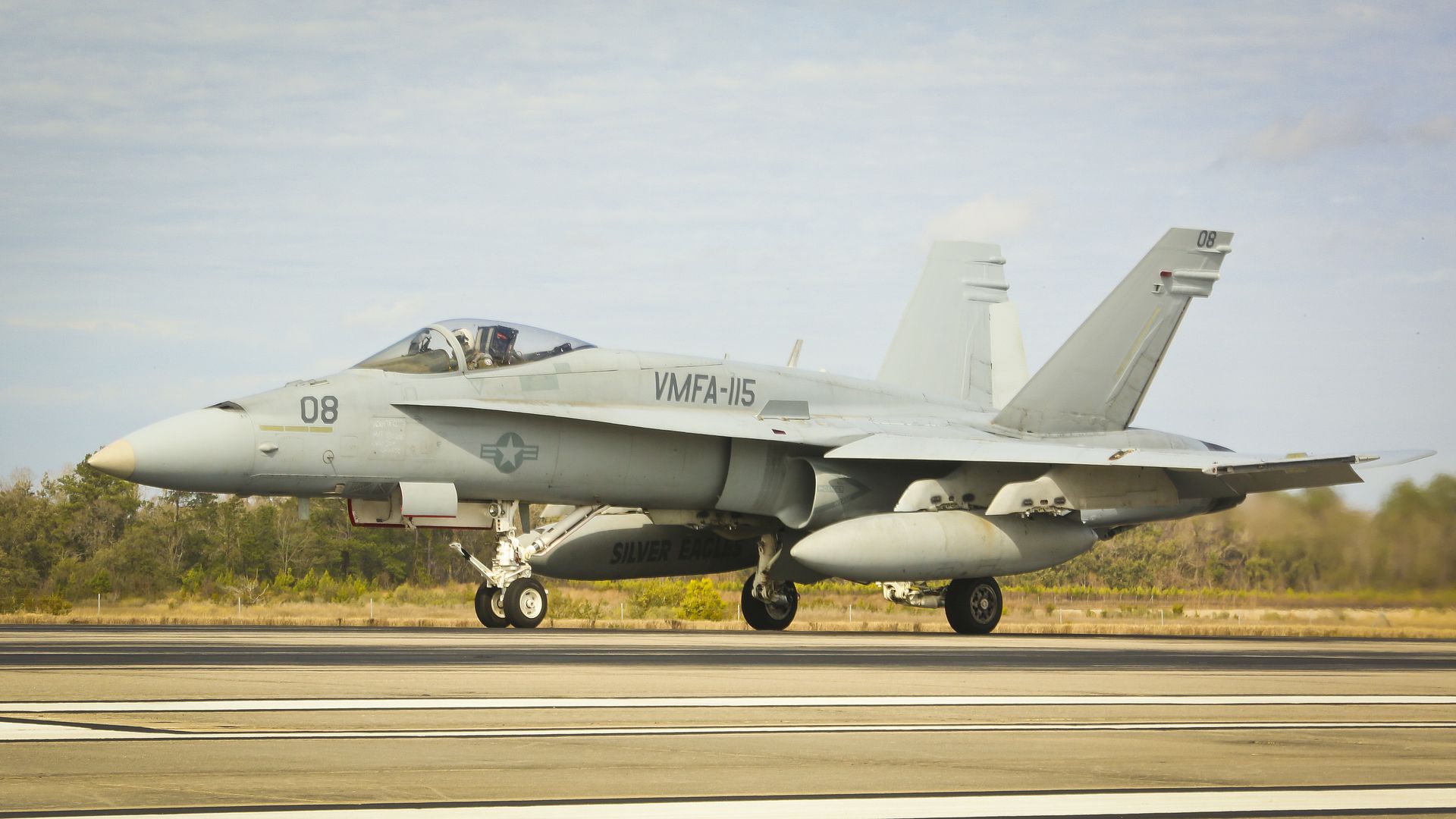
ARABIAN GULF (Feb. 8, 2018) An MH-60S Sea Hawk, assigned to the Indians of Helicopter Sea Combat Squadron (HSC) 6, flies over the aircraft carrier USS Theodore Roosevelt (CVN 71) at sunrise. Theodore Roosevelt and its carrier strike group are deployed to the U.S. 5th Fleet area of operations in support of maritime security operations to reassure allies and partners and preserve the freedom of navigation and the free flow of commerce in the region. (U.S. Navy photo by Mass Communication Specialist 3rd Class Joseph S. Yu/Released)
ARABIAN GULF (Feb. 8, 2018) Sailors ready an F/A-18E Super Hornet, assigned to the Stingers of Strike Fighter Attack Squadron (VFA) 113, for launch on the flight deck of the aircraft carrier USS Theodore Roosevelt (CVN 71). Theodore Roosevelt and its carrier strike group are deployed to the U.S. 5th Fleet area of operations in support of maritime security operations to reassure allies and partners and preserve the freedom of navigation and the free flow of commerce in the region. (U.S. Navy photo by Mass Communication Specialist 2nd Class Jimmi Lee Bruner/Released)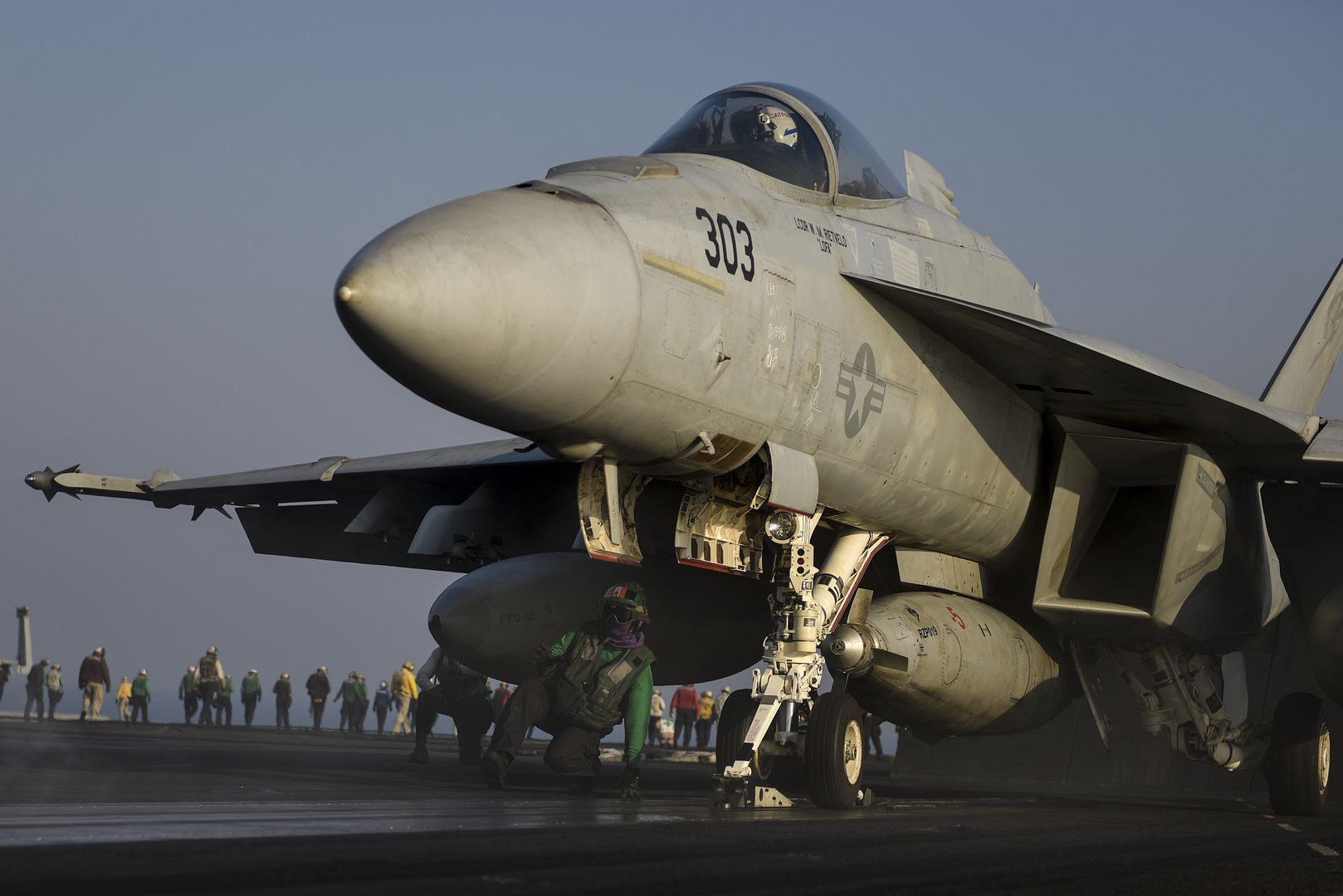
A Royal Air Force member observes pre-flight checks on a Eurofighter Typhoon assigned to No. 11 Squadron, RAF Coningsby, during Red Flag 18-1 at Nellis Air Force Base, Nevada, Feb. 5, 2018. No. 11 Squadron is one of the oldest flying squadrons in the RAF. (U.S. Air Force photo by Airman 1st Class Andrew D. Sarver)
Royal Air Force pilots perform pre-flight checks during Red Flag 18-1 at Nellis Air Force Base, Nevada, Feb. 5, 2018. Red Flag provides realistic combat training in a contested degraded and operationally limited environment. (U.S. Air Force photo by Airman 1st Class Andrew D. Sarver)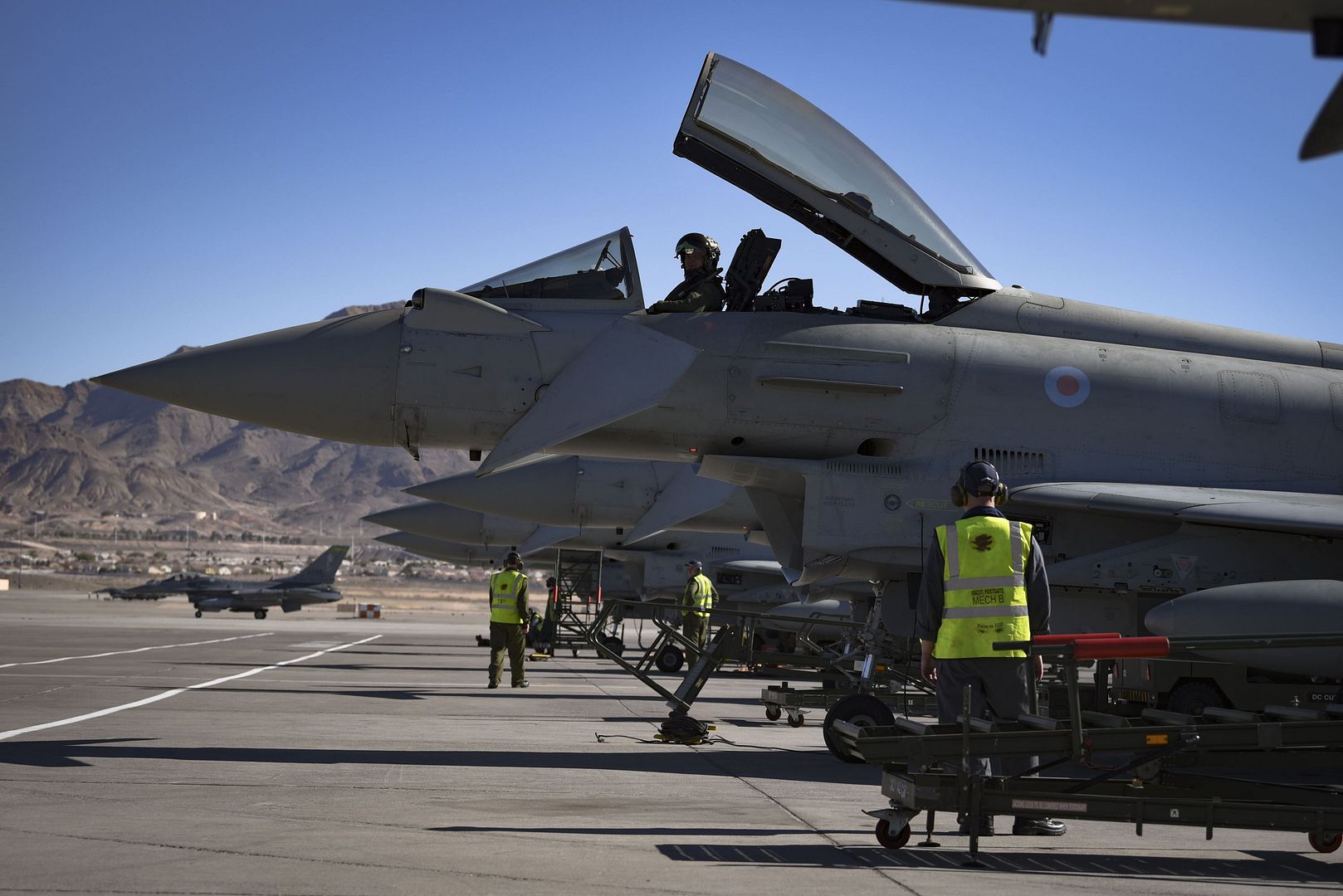
A KC-135 Stratotanker jet assigned to the 100 Air Refueling Wing at Royal Air Force Mildenhall, takes off during Red Flag 18-1 at Nellis Air Force Base, Nevada, Feb. 5, 2018. Red Flag is one of a series of advanced training programs administered by the U.S. Air Force Warfare Center to train aircrews. (U.S. Air Force photo by Senior Airman Kevin Tanenbaum)
An F-22 Raptor fighter jet assigned to the 1st Fighter Wing at Joint Base Langley-Eustis, Virginia, takes off during Red Flag 18-1 at Nellis Air Force Base, Nevada, Feb. 5, 2018. Red Flag 18-1 gives military members an opportunity to experience realistic combat scenarios in a training environment. (U.S. Air Force photo by Senior Airman Kevin Tanenbaum)
A B-1B Lancer bomber assigned to the 7th Bomber Wing at Dyess Air Force Base, Texas, takes off from Nellis Air Force Base, Nevada, Feb. 5, 2018. Red Flag is a realistic combat training exercise involving the air, space and cyber forces of the U.S. and its allies. (U.S. Air Force photo by Senior Airman Kevin Tanenbaum)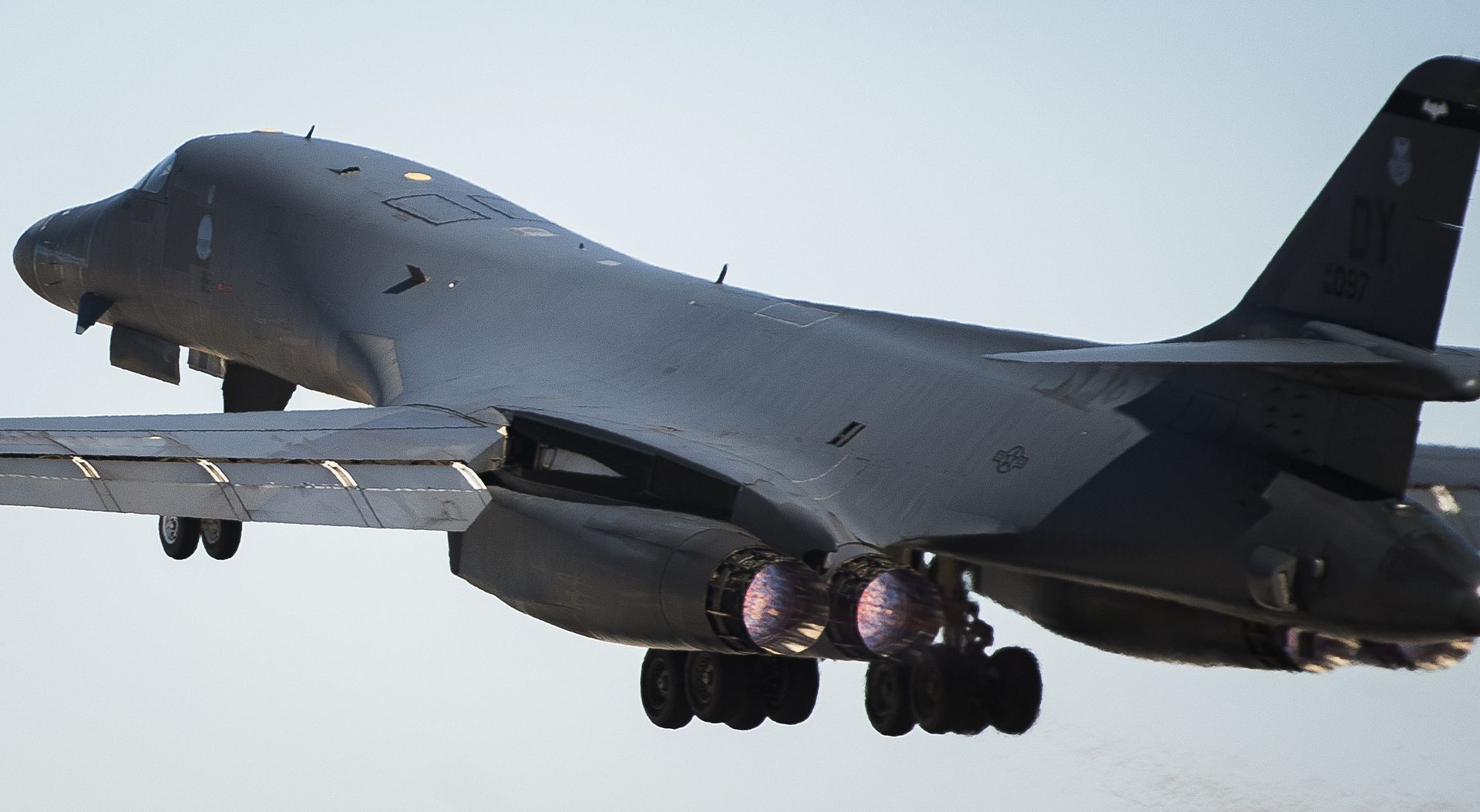
Phnom Penh, Cambodia (8 February 2018) - Bell Helicopter, a Textron Inc. (NYSE: TXT) company, announced today the delivery of two Bell 505 Jet Ranger X helicopters to Asian Aviation Resources Pte. Ltd. in Cambodia.
One of the helicopters, which will be operated by Helicopters Cambodia, will be used to facilitate the United States Department of Defense?s Defense POW/MIA Accounting Agency (DPAA) in their efforts to find missing US military personnel in Southeast Asia. The other helicopter will be used for tourism related charters.
?We are proud to play a role in the US DPAA?s noble mission to reunite missing United States military personnel with their families and to give an account to the nation. Once again, our thoughts and gratitude go out to all the families who have made the ultimate sacrifice for the freedom we as Americans enjoy today,? said Sameer A. Rehman, managing director of Bell Helicopter Asia Pacific. ?We look forward to working with the DPAA and Helicopters Cambodia to ensure the success of both the DPAA and Helicopters Cambodia?s missions throughout Southeast Asia and beyond.?
The reliability, speed, performance, and maneuverability of the Bell 505 is integrated with a flat floor, open cabin that is configurable for a wide variety of missions and payloads. The spacious cabin can be configured to carry up to four passengers or configured for internal cargo missions by removing quick disconnect rear cabin seats and/or copilot seat. The Bell 505?s flat floor cabin design and large rectangular baggage compartment lets the Bell 505 adapt to the ever-changing mission needs. These features combined with a proven and reliable drivetrain and rotor system make the Bell 505 a true multi-mission aircraft in the short light single-engine market.
-
 Main AdminARABIAN GULF (Feb. 10, 2018) An F/A-18F Super Hornet, assigned to the Fighting Redcocks of Strike Fighter Attack Squadron (VFA) 22, launches from the flight deck of the aircraft carrier USS Theodore Roosevelt (CVN 71). Theodore Roosevelt and its carrier strike group are deployed to the U.S. 5th Fleet area of operations in support of maritime security operations to reassure allies and partners and preserve the freedom of navigation and the free flow of commerce in the region. (U.S. Navy photo by Mass Communication Specialist 3rd Class Alex Corona/Released)
Main AdminARABIAN GULF (Feb. 10, 2018) An F/A-18F Super Hornet, assigned to the Fighting Redcocks of Strike Fighter Attack Squadron (VFA) 22, launches from the flight deck of the aircraft carrier USS Theodore Roosevelt (CVN 71). Theodore Roosevelt and its carrier strike group are deployed to the U.S. 5th Fleet area of operations in support of maritime security operations to reassure allies and partners and preserve the freedom of navigation and the free flow of commerce in the region. (U.S. Navy photo by Mass Communication Specialist 3rd Class Alex Corona/Released)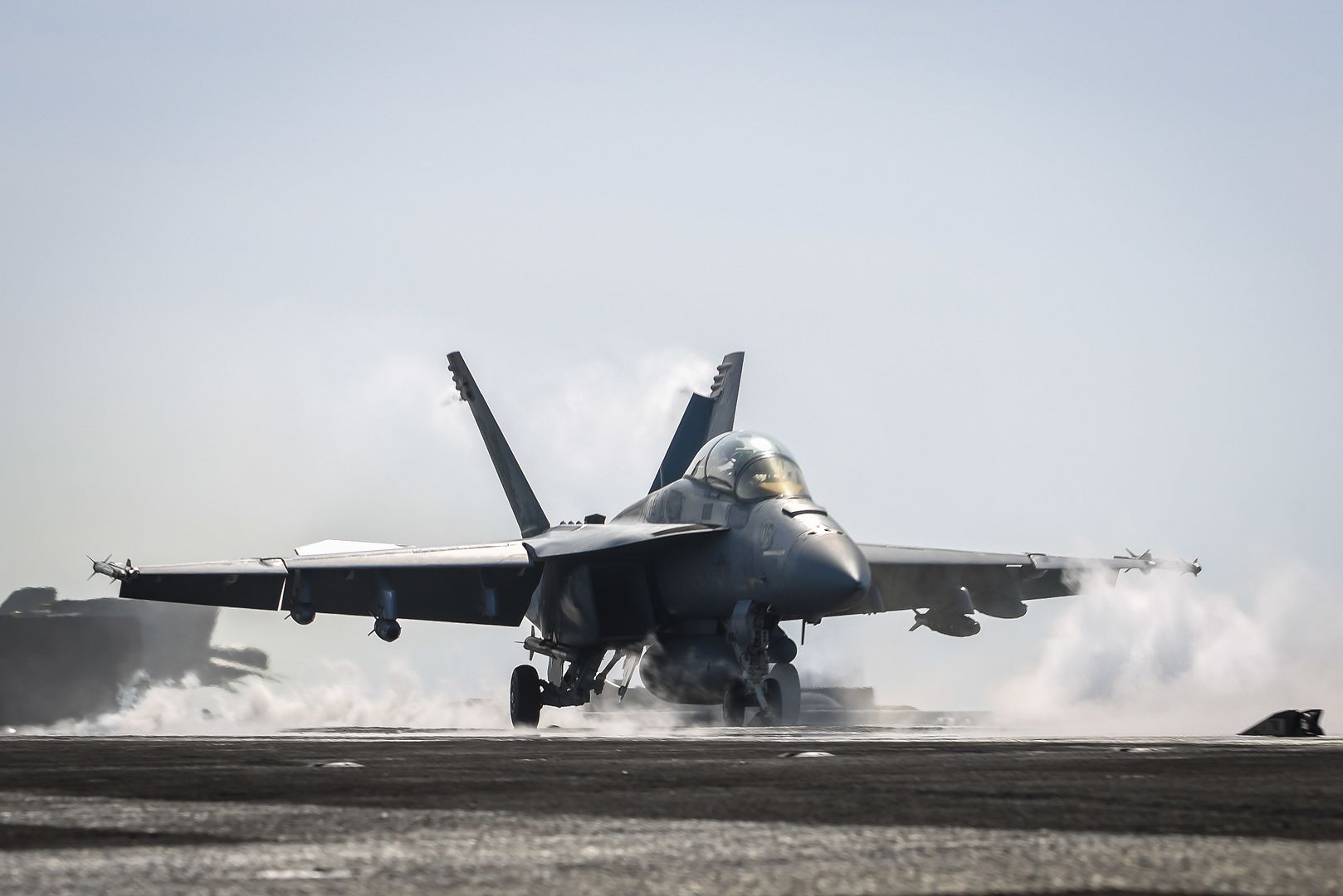
ARABIAN GULF (Feb. 10, 2018) An EA-18G Growler, assigned to the Cougars of Electronic Attack Squadron (VAQ) 139, takes off from the flight deck of the aircraft carrier USS Theodore Roosevelt (CVN 71). Theodore Roosevelt and its carrier strike group are deployed to the U.S. 5th Fleet area of operations in support of maritime security operations to reassure allies and partners and preserve the freedom of navigation and the free flow of commerce in the region. (U.S. Navy photo by Mass Communication Specialist 3rd Class Spencer Roberts/Released)
Four U.S. Air Force F-16C Fighting Falcons and four Swedish Air Force JAS 39 Gripens fly in formation during aerial refueling training in Swedish airspace, Feb. 8, 2018. The air refueling training is in conjunction with a rotational deployment of F-16Cs from the Ohio Air National Guard?s 180th Fighter Wing to Amari Air Base, Estonia, as part of a Theater Security Package. The training allows the U.S. and Sweden to strengthen interoperability and increase readiness. (U.S. Air Force photo by Airman 1st Class Luke Milano)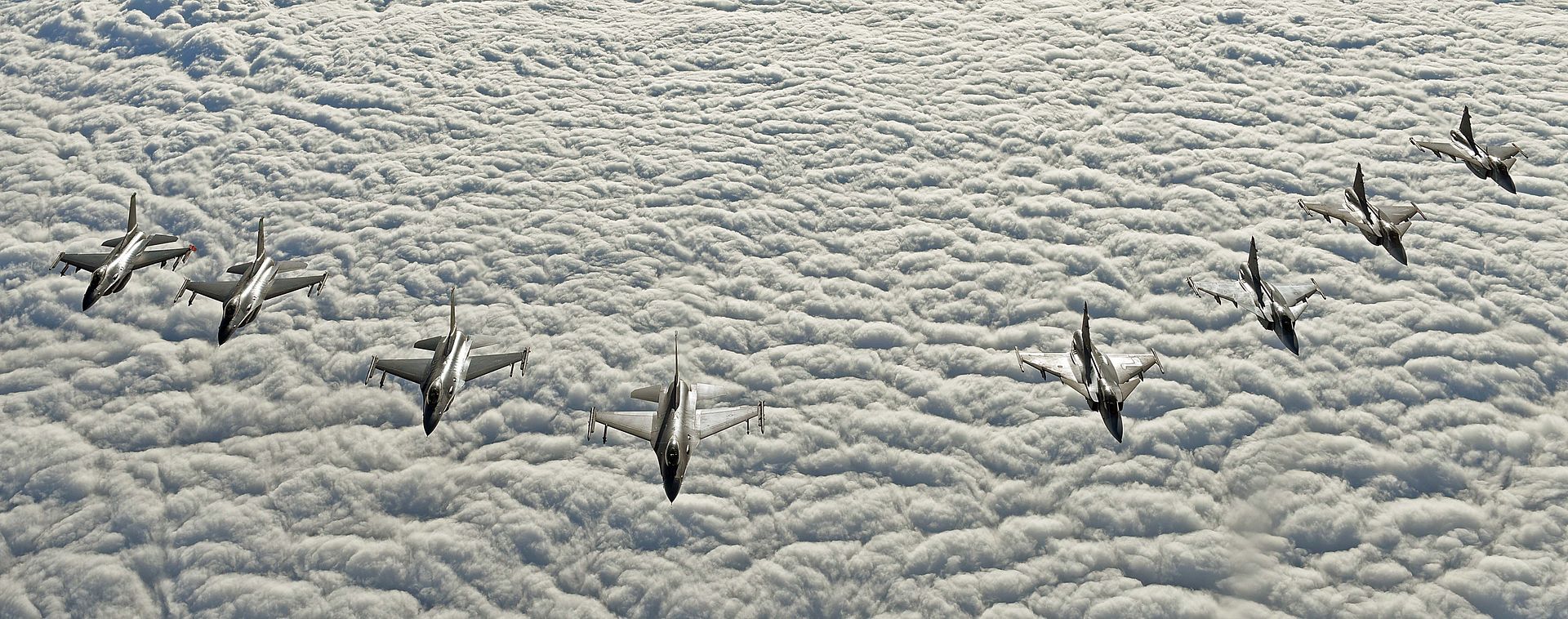
With early morning temperatures in double digits below zero, crew chiefs from the Iowa Air National Guard?s 185th Air Refueling Wing clear snow from an overnight squall that was deposited on a U.S. Air Force KC-135. The Airmen are preparing the aircraft for flight during their February training weekend in Sioux City, Iowa on February 10, 2018.
U.S. Air National Guard photo's by: Master Sgt. Vincent De Groot
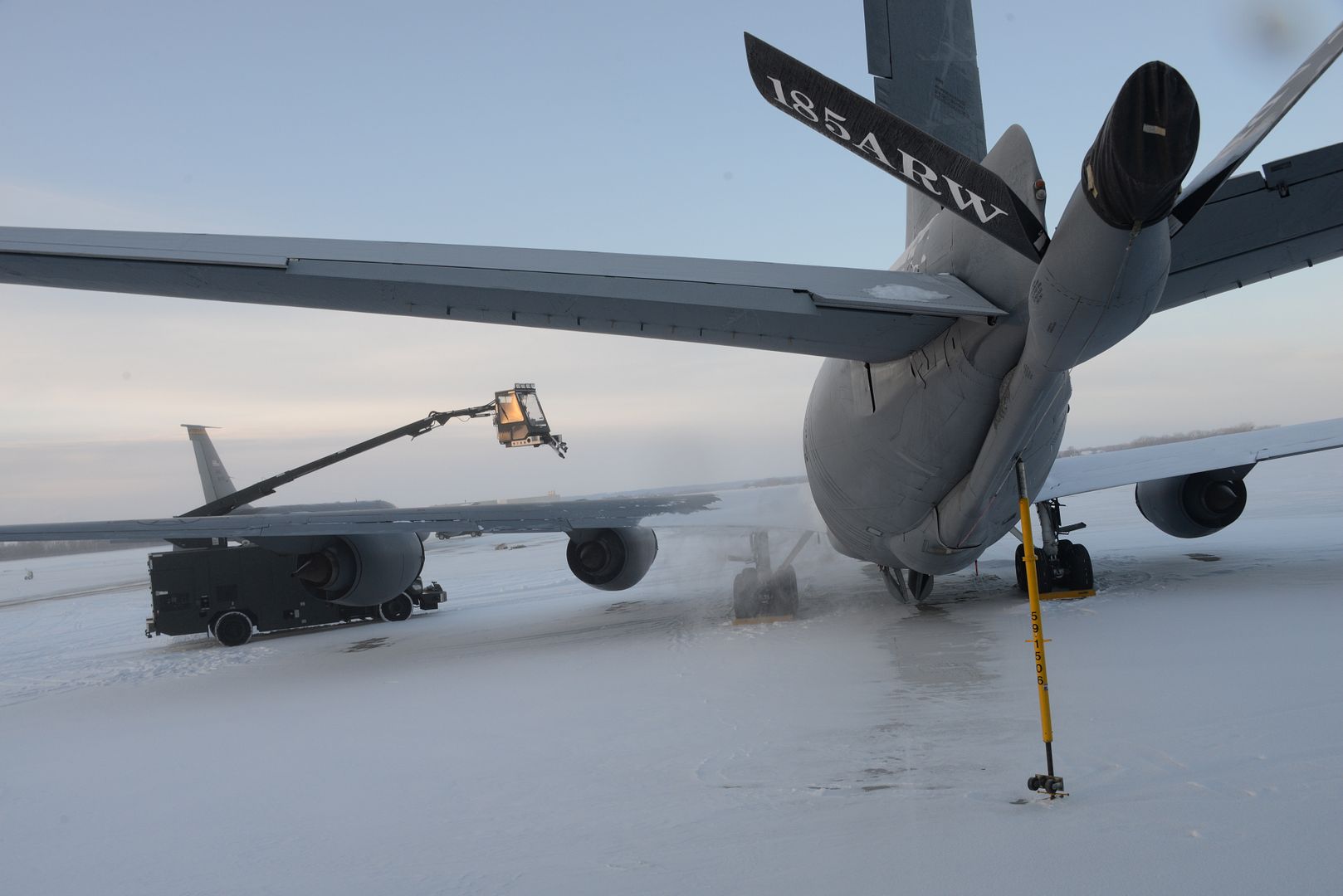
A U.S. Air Force KC-135 from the Iowa Air National Guard?s 185th Air Refueling Wing is bathed in a cloud of exhaust from a portable heating unit being used to warm the cockpit in preparation of an early morning take off in Sioux City, Iowa on February 10, 2018. With early morning temperatures in double digits below zero, crew chiefs from the 185th ARW are preparing the aircraft for flight during their February training weekend.
U.S. Air National Guard photo by: Master Sgt. Vincent De Groot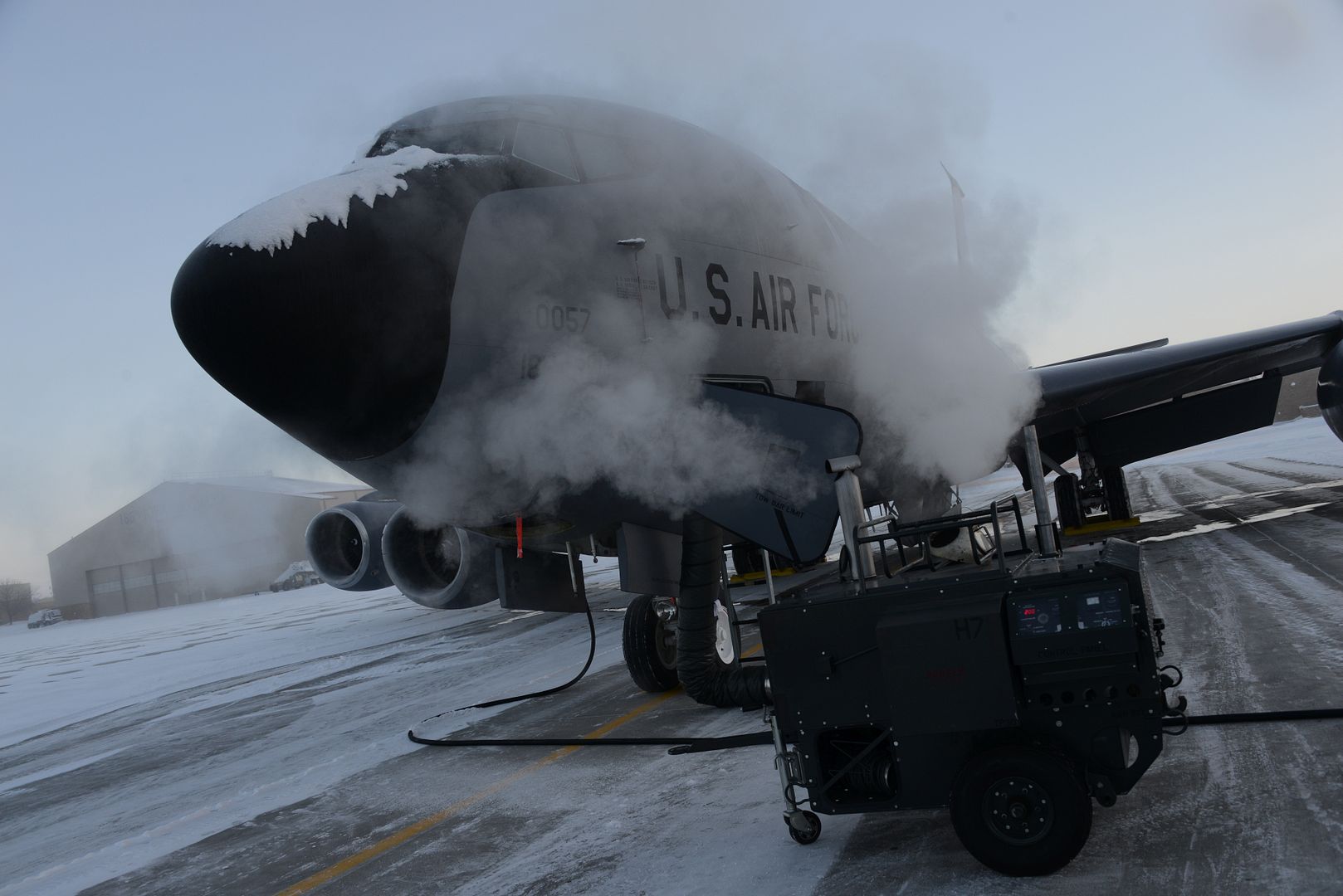
A B-52H Stratofortress bomber, assigned to the 20th Expeditionary Bomb Squadron at Andersen Air Force Base, Guam, flies over the Singapore International Airshow at the Singapore Changi Airport and the Changi Exhibition Centre, Singapore, Feb. 10, 2018. Through participation in airshows and regional events, the U.S. demonstrates its commitment to the security of the Indo-Pacific region, promotes interoperability, displays the flexible combat capabilities of the U.S. military, and creates lasting relationships with international audiences to strengthen the bonds that support partnership building throughout the Indo-Pacific region. (U.S. Air Force photo by Staff Sgt. David Owsianka)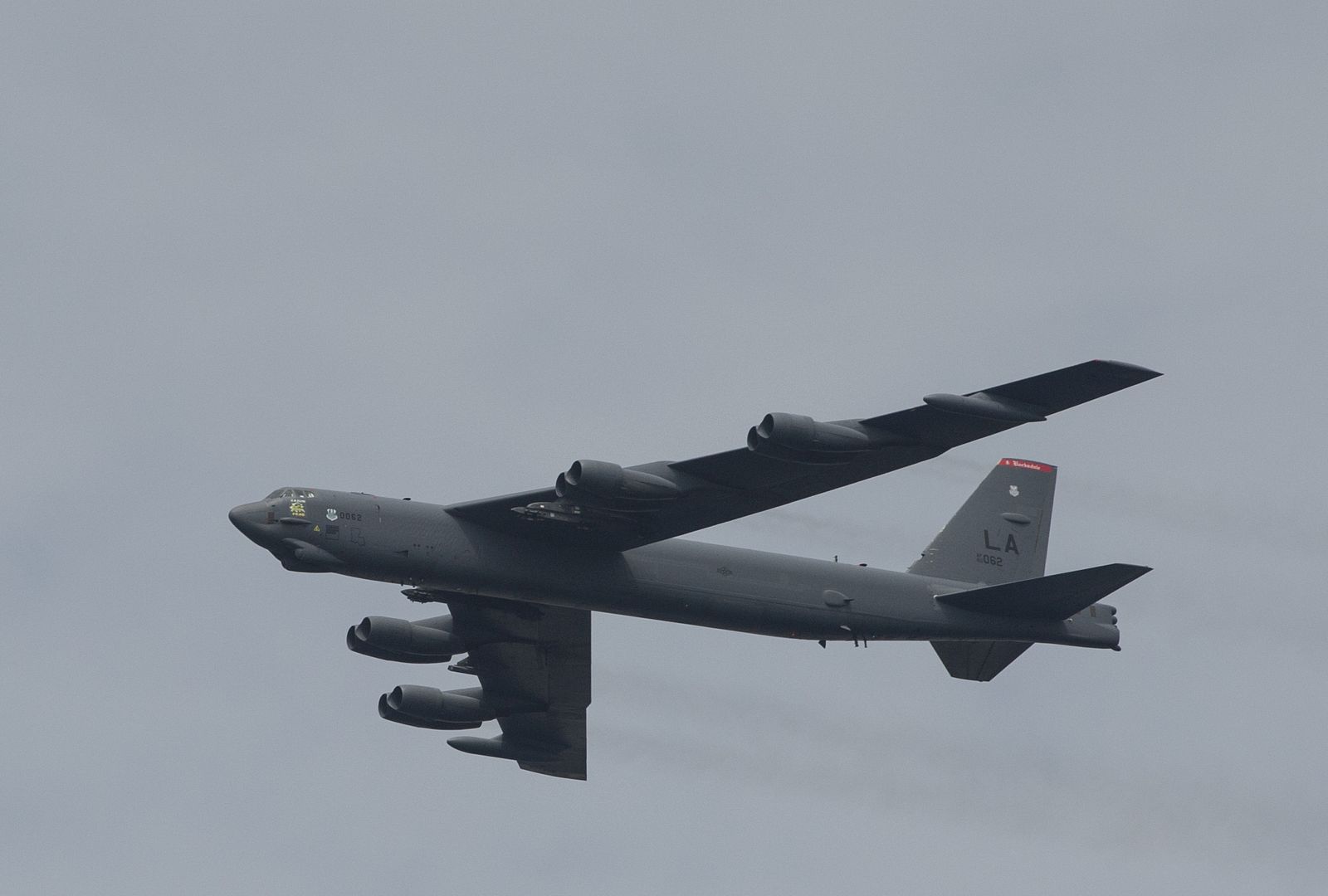
-
 Main AdminAn AH-1Z Viper prepares to land at U-Tapao International Airport, Kingdom of Thailand, Feb. 10, 2018. The Marines of Marine Light Attack Helicopter Squadron 369 ?Gunfighters? arrive to the Kingdom of Thailand to participate in Cobra Gold, one of the largest theater security cooperation exercises in the Indo-Asia-Pacific region. HMLA-369, Marine Aircraft Group 39, 3rd Marine Aircraft Wing, is currently forward deployed under the unit deployment program with MAG-36, 1st MAW. Exercise Cobra Gold 2018 is an annual exercise conducted in the Kingdom of Thailand held from Feb. 13-23 with seven full participating nations. (U.S. Marine Corps photo by Cpl. Andy Martinez)
Main AdminAn AH-1Z Viper prepares to land at U-Tapao International Airport, Kingdom of Thailand, Feb. 10, 2018. The Marines of Marine Light Attack Helicopter Squadron 369 ?Gunfighters? arrive to the Kingdom of Thailand to participate in Cobra Gold, one of the largest theater security cooperation exercises in the Indo-Asia-Pacific region. HMLA-369, Marine Aircraft Group 39, 3rd Marine Aircraft Wing, is currently forward deployed under the unit deployment program with MAG-36, 1st MAW. Exercise Cobra Gold 2018 is an annual exercise conducted in the Kingdom of Thailand held from Feb. 13-23 with seven full participating nations. (U.S. Marine Corps photo by Cpl. Andy Martinez)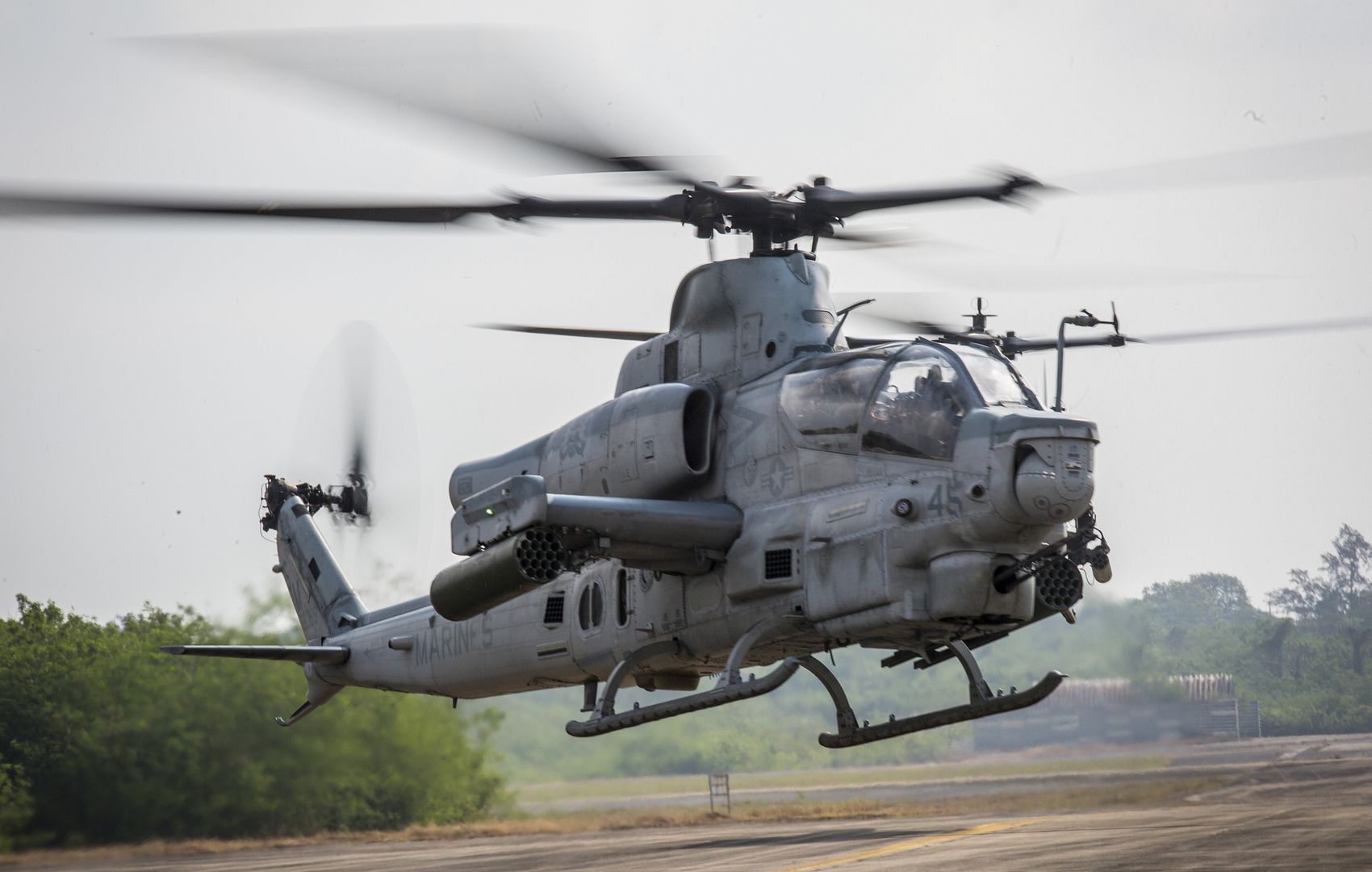
ARABIAN GULF (Feb. 12, 2018) An MH-60R Sea Hawk, assigned to the Battlecats of Helicopter Maritime Strike Squadron (HSM) 73, lands on the flight deck of the aircraft carrier USS Theodore Roosevelt (CVN 71). Theodore Roosevelt and its carrier strike group are deployed to the U.S. 5th Fleet area of operations in support of maritime security operations to reassure allies and partners and preserve the freedom of navigation and the free flow of commerce in the region. (U.S. Navy photo by Mass Communication Specialist 3rd Class Alex Corona/Released)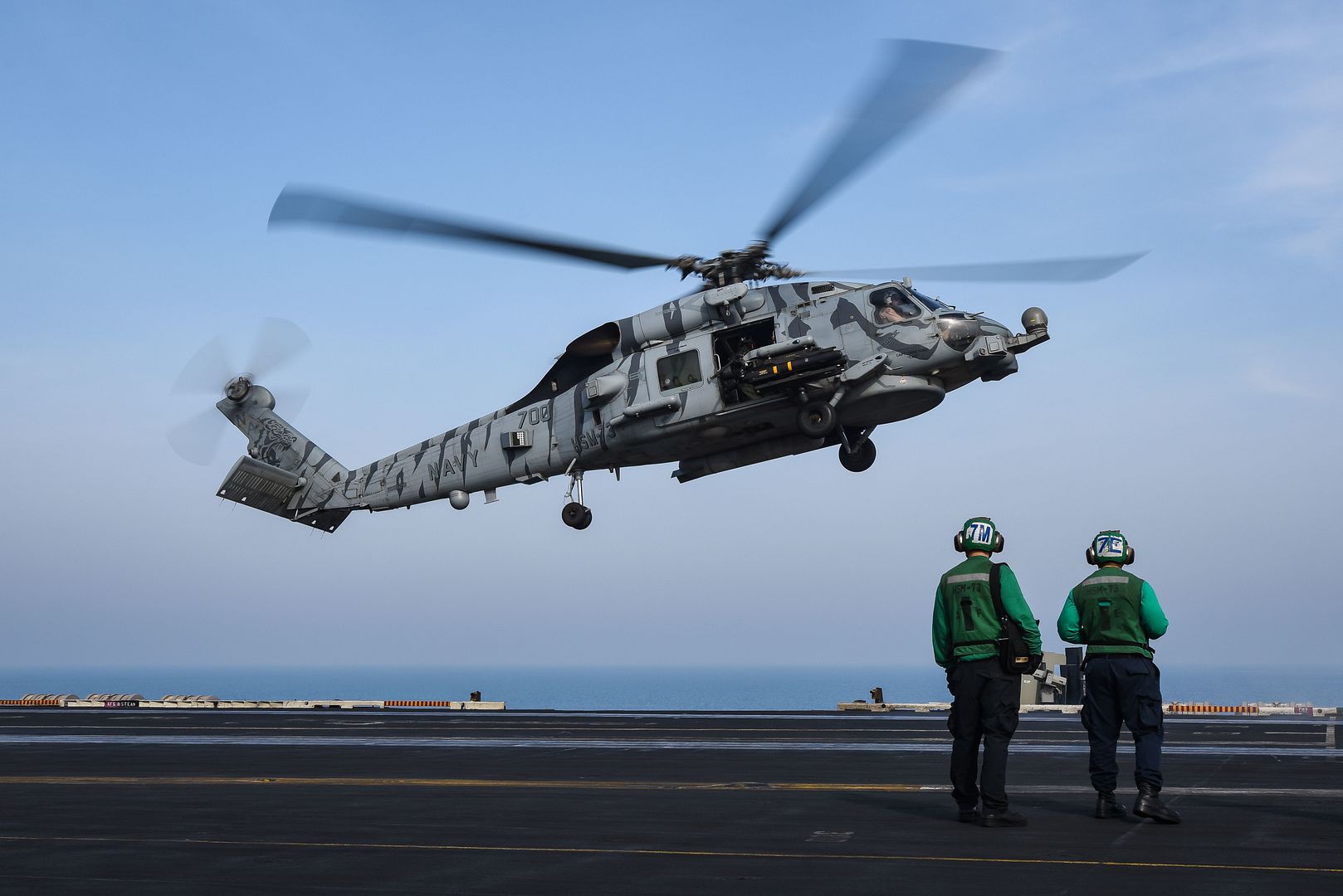
Five U.S. Air Force A-10C Thunderbolt IIs prepare to take off during the Bushwhacker 18-02 Cactus Flag exercise at Davis-Monthan Air Force Base, Ariz., Feb. 11, 2018. The Cactus Flag exercise is designed to ensure D-M is ready to deliver attack aircraft anywhere in the world. (U.S. Air Force photo by Senior Airman Mya M. Crosby)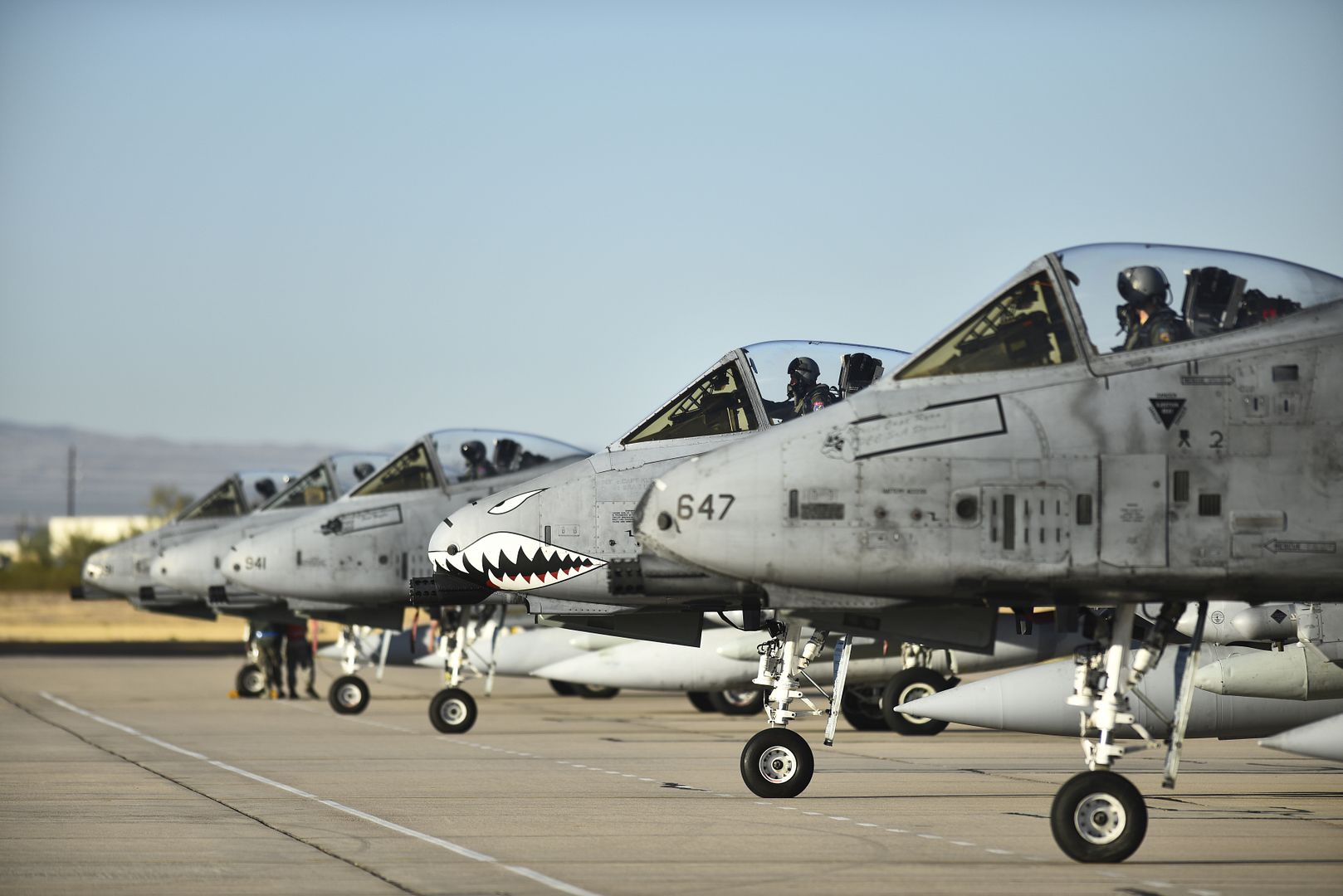
U.S. Air Force A-10C Thunderbolt II's take off during the Bushwhacker 18-02 Cactus Flag exercise at Davis-Monthan Air Force Base, Ariz., Feb. 11, 2018. The Cactus Flag exercise is designed to test Davis-Monthan AFB's ability to deliver attack aircraft anywhere in the world. (U.S. Air Force photo's by Staff Sgt. Chris Drzazgowski)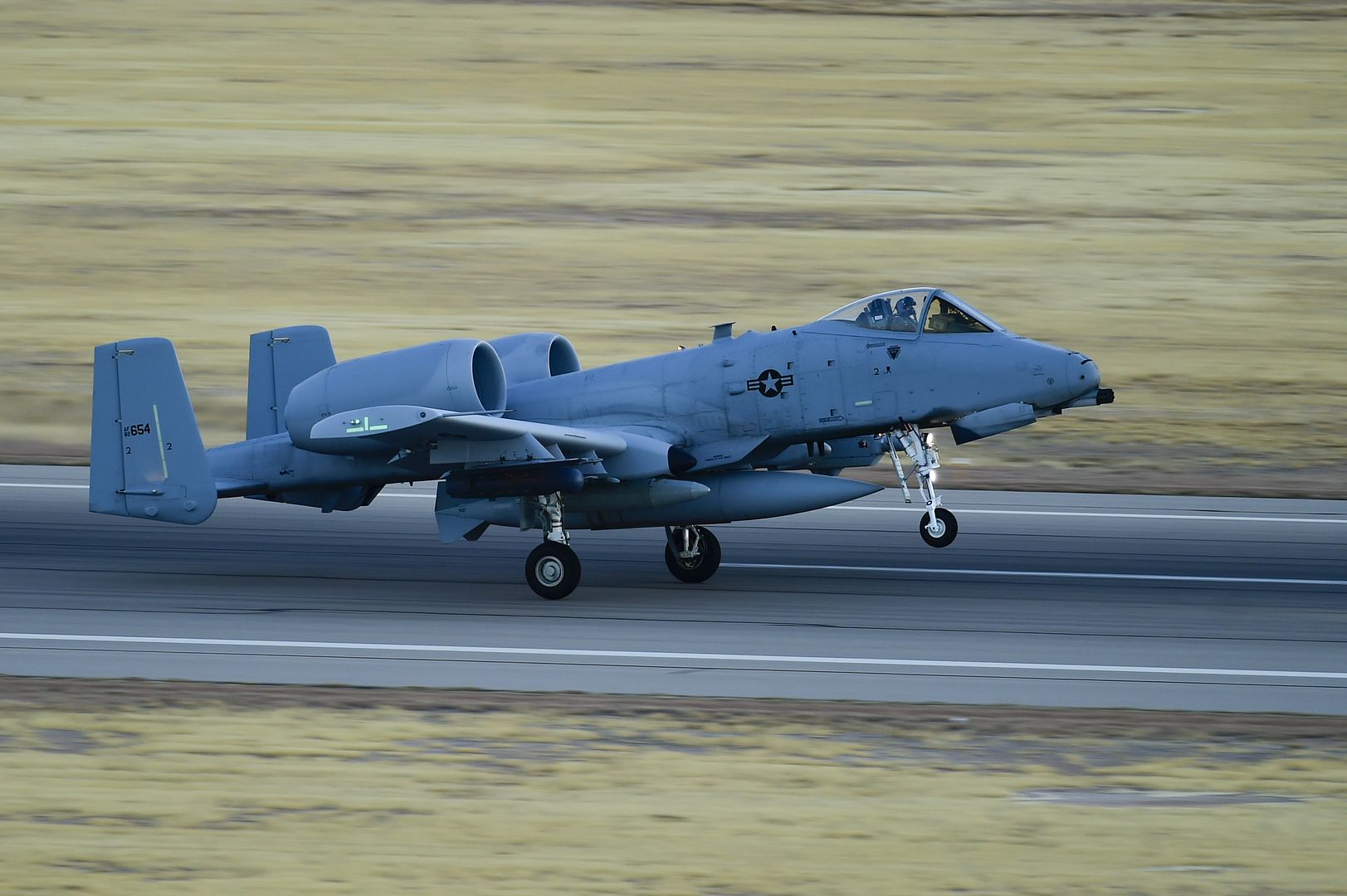
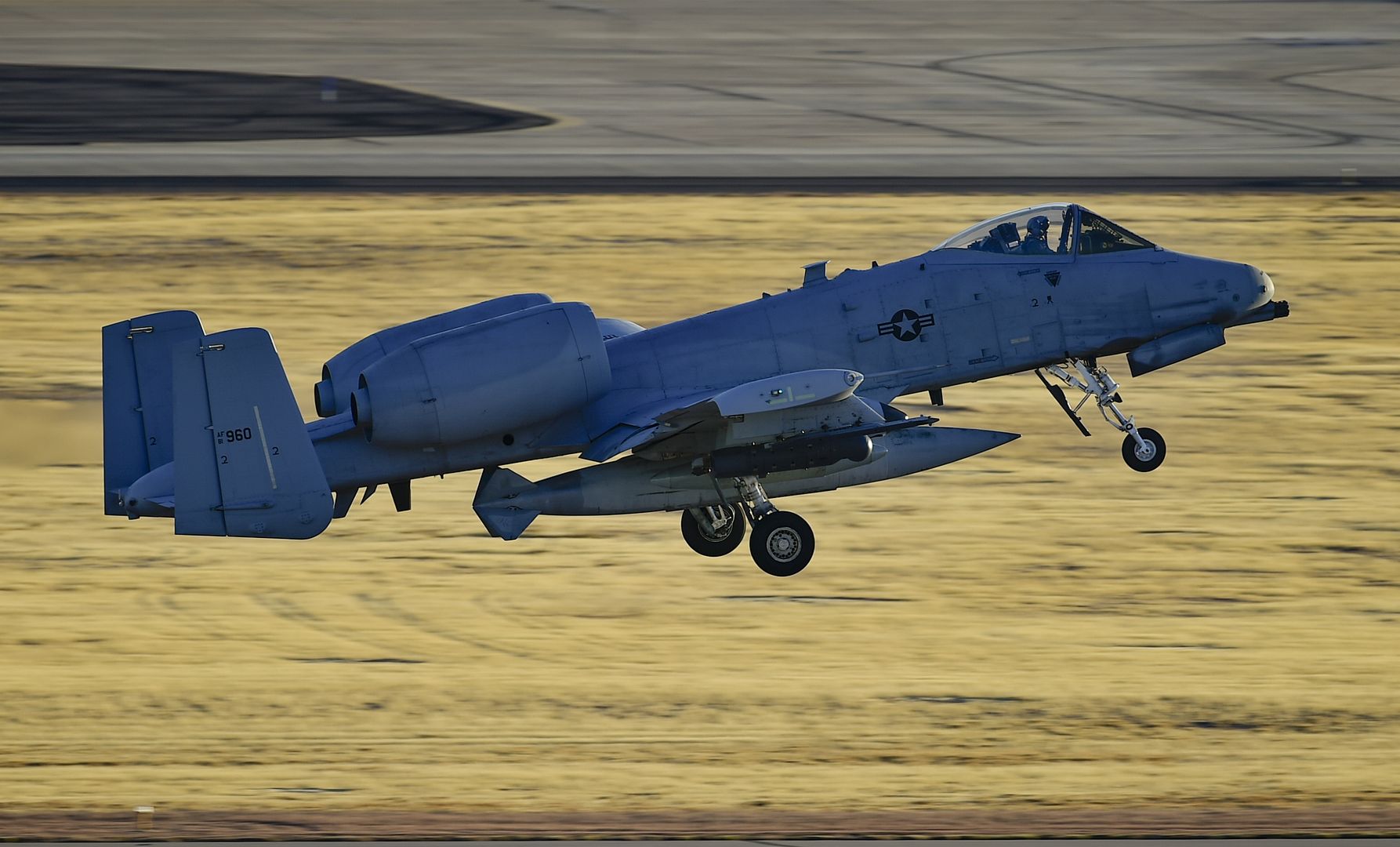
A U.S. Air Force F-35A Lightning II assigned to the 34th Fighter Squadron, Hill Air Force Base, Utah, sits on the flightline at Yokota Air Base, Japan, Feb. 9, 2018, in support of the vice president's visit to Japan. The F-35A is deployed under the U.S. Pacific Command?s Theater Security Package program, which has been in operation since 2004. This long-planned deployment demonstrates the continuing U.S. commitment to stability and security in the region. (U.S. Air Force photo's by Yasuo Osakabe)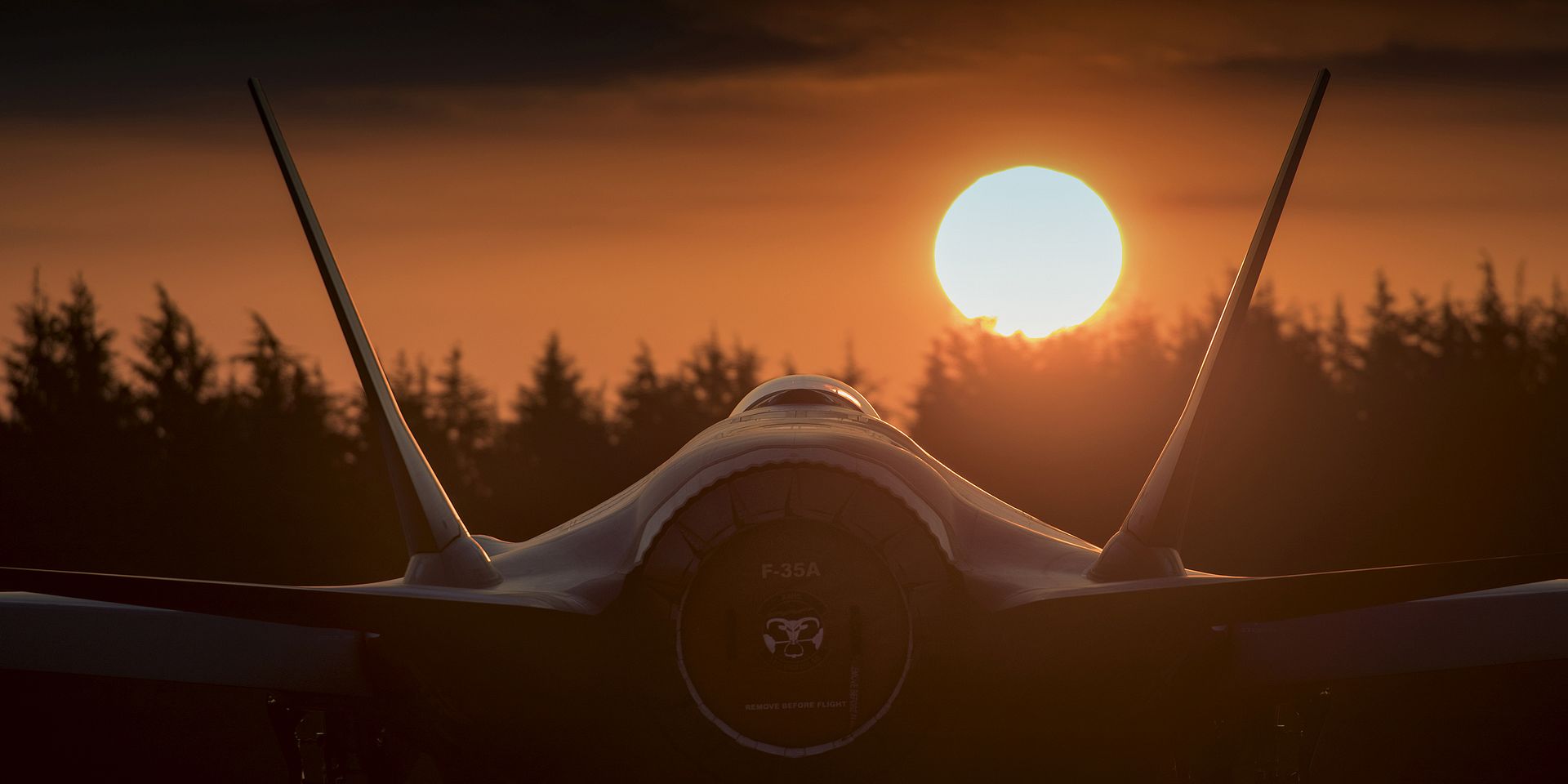
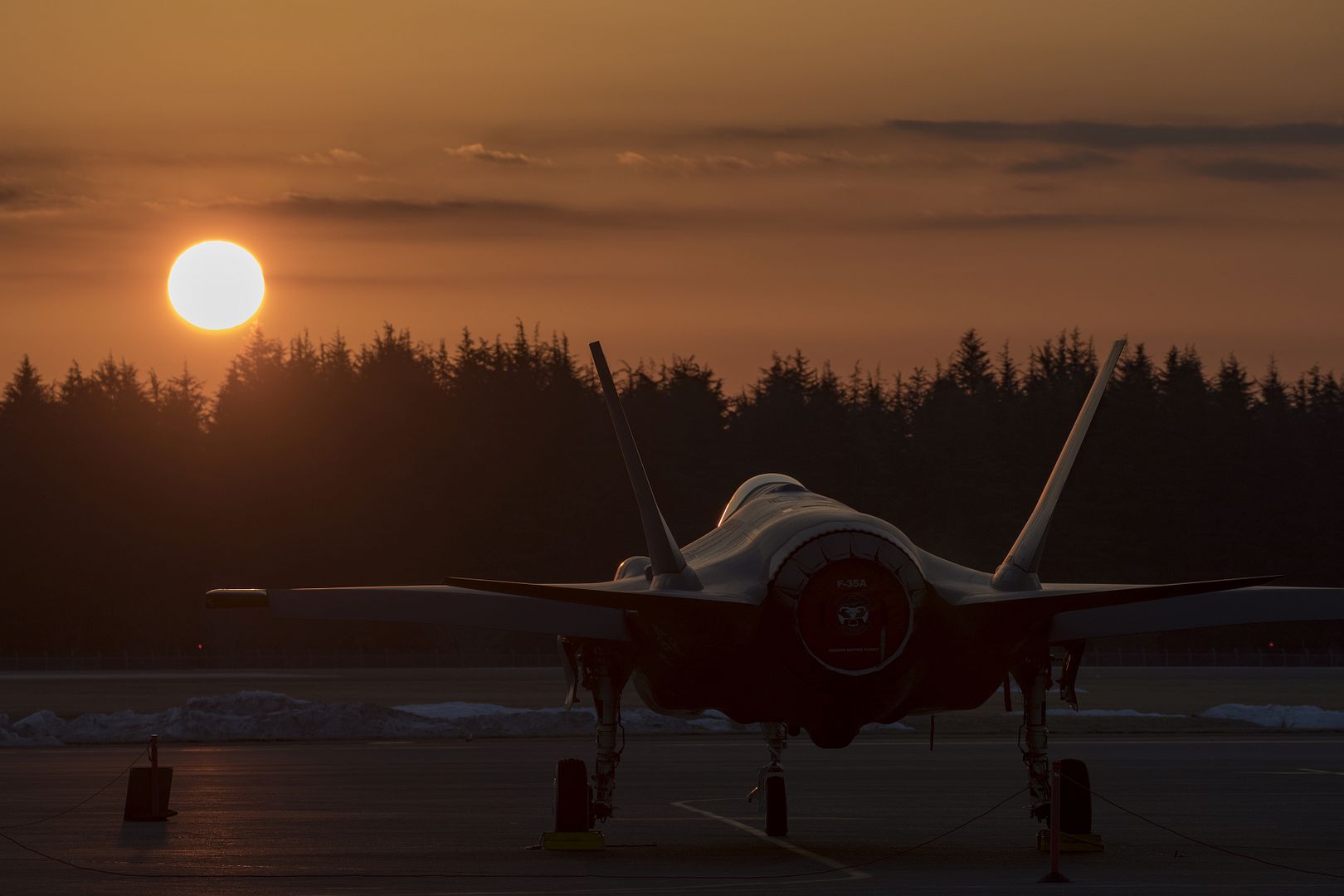
ARABIAN GULF (Feb. 10, 2018) An EA-18G Growler, assigned to the Cougars of Electronic Attack Squadron (VAQ) 139, launches from the flight deck of the aircraft carrier USS Theodore Roosevelt (CVN 71). Theodore Roosevelt and its carrier strike group are deployed to the U.S. 5th Fleet area of operations in support of maritime security operations to reassure allies and partners and preserve the freedom of navigation and the free flow of commerce in the region. (U.S. Navy photo by Mass Communication Specialist 3rd Class Alex Corona/Released)
MARIETTA, Ga., Feb. 12, 2018 /PRNewswire/ -- Lockheed Martin (NYSE: LMT) reached a major milestone with the delivery of its 400th C-130J Super Hercules aircraft on Feb. 9. This Super Hercules is an MC-130J Commando II Special Operations aircraft that is assigned to the U.S. Air Force's Special Operations Command (AFSOC).
The C-130J Super Hercules is the current production model of the legendary C-130 Hercules aircraft, with operators in 17 nations. To date, the global fleet of C-130Js has surpassed more than 1.7 million flight hours supporting almost any mission requirement ? any time, any place.
"We celebrate this accomplishment with our employees, industry partners and the Super Hercules operator community that spans 17 countries," said George Shultz, vice president and general manager, Air Mobility & Maritime Missions at Lockheed Martin. "These first 400 C-130Js meet a global demand for the proven performance and unmatched versatility found only in a Super Hercules. Its durability, relevancy and capability will continue to set the C-130J apart as the world's choice in tactical airlift for decades to come."
The C-130J is defined by its versatility. To date, the C-130J supports 17 different mission configurations to include transport (military and commercial), firefighting, search and rescue, Special Operations, weather reconnaissance, and aerial refueling.
This aircraft has another distinction in addition to being the 400th C-130J delivered: it is the 13th MC-130J to be converted into an AC-130J Ghostrider gunship. It will be assigned to the 1st Special Operations Wing at Hurlburt Field, Florida. The AC-130J is a highly modified C-130J that provides close-air support, air interdiction and armed reconnaissance.
The U.S. government operates the largest C-130J Super Hercules fleet in the world. This delivery represents the U.S. government's continued transition to the C-130J as the common platform across Air Mobility Command, AFSOC, Air Combat Command, U.S. Coast Guard and U.S. Marine Corps. The Air National Guard and Reserve still operate a mixed fleet of C-130J and legacy aircraft.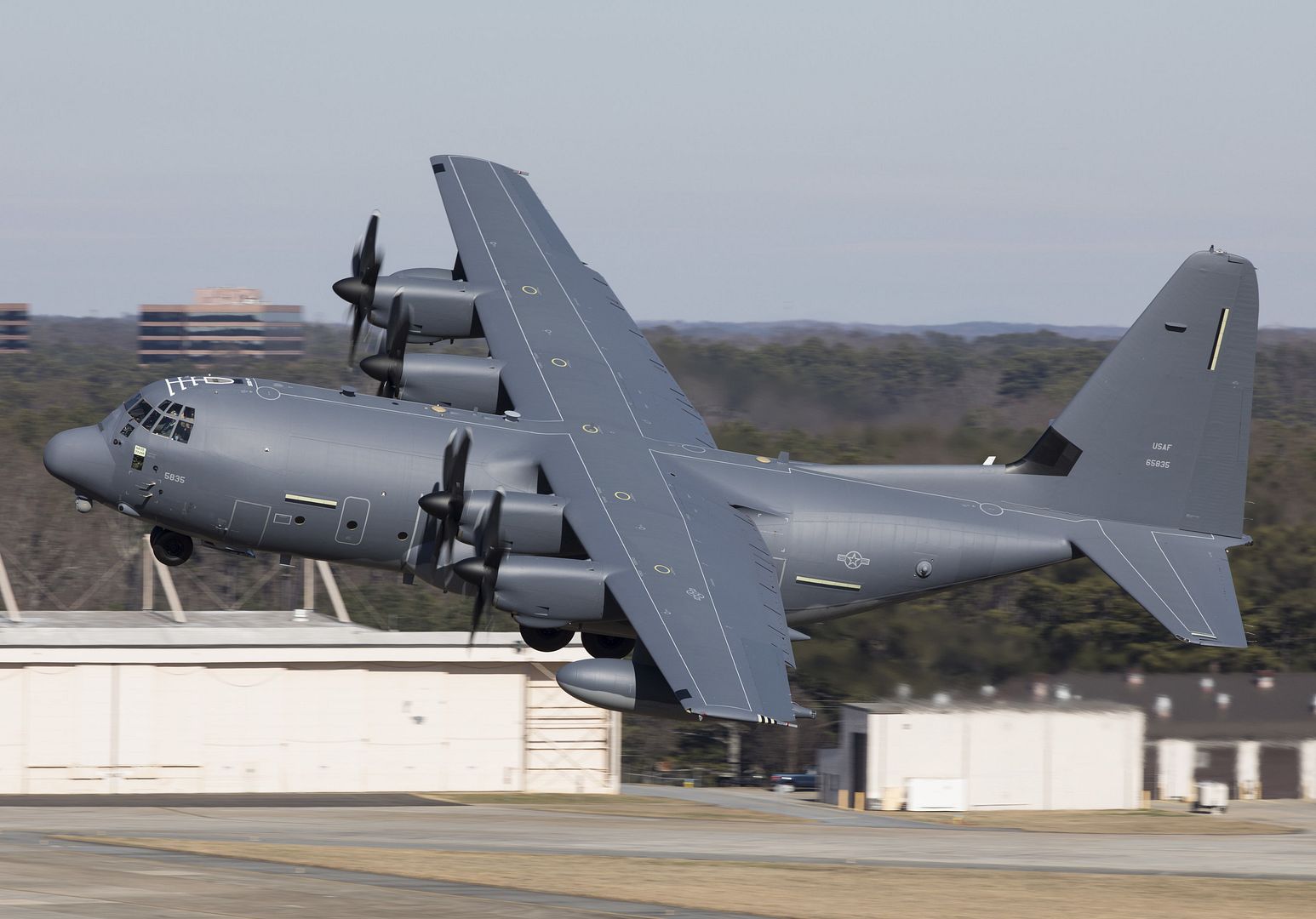
-
 Main AdminAn A-10C Thunderbolt II prepares to taxi during a training exercise at Davis-Monthan Air Force Base, Ariz., Feb. 12, 2018. The exercise was held to test readiness in response to a simulated deployment. (U.S. Air Force photo by Airman 1st Class Michael X. Beyer)
Main AdminAn A-10C Thunderbolt II prepares to taxi during a training exercise at Davis-Monthan Air Force Base, Ariz., Feb. 12, 2018. The exercise was held to test readiness in response to a simulated deployment. (U.S. Air Force photo by Airman 1st Class Michael X. Beyer)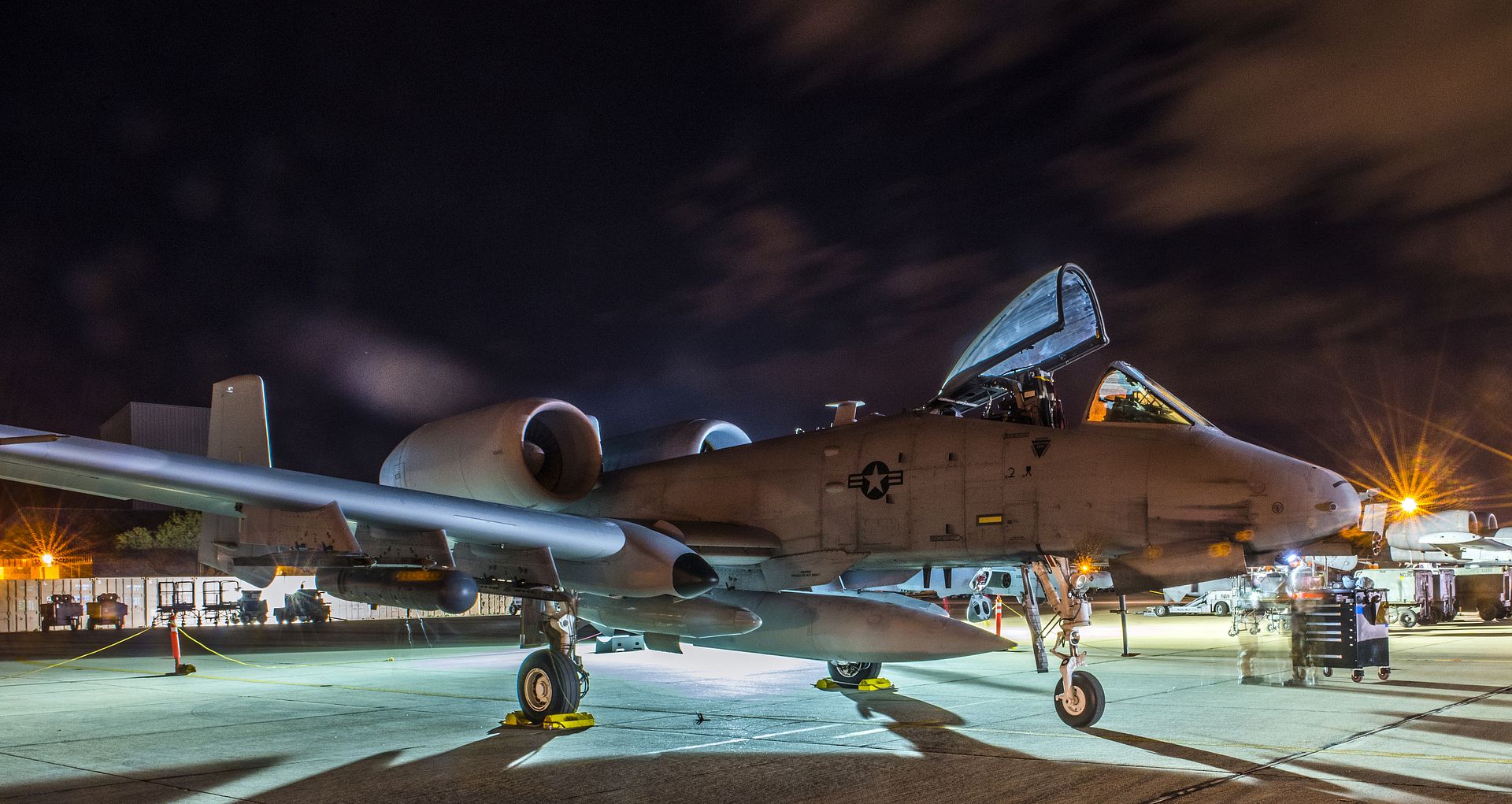
A U.S. Air Force A-10C Thunderbolt II takes off during the Bushwhacker 18-02 Cactus Flag exercise at Davis-Monthan Air Force Base, Ariz., Feb. 12, 2018. The Cactus Flag exercise is designed to test Davis-Monthan AFB's ability to deliver attack aircraft anywhere in the world. (U.S. Air Force photo by Airman 1st Class Frankie D. Moore)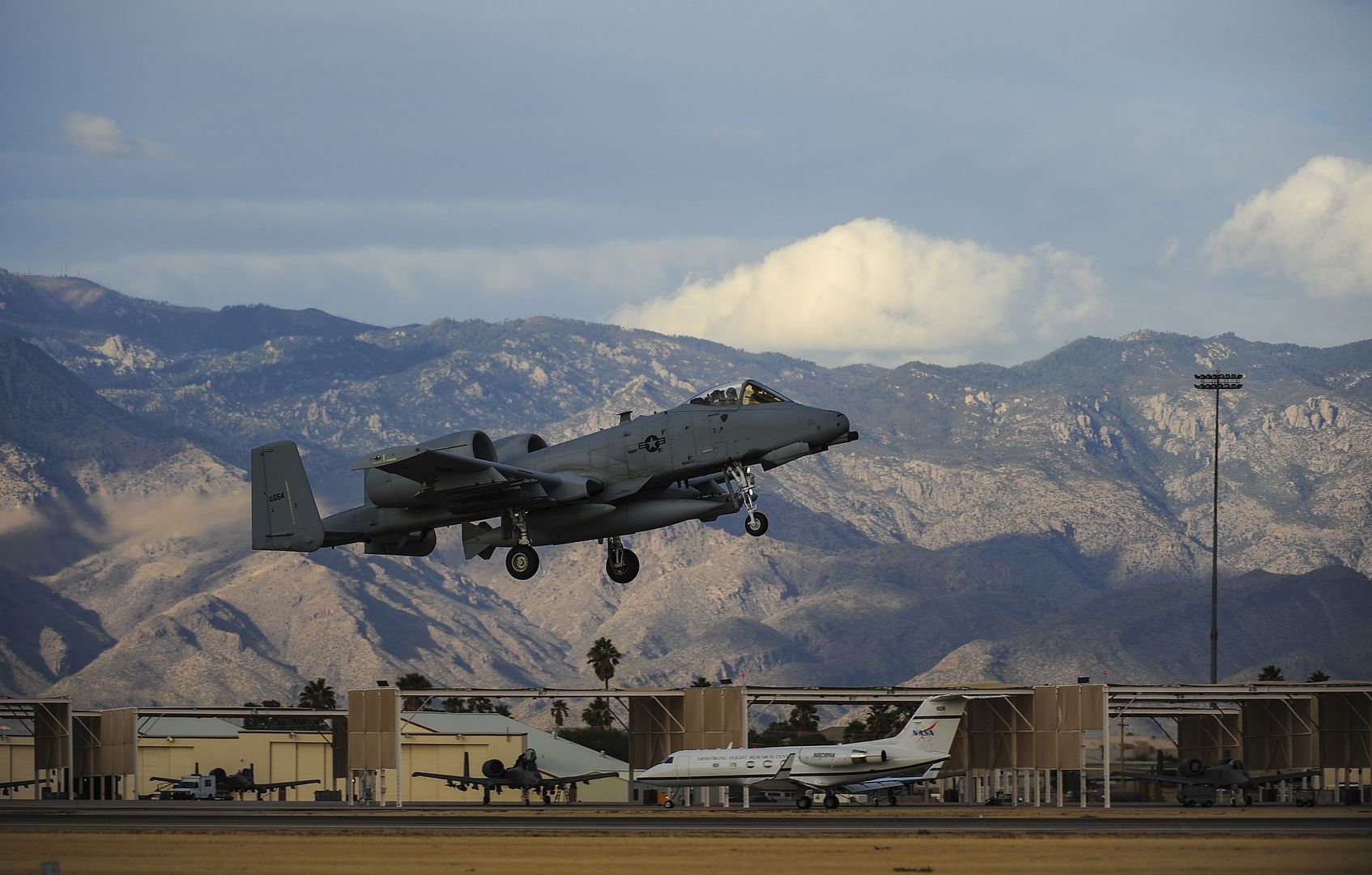
-
 Main AdminA U.S. Air Force RQ-4 Global Hawk logs over 20,000 flight hours Feb. 13, 2018 at Al Dhafra Air Base, United Arab Emirates. The Global Hawk's mission is to provide a broad spectrum of ISR collection capability to support joint combatant forces in worldwide peacetime, contingency and wartime operations. (U.S. Air Force photo by Airman 1st Class D. Blake Browning)
Main AdminA U.S. Air Force RQ-4 Global Hawk logs over 20,000 flight hours Feb. 13, 2018 at Al Dhafra Air Base, United Arab Emirates. The Global Hawk's mission is to provide a broad spectrum of ISR collection capability to support joint combatant forces in worldwide peacetime, contingency and wartime operations. (U.S. Air Force photo by Airman 1st Class D. Blake Browning)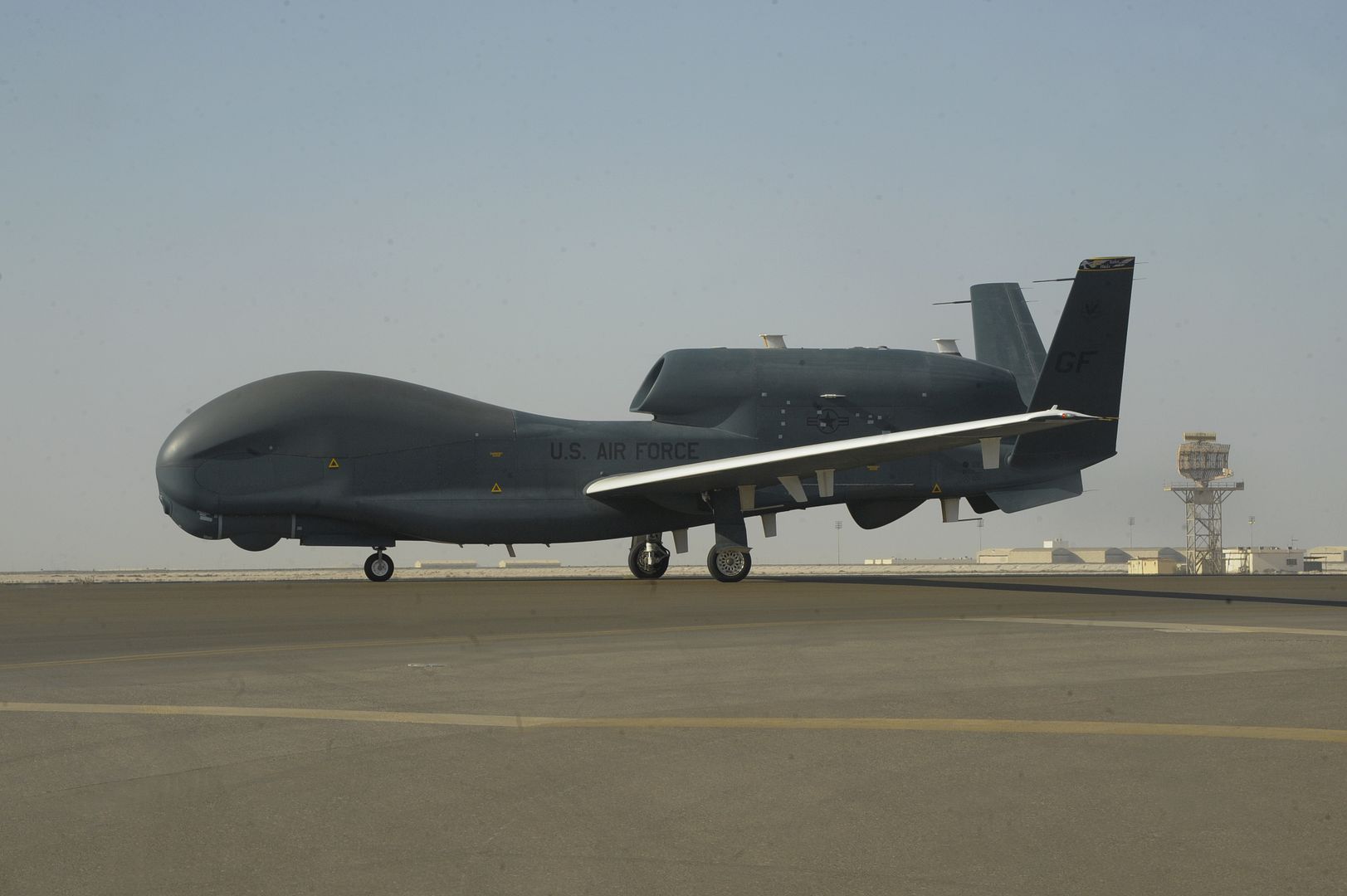
ATLANTIC OCEAN (Feb. 13, 2018) An F/A-18E Super Hornet, assigned to the "Sunliners" of Strike Fighter Squadron (VFA) 81, lands on the flight deck aboard USS Harry S. Truman (CVN 75). Truman is underway conducting a composite training unit exercise (COMPTUEX), which evaluates the strike group's ability as a whole to carry out sustained combat operations from the sea, ultimately certifying the Harry S. Truman Carrier Strike Group for deployment. (U.S. Navy photo by Mass Communication Specialist 2nd Class Anthony Flynn/Released)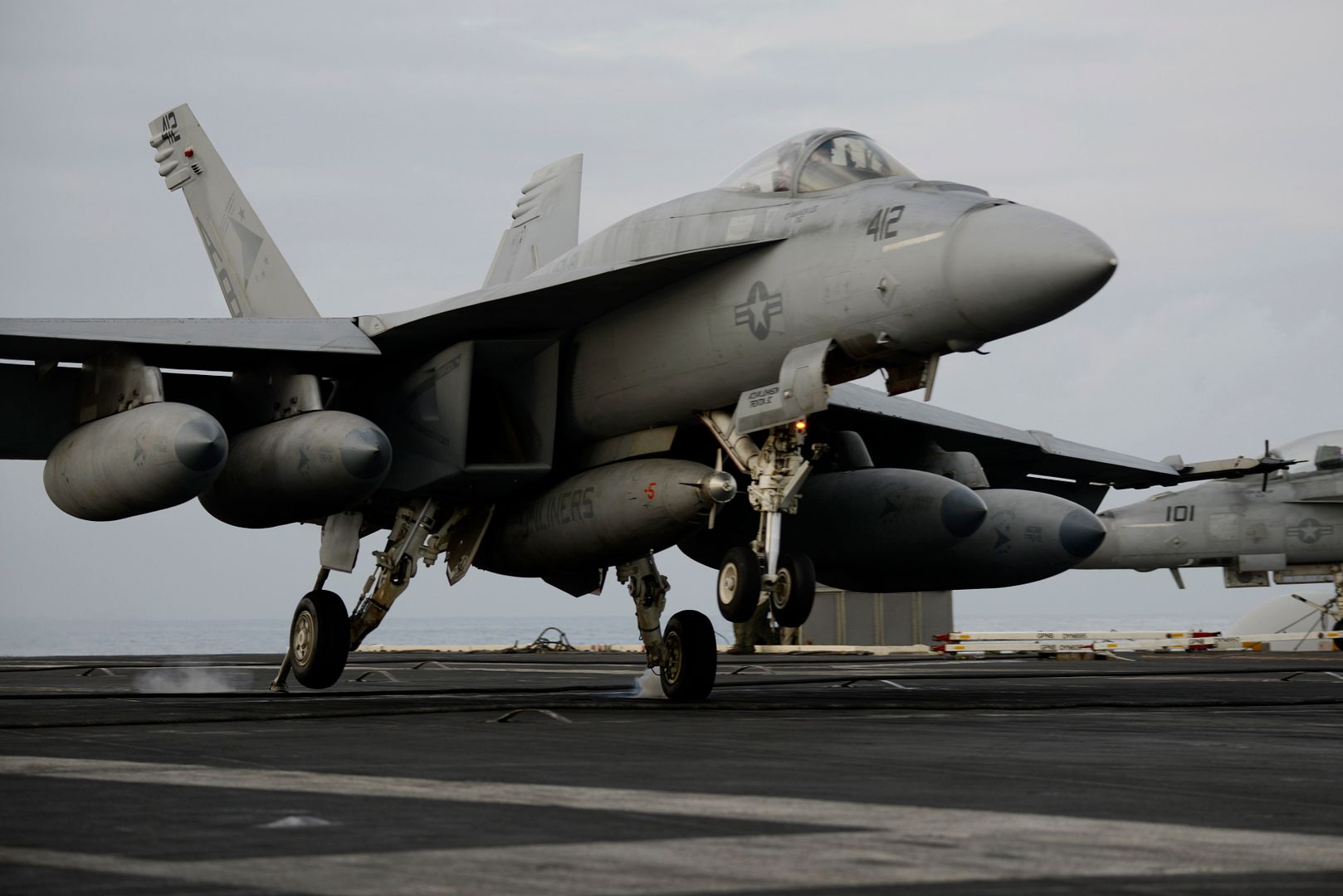
ATLANTIC OCEAN (Feb. 13, 2018) An F/A-18E Super Hornet, assigned to the "Knighthawks" of Strike Fighter Squadron (VFA) 136, launches from the flight deck aboard the aircraft carrier USS Harry S. Truman (CVN 75). Truman is underway conducting a composite training unit exercise (COMPTUEX), which evaluates the strike group's ability as a whole to carry out sustained combat operations from the sea, ultimately certifying the Harry S. Truman Carrier Strike Group for deployment. (U.S. Navy photo by Mass Communication Specialist 2nd Class Anthony Flynn/Released)
Nonstop Paris-New York flight demonstrates the jetliner?s capabilities, including on busy North Atlantic routes
The best-selling A320 Family marked a new milestone with yesterday?s Paris-to-New York nonstop flight flown by the A321LR ? demonstrating this jetliner version?s ability to serve new markets and operate on heavily-travelled North Atlantic routes with the highest levels of efficiency and comfort.
The LR designation is for ?long range? and with good reason: the A321LR has the longest range of any single-aisle commercial aircraft today, able to fly 7,400 kilometres nonstop.
Its ?long legs? are signified by the No. 1 A321LR?s livery featuring the Eiffel Tower and Statue of Liberty ? a representation of the Paris/New York route flown yesterday from Le Bourget Airport near the French capital to the New York region?s John F. Kennedy International Airport. The aircraft also is well suited for intra-regional airline segments in Asia, the United States and other markets.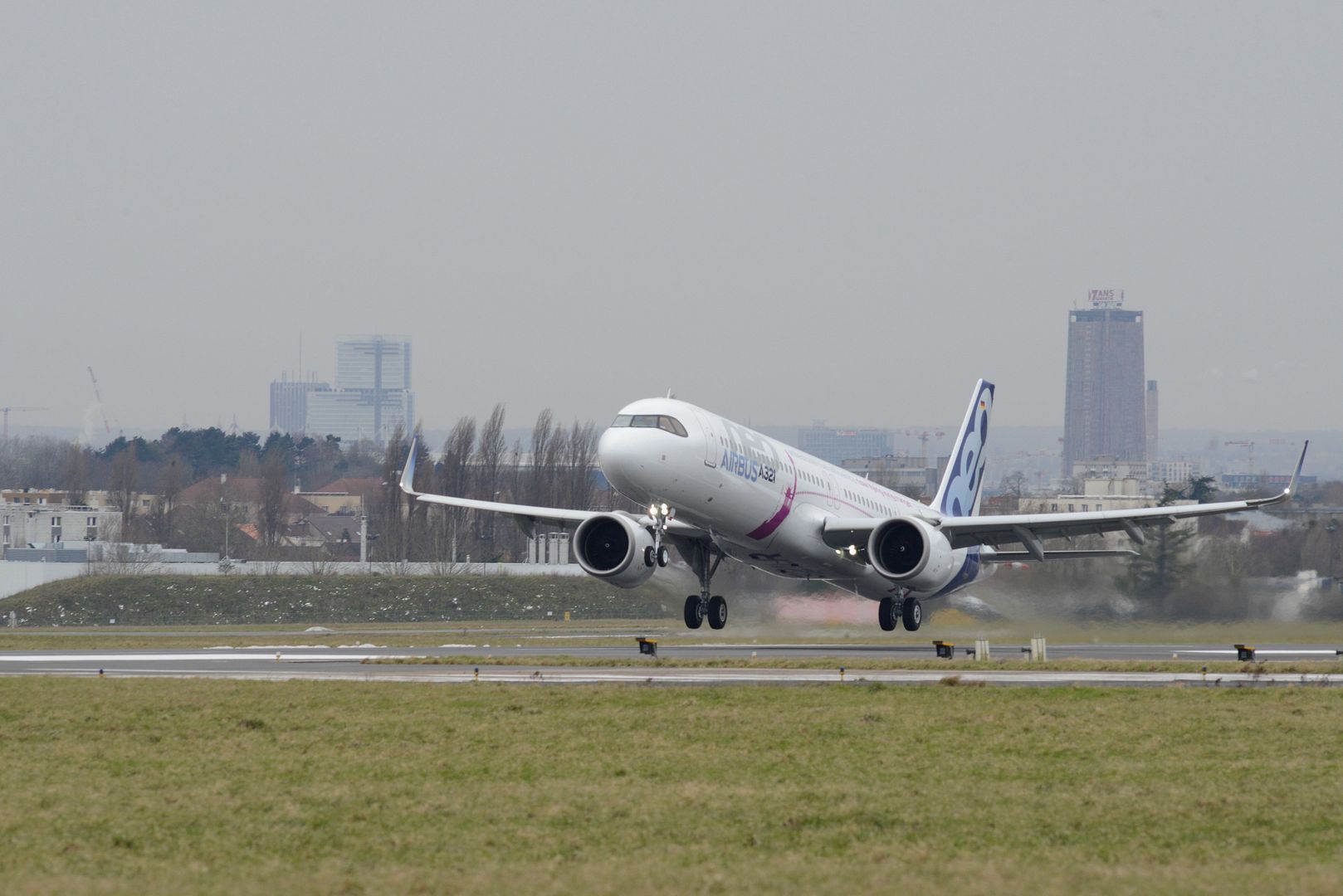
Improved aerodynamics and efficient jet engines
The A321LR?s unrivalled efficiency ? driven by aerodynamic improvements and state-of-the-art efficient turbofan jet engines ? has established its popularity among airlines, with Airbus already notching more than 100 orders for the aircraft; the first customer delivery is expected in late 2018. The interior of the A321LR will be passenger-pleasing as well, with unmatched comfort from the widest single-aisle cabin in the sky, comfortable seats, extra-large luggage bins and the latest in-flight-entertainment technology.
Operators can outfit the A321LR in state-of-the-art two-class configurations with full-flat seats for true long-haul comfort, or in a single-class layout capable of accommodating up to 240 passengers.
The A321LR is the next evolutionary step of Airbus? twin-engine A321neo that has captured more than an 80 percent share in its middle-of-the-market category. Airbus expects the A321LR to continue this trend, as it offers a thoroughly modern replacement for the large number of ageing narrowbody and widebody aircraft facing retirement in the coming years.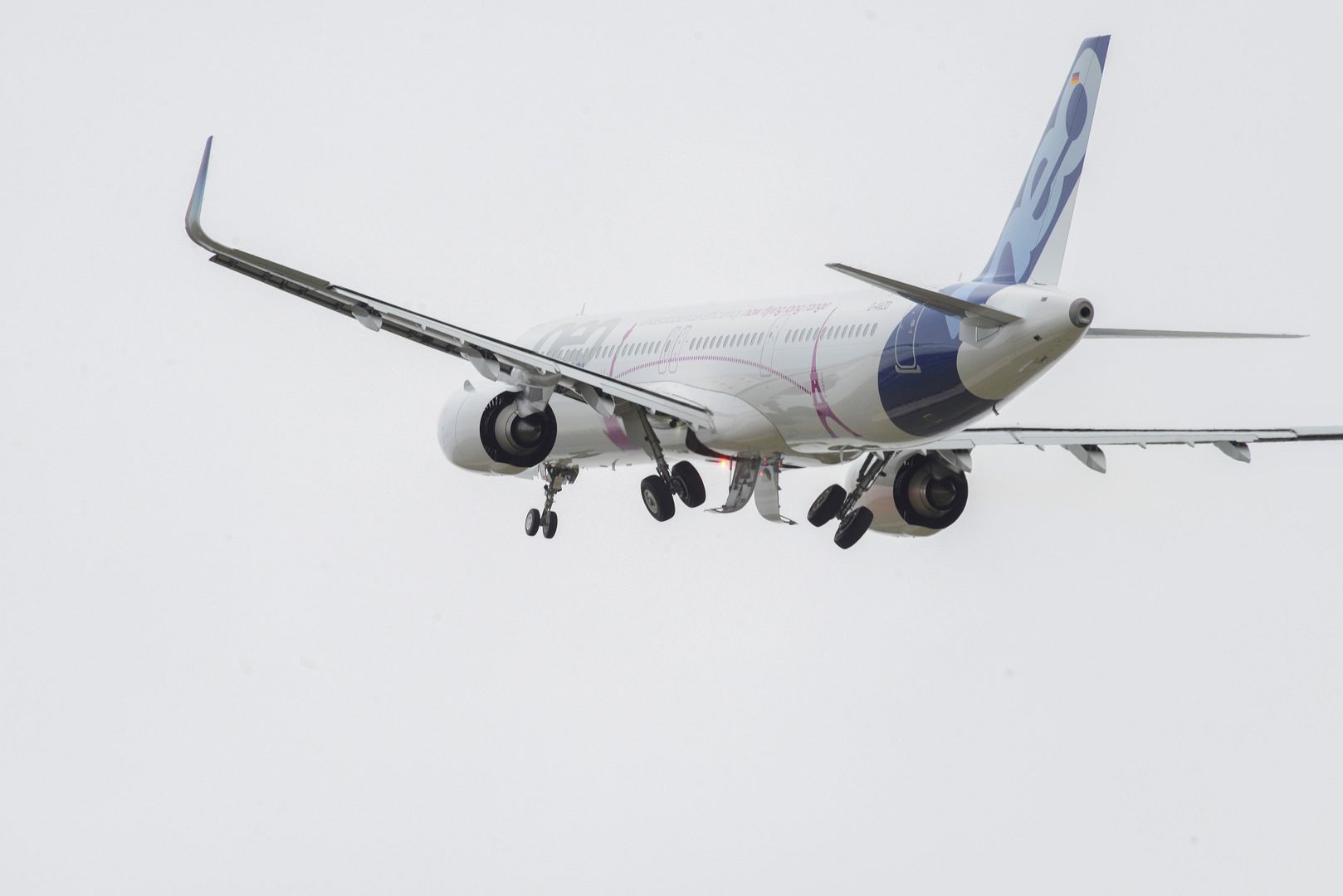
Value from continual investment in the A320 Family
Airbus continuously invests in the A320 Family ? some $300 million per year ? to keep this jetliner product line at the leading edge of technology, thereby creating value for its customers and providing continued comfort for passengers.
The A321LR performed its maiden flight on 31 January of this year. Yesterday?s transcontinental flight, with the aircraft powered by two CFM International LEAP-1A engines, is part of nearly 100 hours of flight tests in advance of the jetliner?s airworthiness certification, expected in the second quarter of 2018.
XI(F) Squadron, from Royal Air Force Coningsby have entered week 3 of Exercise Red Flag, the world?s largest air combat exercise.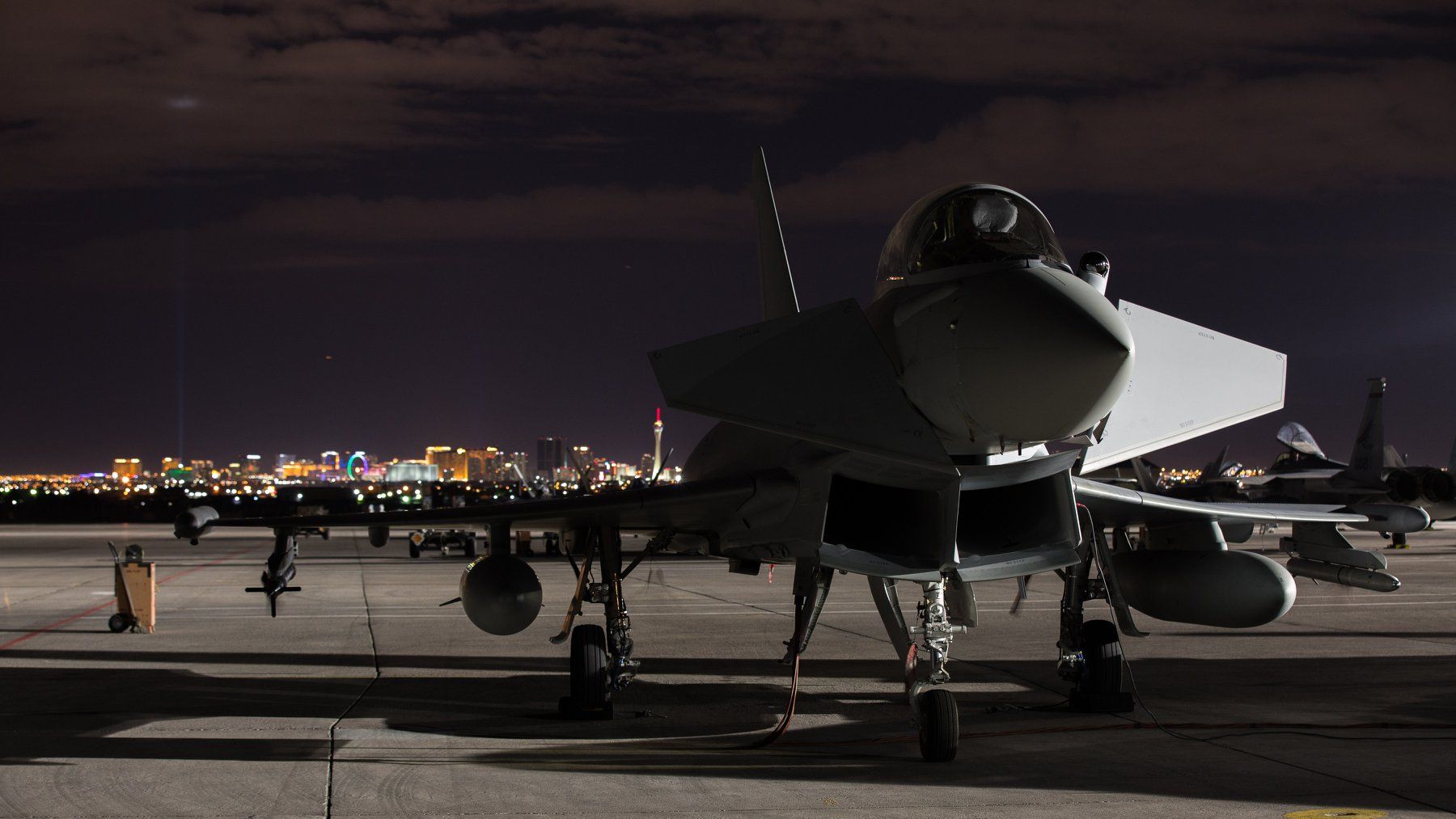
Held at Nellis Air Force Base in Nevada, XI(F) Squadron has been training alongside coalition partners, helping all participants to understand each other?s capabilities in preparation for future potential operations.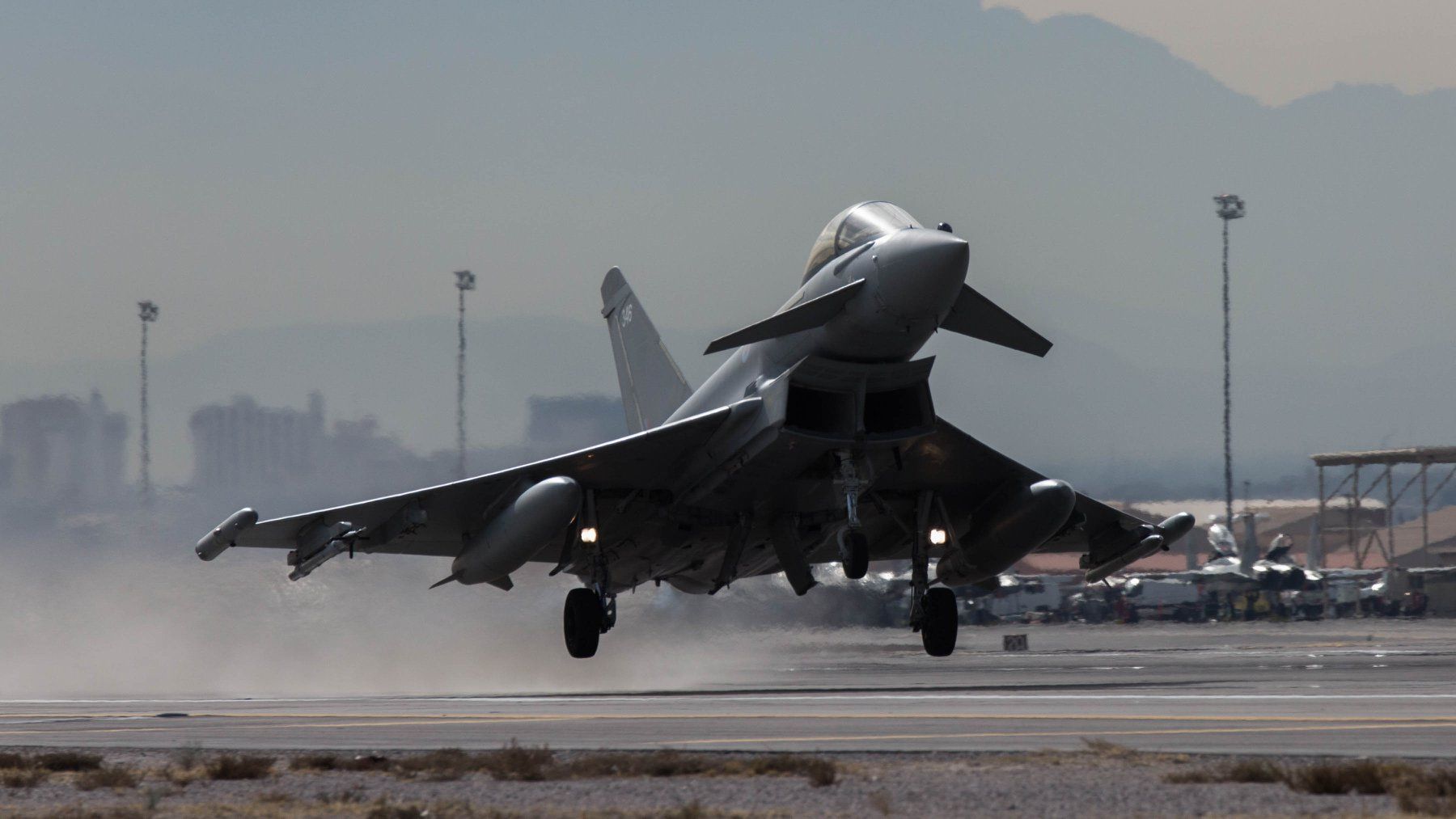
XI(F) Sqn has been operating alongside Royal Air Force Voyager, manned by personnel from 10 and 101 Squadron, this has provided a key air-to-air refuelling capability for XI(F) Sqn aircraft during the exercise.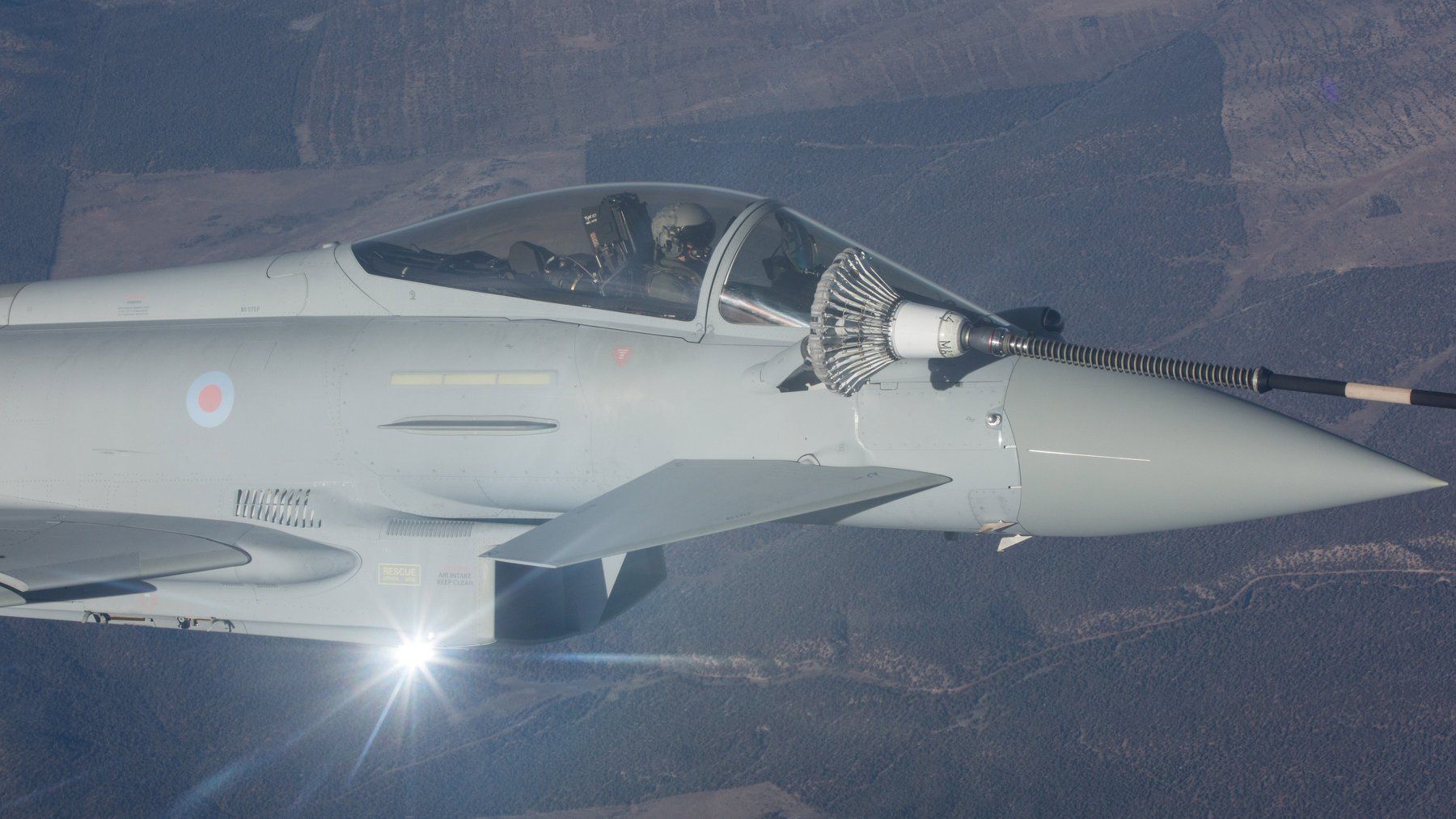
Images: SAC James Skerrett, RAF Coningsby.
-
 Main AdminA U.S Air Force KC-10 Extender with the 76th Air Refueling Squadron, 514th Air Mobility Wing, moves in to be refueled by a KC-10 crewed by Reserve Citizen Airmen with the 78th Air Refueling Squadron, 514th Air Mobility Wing, over the Atlantic Ocean, Feb. 14, 2018. The 514th Air is an Air Force Reserve Command unit located at Joint Base McGuire-Dix-Lakehurst, N.J. (U.S. Air Force photo by Master Sgt. Mark C. Olsen)
Main AdminA U.S Air Force KC-10 Extender with the 76th Air Refueling Squadron, 514th Air Mobility Wing, moves in to be refueled by a KC-10 crewed by Reserve Citizen Airmen with the 78th Air Refueling Squadron, 514th Air Mobility Wing, over the Atlantic Ocean, Feb. 14, 2018. The 514th Air is an Air Force Reserve Command unit located at Joint Base McGuire-Dix-Lakehurst, N.J. (U.S. Air Force photo by Master Sgt. Mark C. Olsen)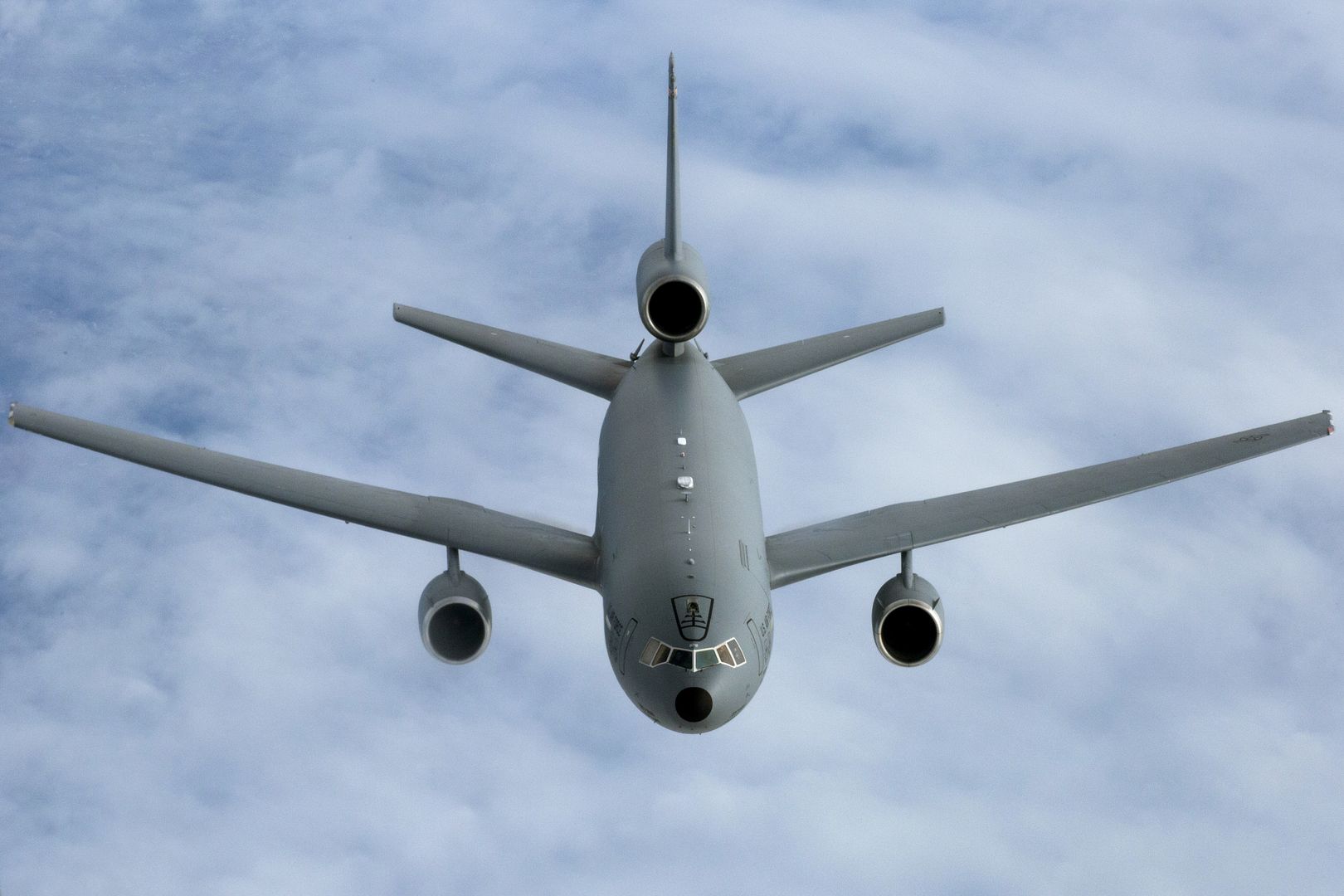
A U.S Air Force KC-10 Extender with the 76th Air Refueling Squadron, 514th Air Mobility Wing, is refueled by a KC-10 crewed by Reserve Citizen Airmen with the 78th Air Refueling Squadron, 514th Air Mobility Wing, over the Atlantic Ocean, Feb. 14, 2018. The 514th Air is an Air Force Reserve Command unit located at Joint Base McGuire-Dix-Lakehurst, N.J. (U.S. Air Force photo by Master Sgt. Mark C. Olsen)
A U.S Air Force KC-10 Extender with the 76th Air Refueling Squadron, 514th Air Mobility Wing, moves away after being refueled by a KC-10 crewed by Reserve Citizen Airmen with the 78th Air Refueling Squadron, 514th Air Mobility Wing, over the Atlantic Ocean, Feb. 14, 2018. The 514th Air is an Air Force Reserve Command unit located at Joint Base McGuire-Dix-Lakehurst, N.J. (U.S. Air Force photo by Master Sgt. Mark C. Olsen)
A U.S Air Force F-22 Raptor with the 1st Fighter Wing, Joint Base Langley-Eustis, Va., moves away after being refueled by a KC-10 Extender with the 78th Air Refueling Squadron, 514th Air Mobility Wing, over the Atlantic Ocean, Feb. 14, 2018. The 514th Air is an Air Force Reserve Command unit located at Joint Base McGuire-Dix-Lakehurst, N.J. (U.S. Air Force photo by Master Sgt. Mark C. Olsen)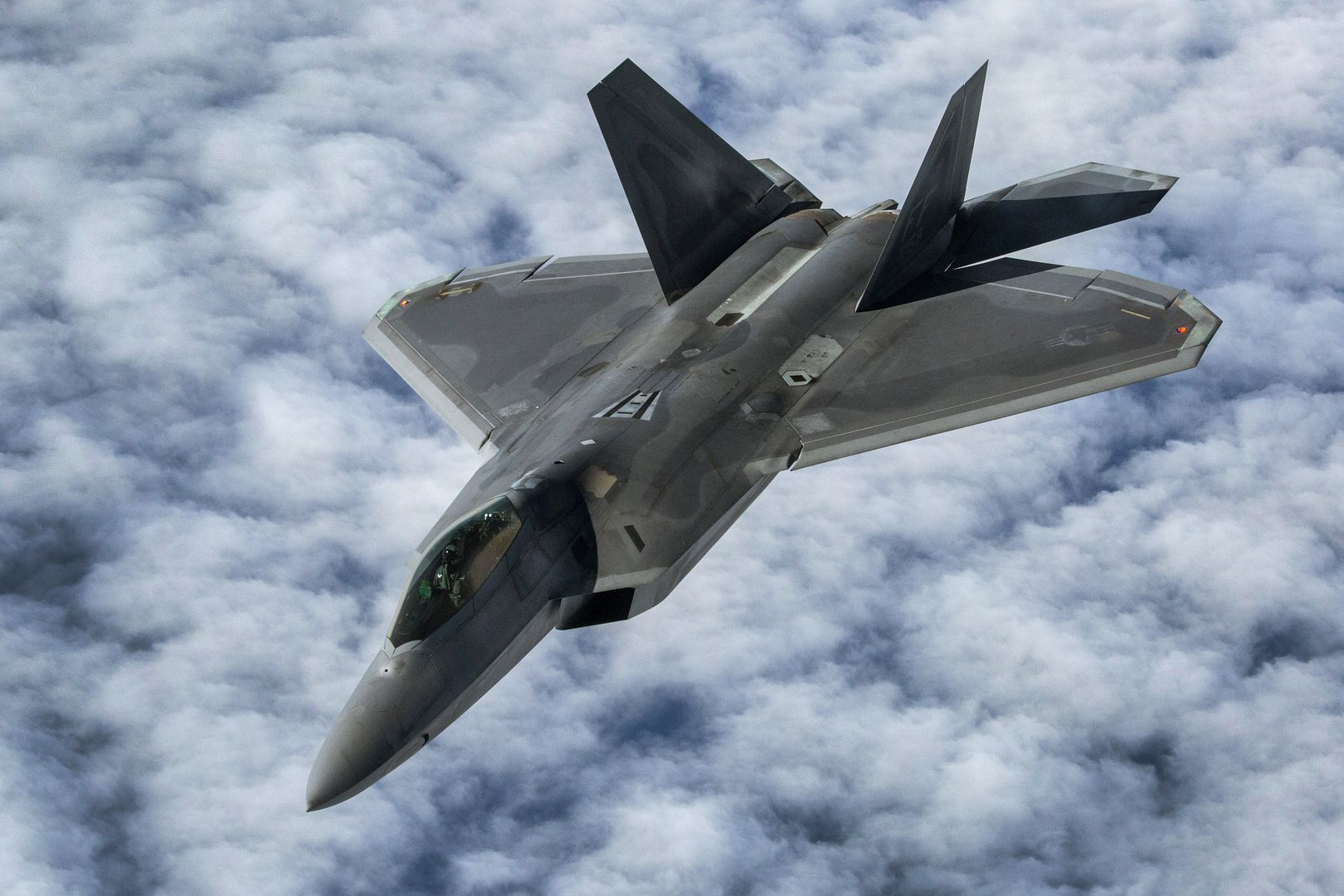
Contrails peel away from a U.S. Air Force KC-10 Extender crewed by Reserve Citizen Airmen with the 76th Air Refueling Squadron, 514th Air Mobility Wing, over the Atlantic Ocean, Feb. 14, 2018. The 514th Air is an Air Force Reserve Command unit located at Joint Base McGuire-Dix-Lakehurst, N.J. (U.S. Air Force photo by Master Sgt. Mark C. Olsen)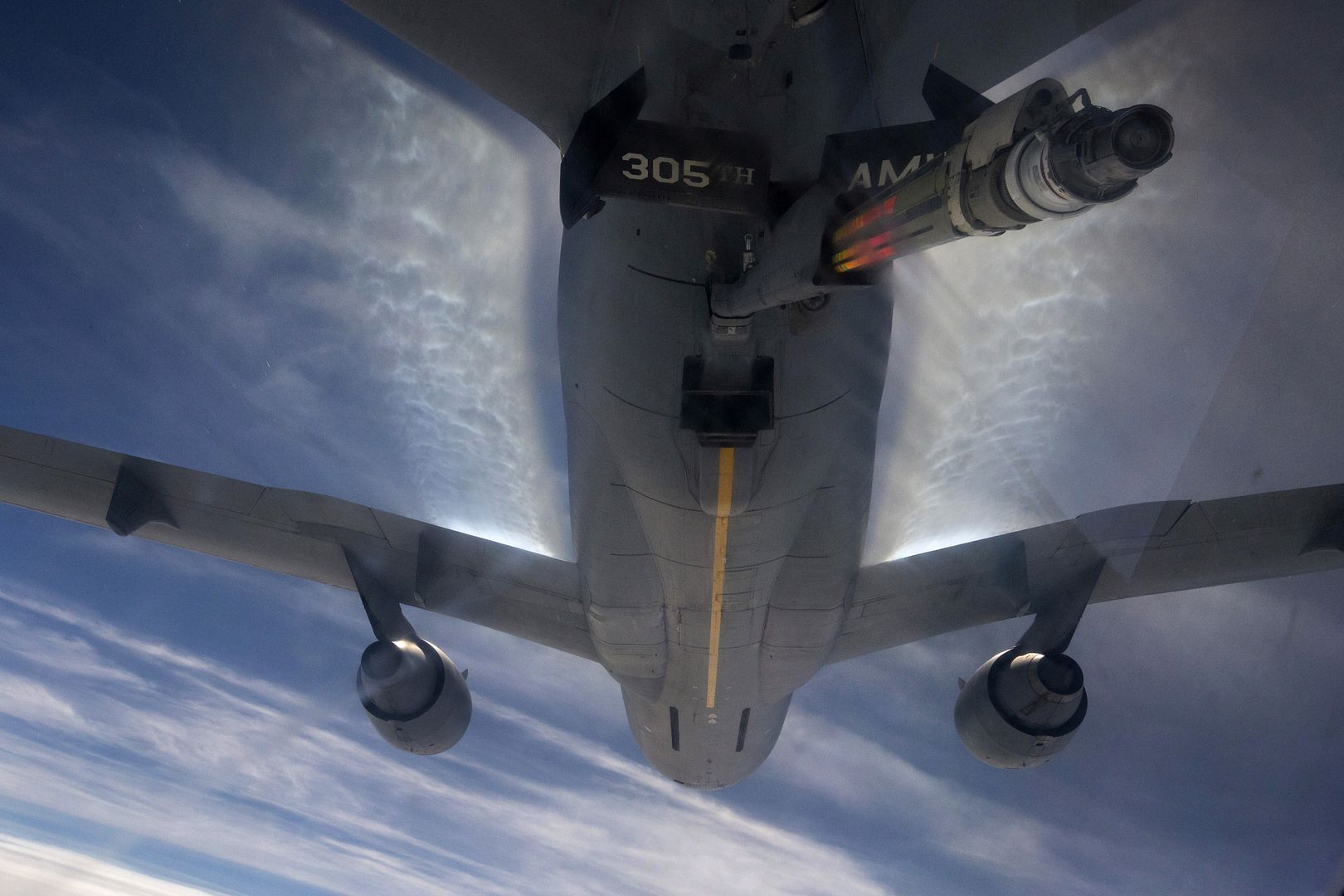
JACKSONVILLE, Fla. (Feb. 13, 2018) An F/A-18 Hornet was hoisted off its racks temporarily at Fleet Readiness Center Southeast. The plane is receiving a center-barrel replacement among other maintenance at the facility aboard Naval Air Station Jacksonville. Planes designated for center-barrel replacement, the piece of the fuselage between the wings, are literally split in half, then put back together with a new center barrel. (U.S. Navy photo by Clifford Davis/Released)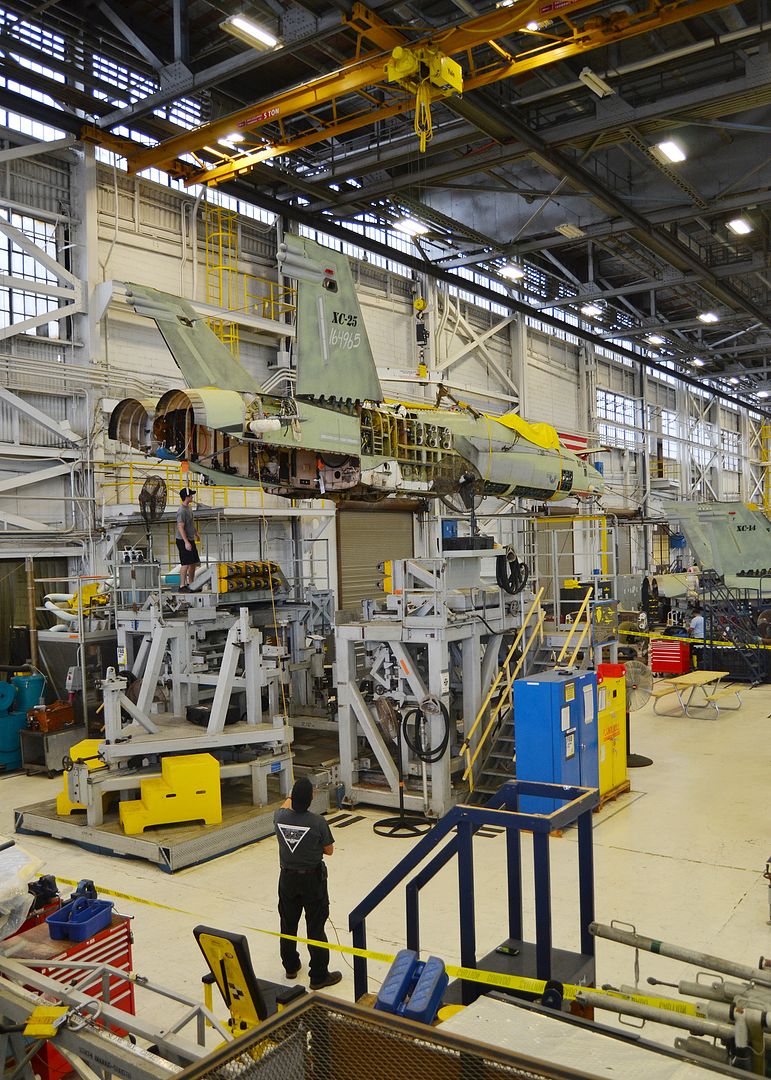
PATUXENT RIVER, Md. (Feb. 1, 2018) Dan Levin, F-35 Pax River Integrated Test Force, pilots BF-3 on its 691st flight for a flutter and buffet test mission at Naval Air Station Patuxent River with external weapons. This flight, shown with external 2,000 pound and 1,000 pound GBUs and AIM-9x weapons, is one of the final flight tests for the F-35B in the system development and demonstration phase. (U.S. Navy photo's by Dane Wiedmann/Released)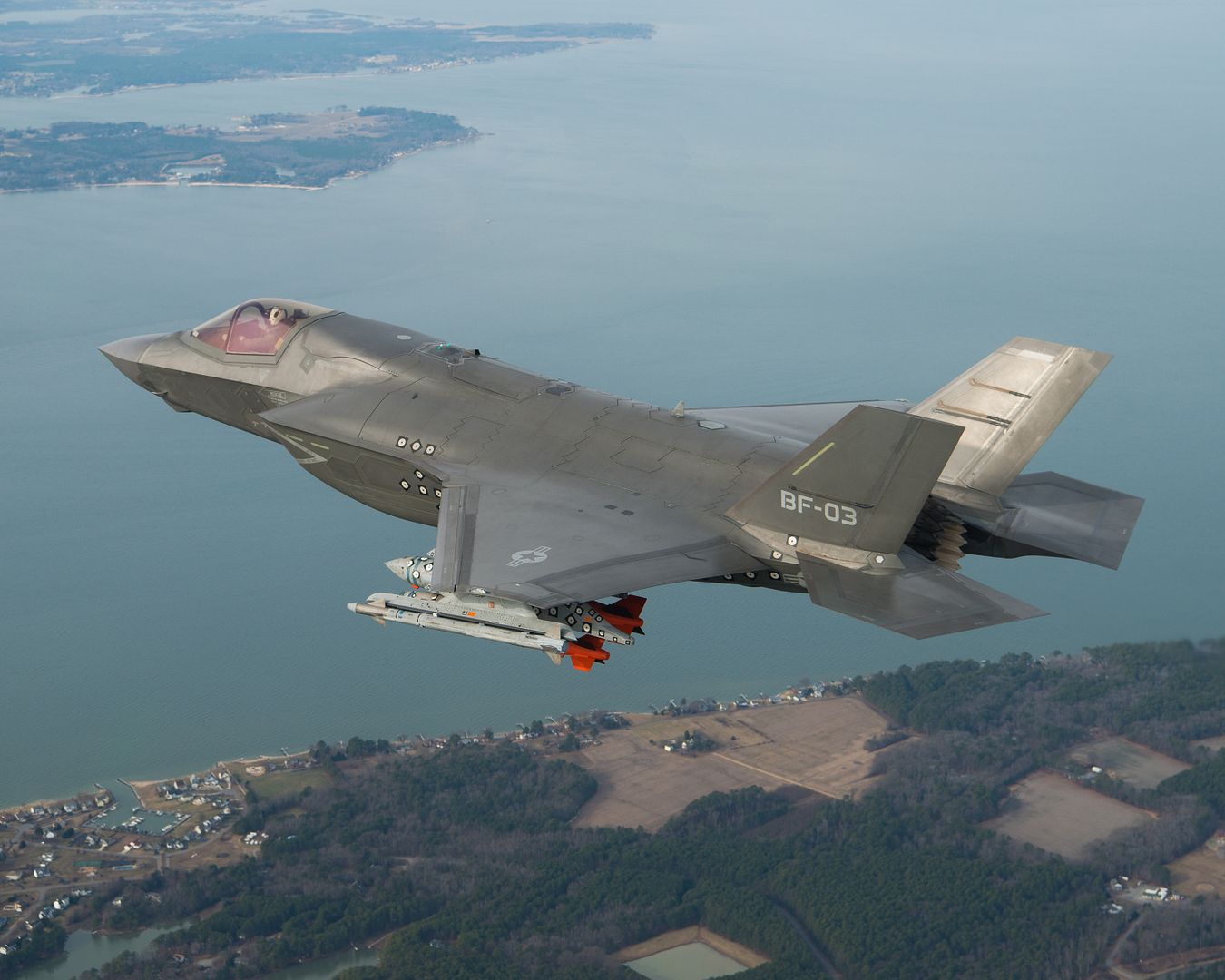
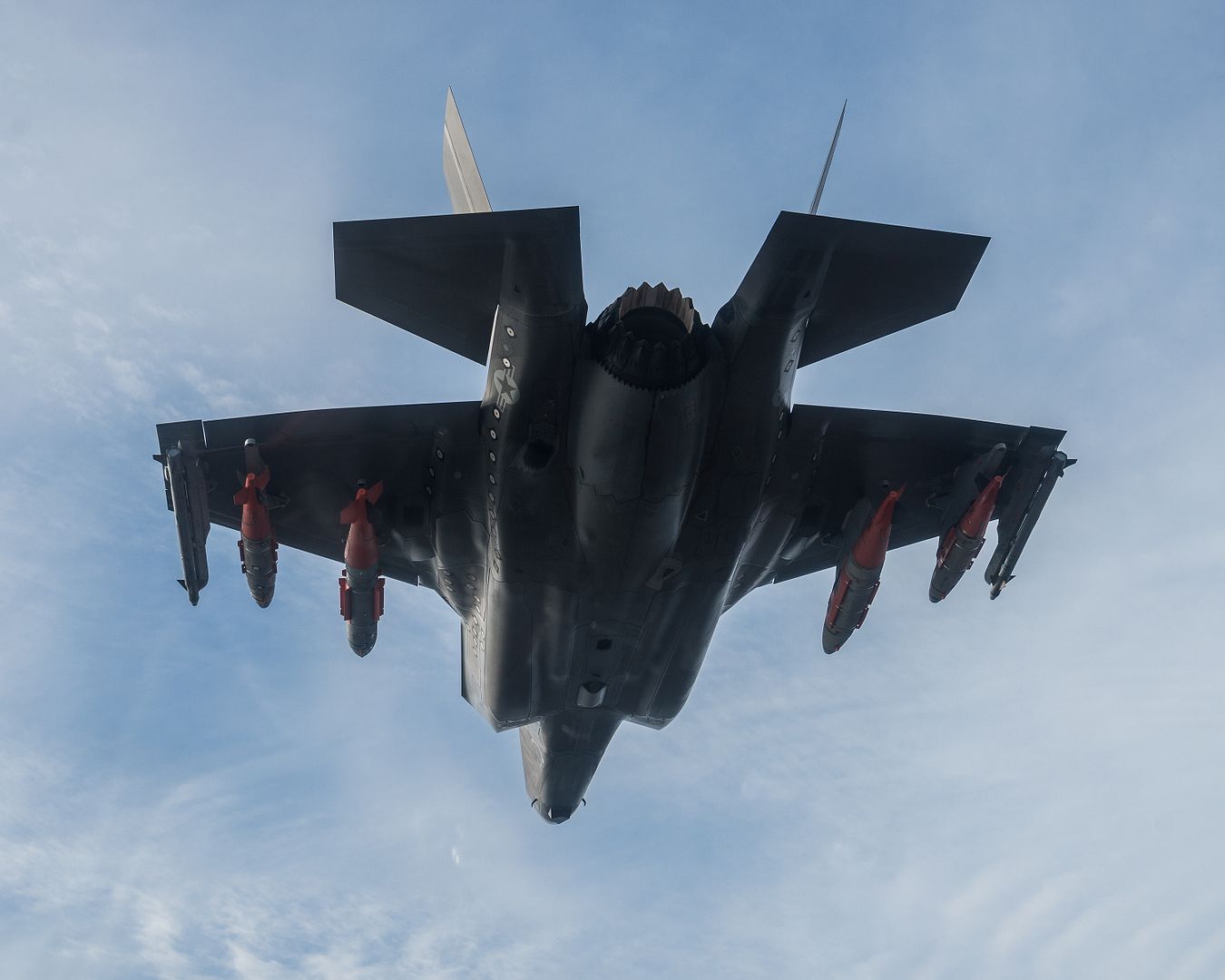
-
 Main AdminATLANTIC OCEAN (Feb. 14, 2018) A CH-53E Super Stallion, attached to Marine Medium Tiltrotor Squadron 162, prepares to land on the flight deck aboard the amphibious assault ship USS Iwo Jima (LHD 7). The Iwo Jima Amphibious Ready Group (ARG) is deployed in support of maritime security operations and theater security cooperation efforts in Europe and the Middle East. The Iwo Jima ARG embarks the 26th Marine Expeditionary Unit and includes Iwo Jima, the amphibious transport dock ship USS New York (LPD 21), the dock landing ship USS Oak Hill (LSD 51), Fleet Surgical Team 8, Helicopter Sea Combat Squadron 28, Tactical Air Control Squadron 22, components of Naval Beach Group 2 and the embarked staff of Amphibious Squadron 4. (U.S. Navy photo's by Mass Communication Specialist 3rd Class Joe J. Cardona Gonzalez/Released)
Main AdminATLANTIC OCEAN (Feb. 14, 2018) A CH-53E Super Stallion, attached to Marine Medium Tiltrotor Squadron 162, prepares to land on the flight deck aboard the amphibious assault ship USS Iwo Jima (LHD 7). The Iwo Jima Amphibious Ready Group (ARG) is deployed in support of maritime security operations and theater security cooperation efforts in Europe and the Middle East. The Iwo Jima ARG embarks the 26th Marine Expeditionary Unit and includes Iwo Jima, the amphibious transport dock ship USS New York (LPD 21), the dock landing ship USS Oak Hill (LSD 51), Fleet Surgical Team 8, Helicopter Sea Combat Squadron 28, Tactical Air Control Squadron 22, components of Naval Beach Group 2 and the embarked staff of Amphibious Squadron 4. (U.S. Navy photo's by Mass Communication Specialist 3rd Class Joe J. Cardona Gonzalez/Released)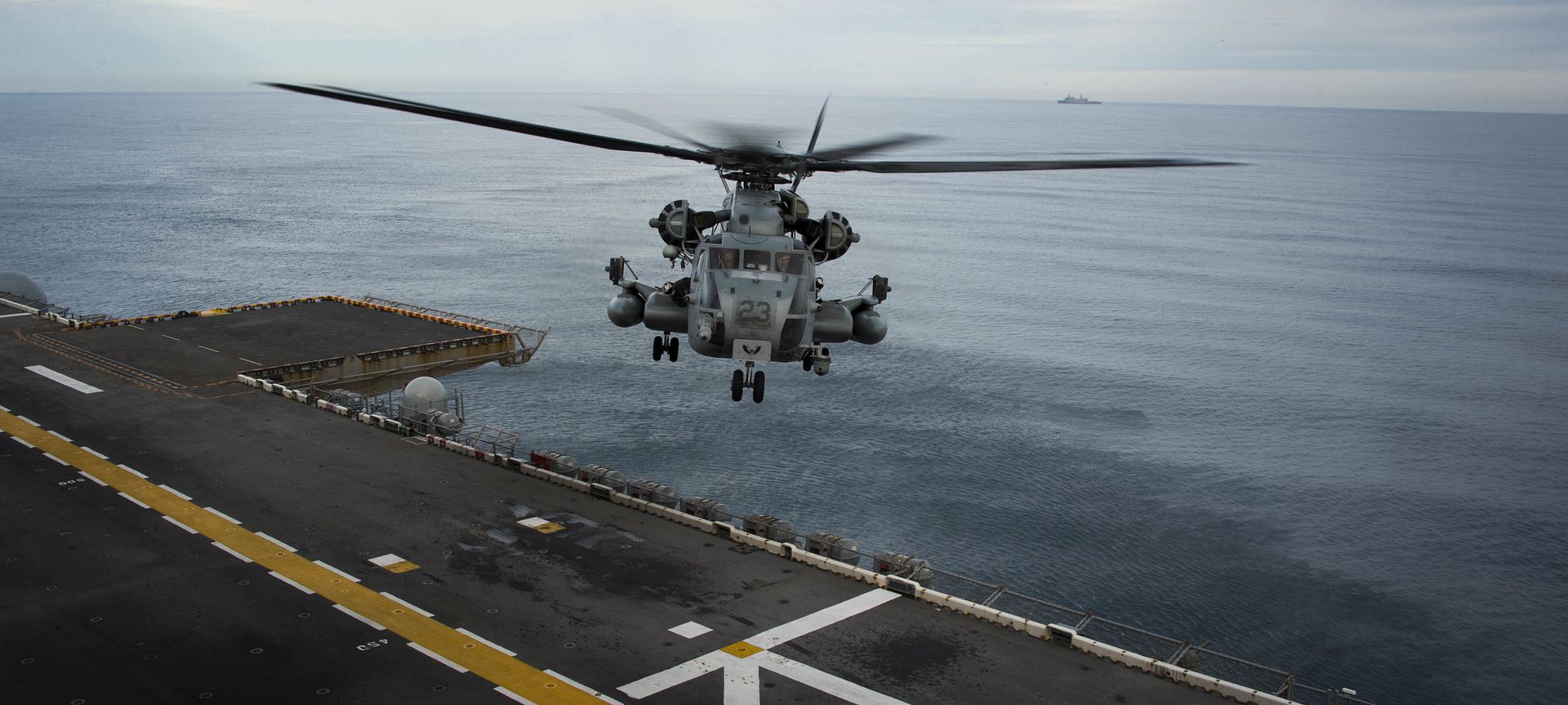

Media agencies visit Kadena to capture footage for future products Feb. 12-14, 2018, at Kadena Air Base, Japan. The news agencies visited Kadena to showcase the mission and operations of the base. (U.S. Air Force photo's by Airman 1st Class Greg Erwin)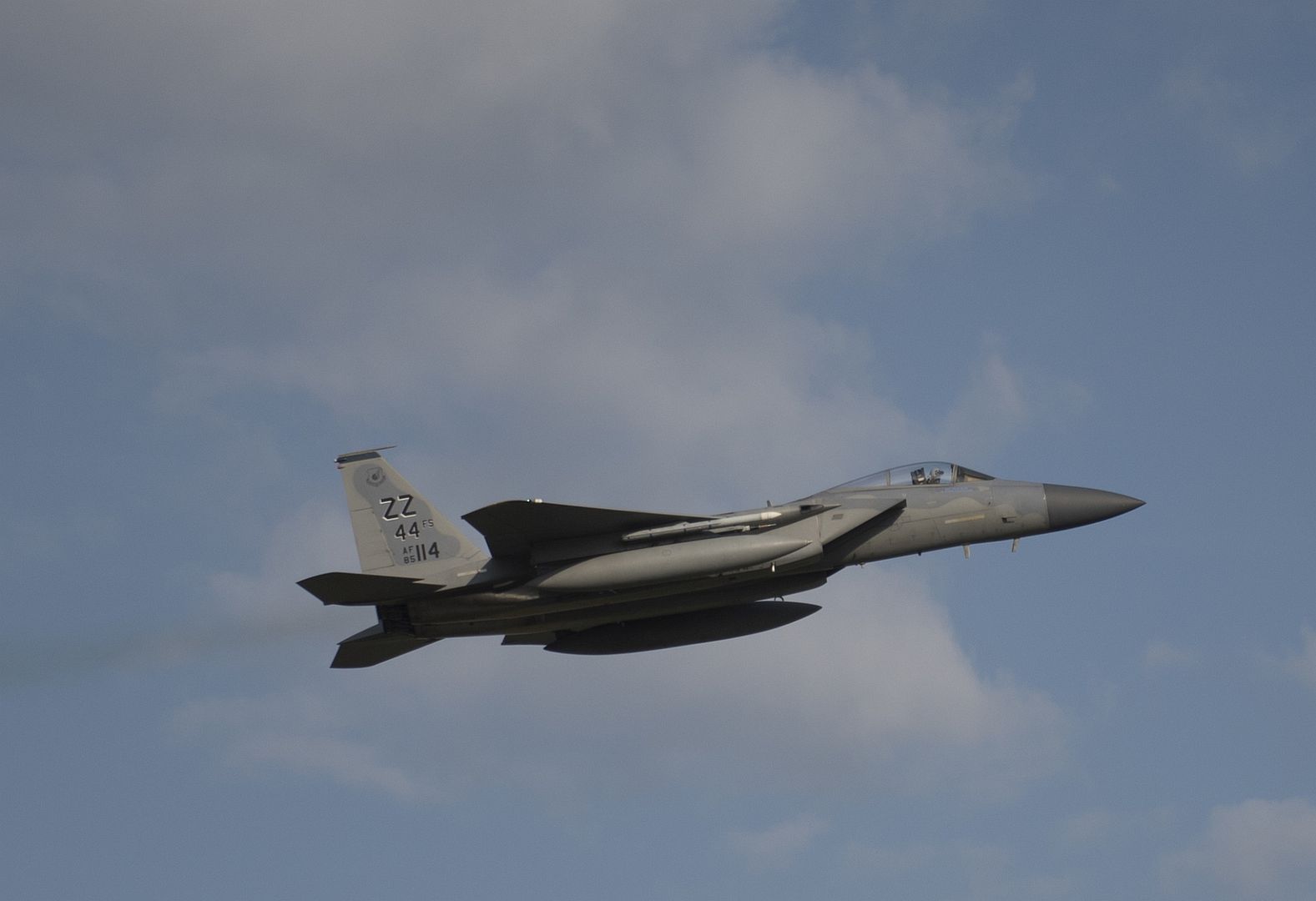
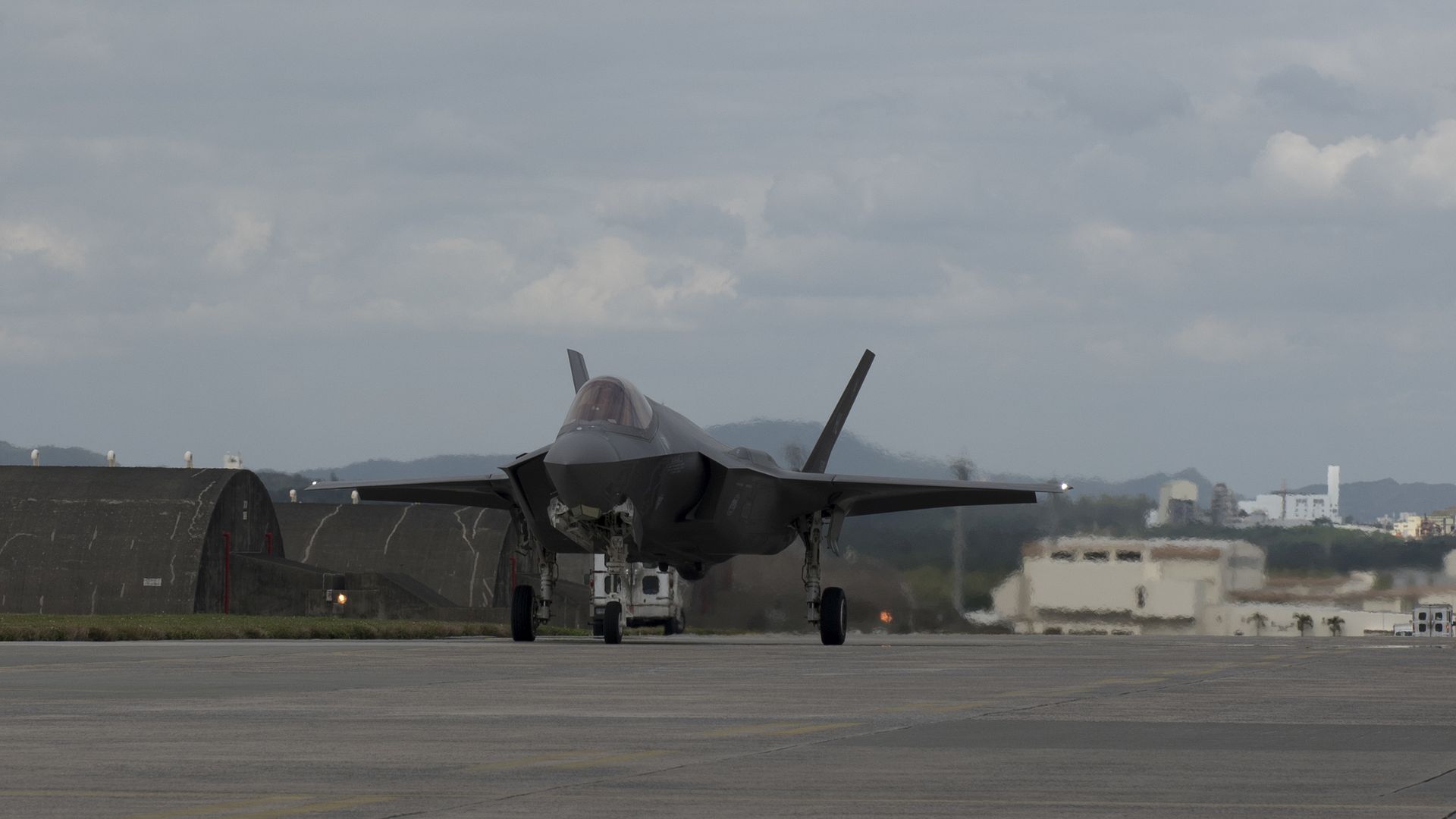
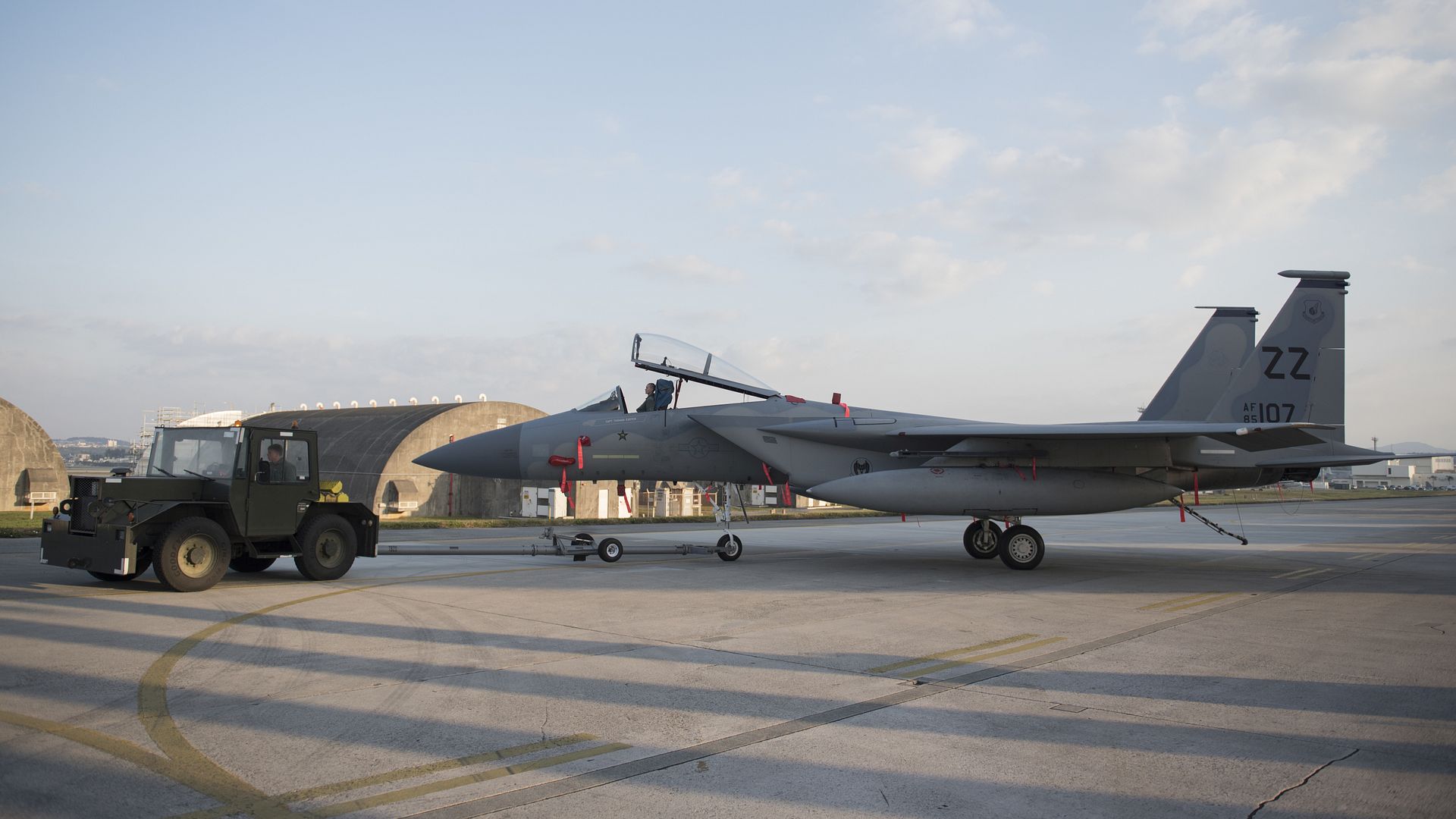

A U.S Air Force KC-10 Extender crewed by Reserve Citizen Airmen with the 76th Air Refueling Squadron, 514th Air Mobility Wing, refuels a B-52H Stratofortress with the 5th Bomb Wing from Minot Air Force Base, N.D., over Canada Feb. 15, 2018. The 514th is an Air Force Reserve Command unit located at Joint Base McGuire-Dix-Lakehurst, N.J. (U.S. Air Force photo's by Master Sgt. Mark C. Olsen)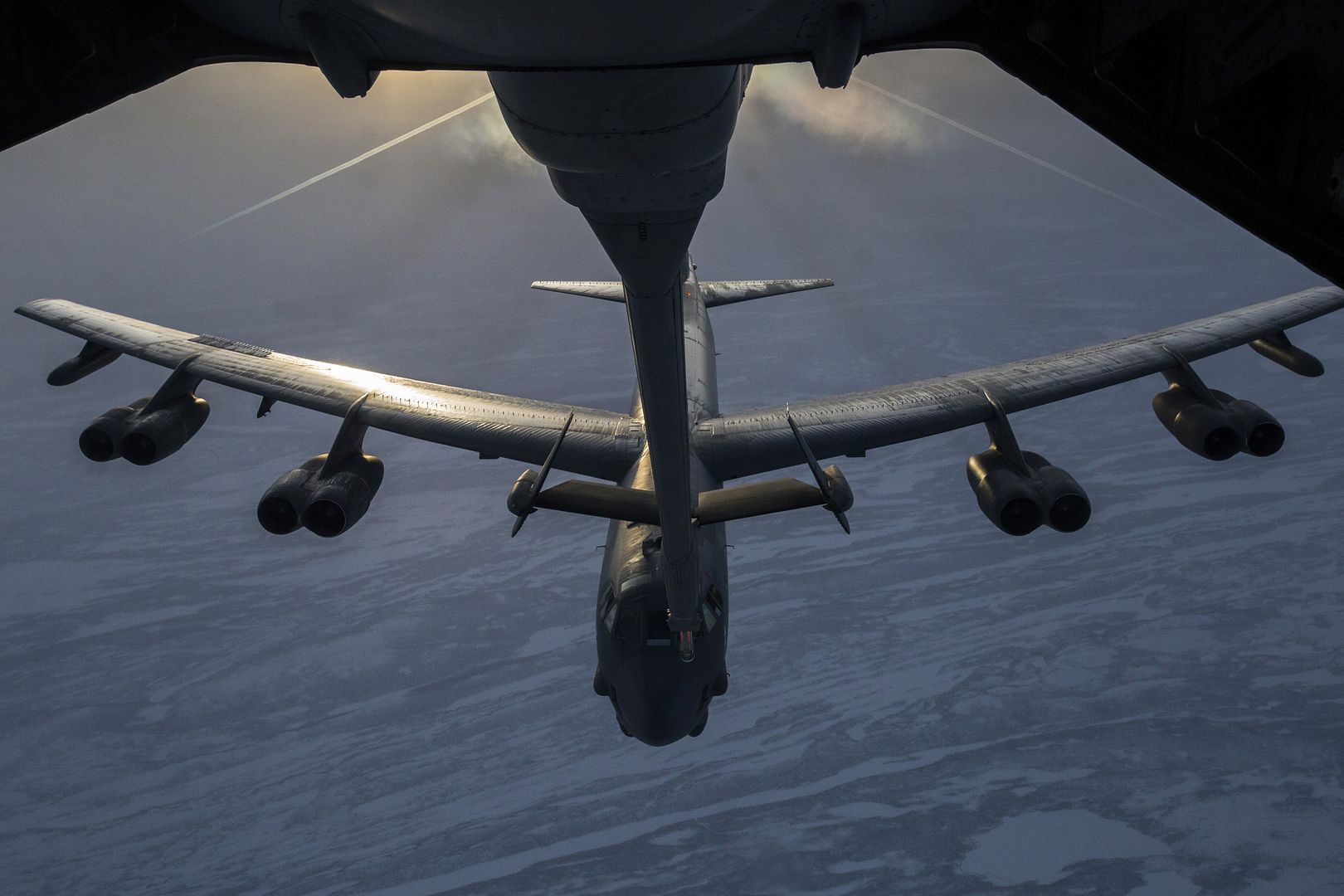

SEATTLE, Feb. 16, 2018 /PRNewswire/ -- Boeing [NYSE: BA] announced today that the 737 MAX 9 has received an amended type certificate (ATC) from the U.S. Federal Aviation Administration (FAA), officially certifying the airplane for commercial service.
Boeing's new 737 MAX 9 has received FAA certification and is now being prepped for first delivery. Paul Weatherman photo.
This certification marks the culmination of a successful flight test program that began in March 2017 with two Boeing flight test airplanes. The FAA certification affirms that the airplane's handling, systems and overall performance all comply with required aviation regulations.
"Our teams built superior capabilities into the MAX 9 and proved them all the way through flight test. We're looking forward to bringing this airplane to market for our valued customers," said Keith Leverkuhn, vice president and general manager of the 737 MAX program, Boeing Commercial Airplanes. "I am proud of the entire team for helping us reach another important development milestone."
Boeing is now in the final stages of preparing the MAX 9 for its first delivery to launch customer Lion Air Group.
The 737 MAX 9 is designed for a capacity of up to 220 passengers and a maximum range of 3,550 nautical miles. With three additional seat rows compared to the 737 MAX 8, this airplane provides operators added capacity while maximizing profitability within their network.
The 737 MAX family is designed to offer customers exceptional performance, with lower per-seat costs and an extended range that is opening up new destinations in the single-aisle market. The 737 MAX incorporates the latest CFM International LEAP-1B engines, Advanced Technology winglets, Boeing Sky Interior, large flight deck displays and other features to deliver the highest efficiency, reliability and passenger comfort in the single-aisle market.
The 737 MAX is the fastest-selling airplane in Boeing history, accumulating more than 4,300 orders from 93 customers worldwide. For more information and feature content, visit www.boeing.com/commercial/737max.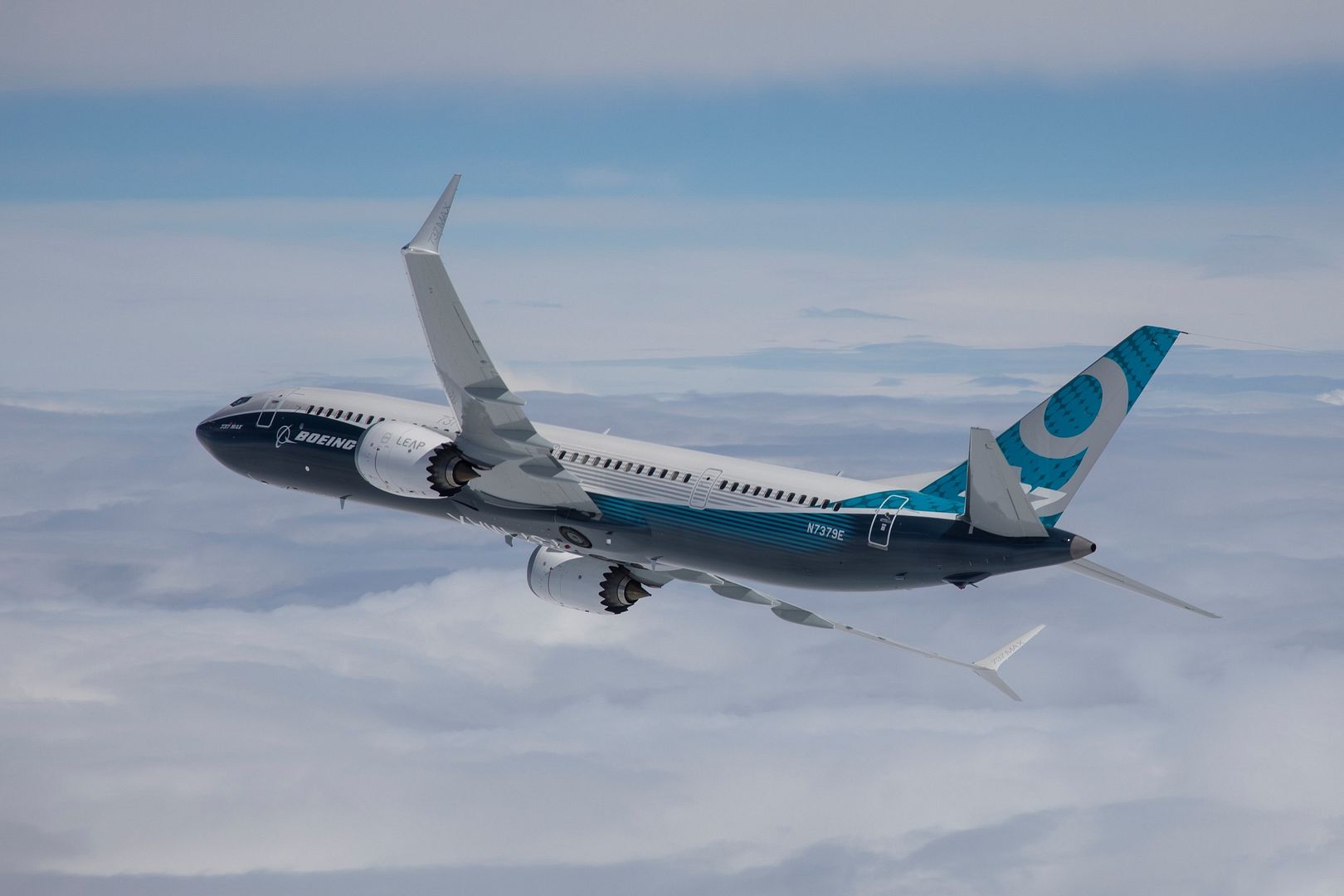
Post a reply
- Go to Next topic
- Go to Welcome
- Go to Introduce Yourself
- Go to General Discussion
- Go to Screenshots, Images and Videos
- Go to Off topic
- Go to Works in Progress
- Go to Skinning Tips / Tutorials
- Go to Skin Requests
- Go to IJAAF Library
- Go to Luftwaffe Library
- Go to RAF Library
- Go to USAAF / USN Library
- Go to Misc Library
- Go to The Ops Room
- Go to Made in Germany
- Go to Campaigns and Missions
- Go to Works in Progress
- Go to Juri's Air-Raid Shelter
- Go to Campaigns and Missions
- Go to Works in Progress
- Go to Skinpacks
- Go to External Projects Discussion
- Go to Books & Resources
